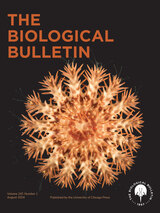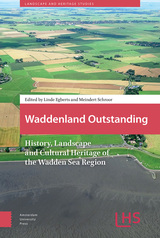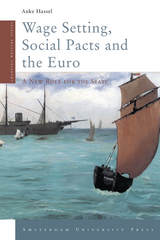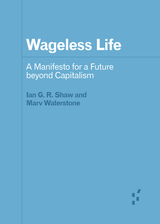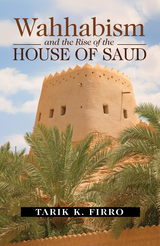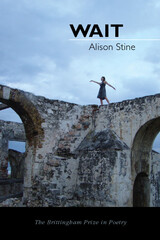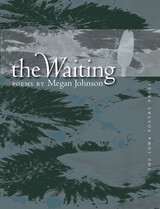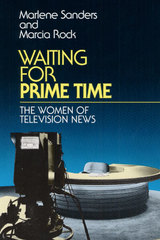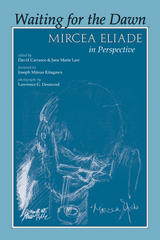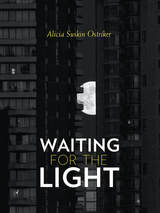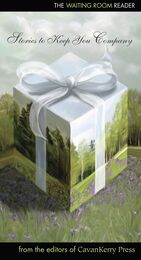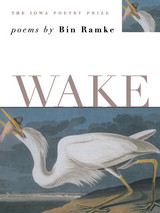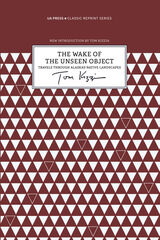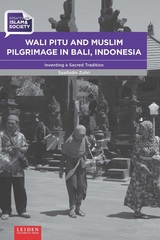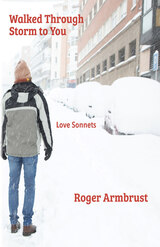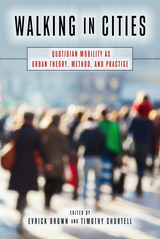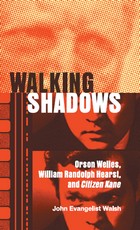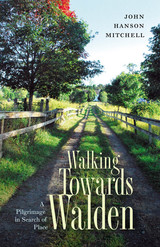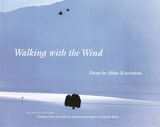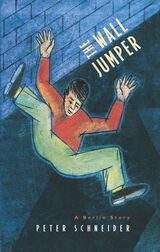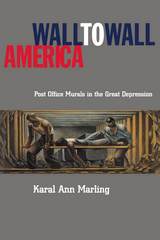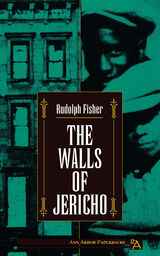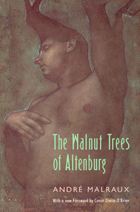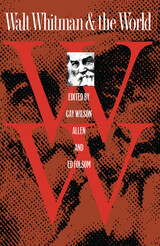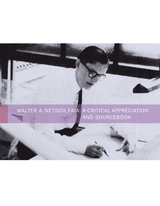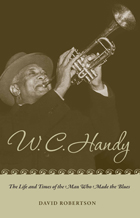 W. C. Handy: The Life and Times of the Man Who Made the Blues
David Robertson
University of Alabama Press, 2011 Normal0falsefalsefalseEN-USX-NONEX-NONEMicrosoftInternetExplorer4 David Robertson charts W. C. Handy’s rise from a rural-Alabama childhood in the last decades of the nineteenth century to his emergence as one of the most celebrated songwriters of the twentieth century. The child of former slaves, Handy was first inspired by spirituals and folk songs, and his passion for music pushed him to leave home as a teenager, despite opposition from his preacher father. Handy soon found his way to St. Louis, where he spent a winter sleeping on cobblestone docks before lucking into a job with an Indiana brass band. It was in a minstrel show, playing to racially mixed audiences across the country, that he got his first real exposure as a professional musician, but it was in Memphis, where he settled in 1905, that he hit his full stride as a composer. At once a testament to the power of song and a chronicle of race and black music in America, W. C. Handy’s life story is in many ways the story of the birth of our country’s indigenous culture—and a riveting must read for anyone interested in the history of American music.
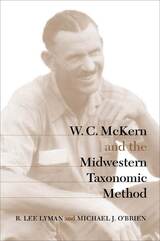 W. C. McKern and the Midwestern Taxonomic Method
Written by R. Lee Lyman and Michael J. O'Brien
University of Alabama Press, 2002 Explores W. C. McKern's use of Linnaean taxonomy as the model for development of a pottery classification system By the early 20th century, North American archaeologists had found evidence of a plethora of prehistoric cultures displaying disparate geographic and chronological distributions. But there were no standards or algorithms for specifying when a culture was distinct or identical to another in a nearby or distant region. Will Carleton McKern of the Milwaukee Public Museum addressed this fundamental problem of cultural classification beginning in 1929. He modeled his solution—known as the Midwestern Taxonomic Method—on the Linnaean biological taxonomy because he wanted the ability to draw historical and cultural "relationships" among cultures. McKern was assisted during development of the method by Carl E. Guthe, Thorne Deuel, James B. Griffin, and William Ritchie. This book studies the 1930s correspondence between McKern and his contemporaries as they hashed out the method's nuances. It compares the several different versions of the method and examines the Linnaean biological taxonomy as it was understood and used at the time McKern adapted it to archaeological problems. Finally, this volume reveals how and why the method failed to provide the analytical solution envisioned by McKern and his colleagues and how it influenced the later development of Americanist archaeology.
 W. E. B. Du Bois: Revolutionary Across the Color Line
Bill V. Mullen
Pluto Press, 2016 On the 27th August, 1963, the day before Martin Luther King electrified the world from the steps of the Lincoln Memorial with the immortal words, 'I Have a Dream', the life of another giant of the Civil Rights movement quietly drew to a close in Accra, Ghana: W.E.B. DuBois. In this new biography, Bill V. Mullen interprets the seismic political developments of the Twentieth Century through Du Bois’s revolutionary life.
Du Bois was born in Massachusetts in 1868, just three years after formal emancipation of America’s slaves. In his extraordinarily long and active political life, he would emerge as the first black man to earn a PhD from Harvard; surpass Booker T. Washington as the leading advocate for African American rights; co-found the NAACP, and involve himself in anti-imperialist and anti-colonial struggles across Asia and Africa. Beyond his Civil Rights work, Mullen also examines Du Bois's attitudes towards socialism, the USSR, China’s Communist Revolution, and the intersectional relationship between capitalism, poverty and racism.
An accessible introduction to a towering figure of American Civil Rights, perfect for anyone wanting to engage with Du Bois’s life and work.
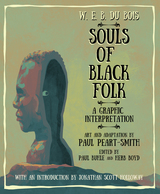 W. E. B. Du Bois Souls of Black Folk: A Graphic Interpretation
W. E. B. Du Bois (1868-1963)
Rutgers University Press, 2023 “The problem of the twentieth century is the problem of the color line.” These were the prescient words of W. E. B. Du Bois’s influential 1903 book The Souls of Black Folk. The preeminent Black intellectual of his generation, Du Bois wrote about the trauma of seeing the Reconstruction era’s promise of racial equality cruelly dashed by the rise of white supremacist terror and Jim Crow laws. Yet he also argued for the value of African American cultural traditions and provided inspiration for countless civil rights leaders who followed him. Now artist Paul Peart-Smith offers the first graphic adaptation of Du Bois’s seminal work.
Peart-Smith’s graphic adaptation provides historical and cultural contexts that bring to life the world behind Du Bois’s words. Readers will get a deeper understanding of the cultural debates The Souls of Black Folk engaged in, with more background on figures like Booker T. Washington, the advocate of black economic uplift, and the Pan-Africanist minister Alexander Crummell. This beautifully illustrated book vividly conveys the continuing legacy of The Souls of Black Folk, effectively updating it for the era of the 1619 Project and Black Lives Matter.
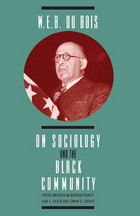 W. E. B. DuBois on Sociology and the Black Community
W. E. B. DuBois
University of Chicago Press, 1978 Historian, journalist, educator, and civil rights advocate W. E. B. Du Bois was perhaps most accomplished as a sociologist of race relations and of the black community in the United States. This volume collects his most important sociological writings from 1898 to 1910. The eighteen selections include five on Du Bois's conception of sociology and sociological research, especially as a tool in the struggle for racial justice; excerpts from studies of black communities in the South and the North, including The Philadelphia Negro; writings on black culture and social life, with a selection from The Negro American Family; and later works on race relations in the United States and elsewhere after World War II. This section includes a powerful fiftieth-anniversary reassessment of his classic 1901 article in the Atlantic in which he predicted that "the problem of the twentieth century is the problem of the color line."
The editors provide an annotated bibliography, a lengthy overview of Du Bois's life and work, and detailed introductions to the selections.
"The most significant contribution of this book is its inclusive look at Du Bois as both academic and activist. . . . Individuals interested in the study of social issues and political sociology would benefit from reading and discussing this book."—Paul Kriese, Sociology: Reviews of New Books
"Green and Driver, informing this volume with a 48-page essay that summarizes Du Bois' career and places him in the context of the profession, have intelligently organized his writings. . . . A welcome contribution that should have wide use."—Elliott Rudwick, Contemporary Sociology
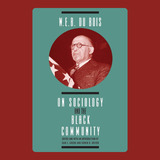 W. E. B. DuBois on Sociology and the Black Community
W. E. B. DuBois
University of Chicago Press, 1978 This is an auto-narrated audiobook version of this book.
Historian, journalist, educator, and civil rights advocate W. E. B. Du Bois was perhaps most accomplished as a sociologist of race relations and of the black community in the United States. This volume collects his most important sociological writings from 1898 to 1910. The eighteen selections include five on Du Bois's conception of sociology and sociological research, especially as a tool in the struggle for racial justice; excerpts from studies of black communities in the South and the North, including The Philadelphia Negro; writings on black culture and social life, with a selection from The Negro American Family; and later works on race relations in the United States and elsewhere after World War II. This section includes a powerful fiftieth-anniversary reassessment of his classic 1901 article in the Atlantic in which he predicted that "the problem of the twentieth century is the problem of the color line."
The editors provide an annotated bibliography, a lengthy overview of Du Bois's life and work, and detailed introductions to the selections.
"The most significant contribution of this book is its inclusive look at Du Bois as both academic and activist. . . . Individuals interested in the study of social issues and political sociology would benefit from reading and discussing this book."—Paul Kriese, Sociology: Reviews of New Books
"Green and Driver, informing this volume with a 48-page essay that summarizes Du Bois' career and places him in the context of the profession, have intelligently organized his writings. . . . A welcome contribution that should have wide use."—Elliott Rudwick, Contemporary Sociology
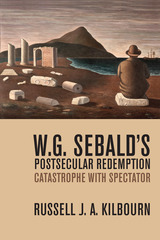 W. G. Sebald’s Postsecular Redemption: Catastrophe with Spectator
Russell J. A. Kilbourn
Northwestern University Press, 2018 Focusing on W. G. Sebald's four works of prose fiction—The Rings of Saturn, Vertigo, The Emigrants, and Austerlitz—Russell J. A. Kilbourn traces the author's abiding preoccupation with redemption in a world that has been described as postsecular. He shows that Sebald's work stands between modernism's ironic hopes for redemption and whatever comes after. Out of the spectacle of humankind's slow-motion self-destruction, a "Sebaldian subject"—masculine, melancholic, ironic, potentially queer-emerges across the four prose narratives.
Alongside Sebald studies' traditional subjects, which include memory, historiography, Sebald's critique of an image-based culture, and his highly intermedial poetics, W. G. Sebald's Postsecular Redemption demonstrates Sebald's relevance for affect theory, new materialism, and the posthuman turn. It critiques the possibility of metaphysical or eroto-salvific models of redemption, arguing against the temptation of psychoanalytic interpretations, as Sebald's work of memory rejects the discourse of redemption in favor of restitution.
In its consideration of Sebald's place in twentieth-century literature and after, Kilbourn's book engages with such predecessors as Nabokov, Kafka, Conrad, and Beckett, concluding with comparisons with contemporaries Claudio Magris and Alice Munro.
 W Stands for Women: How the George W. Bush Presidency Shaped a New Politics of Gender
Michaele L. Ferguson and Lori J. Marso, eds.
Duke University Press, 2007 Taking seriously the “W Stands for Women” rhetoric of the 2004 Bush–Cheney campaign, the contributors to this collection investigate how “W” stands for women. They argue that George W. Bush has hijacked feminist language toward decidedly antifeminist ends; his use of feminist rhetoric is deeply and problematically connected to a conservative gender ideology. While it is not surprising that conservative views about gender motivate Bush’s stance on so-called “women’s issues” such as abortion, what is surprising—and what this collection demonstrates—is that a conservative gender ideology also underlies a range of policies that do not appear explicitly related to gender, most notably foreign and domestic policies associated with the post-9/11 security state. Any assessment of the lasting consequences of the Bush presidency requires an understanding of the gender conservatism at its core. In W Stands for Women ten feminist scholars analyze various aspects of Bush’s persona, language, and policy to show how his administration has shaped a new politics of gender. One contributor points out the shortcomings of “compassionate conservatism,” a political philosophy that requires a weaker class to be the subject of compassion. Another examines Lynndie England’s participation in the abuse of prisoners at Abu Ghraib in relation to the interrogation practices elaborated in the Army Field Manual, practices that often entail “feminizing” detainees by stripping them of their masculine gender identities. Whether investigating the ways that Bush himself performs masculinity or the problems with discourse that positions non-Western women as supplicants in need of saving, these essays highlight the far-reaching consequences of the Bush administration’s conflation of feminist rhetoric, conservative gender ideology, and neoconservative national security policy. Contributors. Andrew Feffer, Michaele L. Ferguson, David S. Gutterman, Mary Hawkesworth, Timothy Kaufman-Osborn, Lori Jo Marso, Danielle Regan, R. Claire Snyder, Iris Marion Young, Karen Zivi Michaela Ferguson and Karen Zivi appeared on KPFA’s Against the Grain on September 11, 2007. Listen to the audio.
Michaela Ferguson and Lori Jo Marso appeared on WUNC’s The State of Things on August 30, 2007. Listen to the audio.
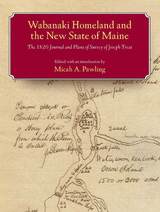 Wabanaki Homeland and the New State of Maine: The 1820 Journal and Plans of Survey of Joseph Treat
Micah A. Pawling
University of Massachusetts Press, 2007 In late September 1820, hoping to lay claim to territory then under dispute between Great Britain and the United States, Governor William King of the newly founded state of Maine dispatched Major Joseph Treat to survey public lands on the Penobscot and Saint John Rivers. Traveling well beyond the limits of colonial settlement, Treat relied heavily on the cultural knowledge and expertise of John Neptune, lieutenant governor of the Penobscot tribe, to guide him across the Wabanaki homeland. Along the way Treat recorded his daily experiences in a journal and drew detailed maps, documenting the interactions of the Wabanaki peoples with the land and space they knew as home.
Edited, annotated, and with an introduction by Micah Pawling, this volume includes a complete transcription of Treat's journal, reproductions of dozens of hand-drawn maps, and records pertaining to the 1820 treaty between the Penobscot Nation and the governing authorities of Maine. As Pawling points out, Treat's journal offers more than the observations of a state agent conducting a survey. It re-creates a dialogue between Euro-Americans and Native peoples, showing how different perceptions of the land were negotiated and disseminated, and exposing the tensions that surfaced when assumptions and expectations clashed. In large part because of Neptune's influence, the maps, in addition to detailing the location of Wabanaki settlements, reflect a river-oriented Native perspective that would later serve as a key to Euro-American access to the region's interior.
The groundwork for cooperation between Treat and Neptune had been laid during the 1820 treaty negotiations, in which both men participated and which were successfully concluded just over a month before their expedition departed from Bangor, Maine. Despite conflicting interests and mutual suspicions, they were able to work together and cultivate a measure of trust as they traveled across northern Maine and western New Brunswick, mapping an old world together while envisioning its uncertain future.
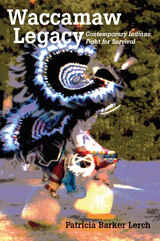 Waccamaw Legacy: Contemporary Indians Fight for Survival
Written by Patricia Lerch
University of Alabama Press, 2004 An insightful and informative look into the Waccamaw Siouan's quest for identity and survival Waccamaw Legacy: Contemporary Indians Fight for Survival sheds light on North Carolina Indians by tracing the story of the now state-recognized Waccamaw Siouan tribe from its beginnings in the Southeastern United States, through their first contacts with Europeans, and into the 21st century, detailing the struggles these Indians have endured over time. We see how the Waccamaw took hold of popular theories about Indian tribes like the Croatan of the Lost Colony and the Cherokee as they struggled to preserve their heritage and to establish their identity. Patricia Lerch was hired by the Waccamaw in 1981 to perform the research needed to file for recognition under the Bureau of Indian Affairs Federal Acknowledgement Program of 1978. The Waccamaw began to organize powwows in 1970 to represent publicly their Indian heritage and survival and to spread awareness of their fight for cultural preservation and independence. Lerch found herself understanding that the powwows, in addition to affirming identity, revealed important truths about the history of the Waccamaw and the ways they communicate and coexist. Waccamaw Legacy outlines Lerch’s experience as she played a vital role in the Waccamaw Siouan's continuing fight for recognition and acceptance in contemporary society and culture.
Waddenland Outstanding: History, Landscape and Cultural Heritage of the Wadden Sea Region
Edited by Linde Egberts and Meindert Schroor
Amsterdam University Press, 2019 The Wadden Sea Region is comprised of the embanked coastal marshes and islands in the Wadden Sea near Denmark, Germany, and the Netherlands. This area retains an exceptional common history in all its aspects: archaeologically, economically, socially, and culturally. Its settlement history of more than two thousand years is unrivalled and still mirrored in the landscape. Even though it has never constituted a political unity, it still shares a landscape and cultural heritage. For example, the approaches to water management and associated societal organization developed in the region during the last millennium have set significant world standards. This book offers an overview of current research on history, landscape and cultural heritage of the Wadden Sea region.
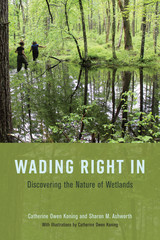 Wading Right In: Discovering the Nature of Wetlands
Catherine Owen Koning and Sharon M. Ashworth
University of Chicago Press, 2019 Where can you find mosses that change landscapes, salamanders with algae in their skin, and carnivorous plants containing whole ecosystems in their furled leaves? Where can you find swamp-trompers, wildlife watchers, marsh managers, and mud-mad scientists? In wetlands, those complex habitats that play such vital ecological roles.
In Wading Right In, Catherine Owen Koning and Sharon M. Ashworth take us on a journey into wetlands through stories from the people who wade in the muck. Traveling alongside scientists, explorers, and kids with waders and nets, the authors uncover the inextricably entwined relationships between the water flows, natural chemistry, soils, flora, and fauna of our floodplain forests, fens, bogs, marshes, and mires. Tales of mighty efforts to protect rare orchids, restore salt marshes, and preserve sedge meadows become portals through which we visit major wetland types and discover their secrets, while also learning critical ecological lessons.
The United States still loses wetlands at a rate of 13,800 acres per year. Such loss diminishes the water quality of our rivers and lakes, depletes our capacity for flood control, reduces our ability to mitigate climate change, and further impoverishes our biodiversity. Koning and Ashworth’s stories captivate the imagination and inspire the emotional and intellectual connections we need to commit to protecting these magical and mysterious places.
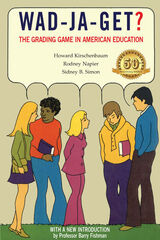 Wad-Ja-Get?: The Grading Game in American Education, 50th Anniversary Edition
Howard Kirschenbaum, Rodney Napier, and Sidney B. Simon; With a new introduction by Professor Barry Fishman
Michigan Publishing, 2020 Grades and grading are an accepted part of modern education. But why? Why do we accept a system that is more focused on ranking students than on learning? Why do we accept the negative effects of standard grading approaches, including turning students off from learning, increasing stress, creating winners and losers, and perpetuating racial and economic inequality? Why do we accept these things when there are better alternatives? Wad-Ja-Get? is a unique discussion of grading and its effects on students. The book was written by three education professors who have had first-hand contact with the problems of grading in all its forms. Written in the form of a novel, the topic is explored through the eyes of students, teachers, and parents in one high school embroiled in a controversy around grading. Possible alternatives to the grading system are examined in detail and the research on grading is summarized in an appendix. This 50th anniversary edition of the book includes a new introduction by Professor Barry Fishman, updating the research and setting the original book in the context of today’s educational and societal challenges. Wad-Ja-Get? remains timely five decades after its original publication, and will be inspiring to students, parents, educators, and policymakers.
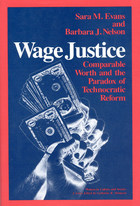 Wage Justice: Comparable Worth and the Paradox of Technocratic Reform
Sara M. Evans and Barbara N. Nelson
University of Chicago Press, 1991 "This pathbreaking study sets forth the history of attempts to implement pay equity and evaluates the hidden costs of achieving equity. With candor and intelligence, the authors clearly detail the political, organizational, and personal consequences of comparable worth reform strategies. Using extensive data from Minnesota, where pay equity has proceeded further than in any other state in the nation, as well as comparative information from other states and localities, the authors expose the crucial initial steps which define public policy.
"A perceptive and judicious analysis of comparable worth."—Wendy Kaminer, New York Times Book Review
"Very well-crafted. . . . Wage Justice has admirably launched the scholarly evaluation of pay equity, revealing the unforeseen complexities of this key feminist public policy innovation."—Maurine Weiner Greenwald, Journal of American History
"An insightful glimpse of the policy process."—Marian Lief Palley, American Political Science Review
Wage Setting, Social Pacts and the Euro: A New Role for the State
Anke Hassel
Amsterdam University Press, 2006 Politicians, economists, and social theorists tend to agree that globalization and neo-liberal economic policy have contributed to the decline of the social compacts underlying traditional European welfare states. Recently, however, social pacts have demonstrated an impressive resurgence, as governments across Europe facing necessary economic policy adjustments have chosen to view trade unions as vital negotiating partners rather than adversaries. Wage Setting, Social Pacts, and the Euro offers a theoretical understanding of the forces that have led to this new understanding, and of the challenges that increasing monetary integration will continue to pose.
Wageless Life: A Manifesto for a Future beyond Capitalism
Ian G. R. Shaw
University of Minnesota Press, 2019 Drawing up alternate ways to “make a living” beyond capitalism
To live in this world is to be conditioned by capital. Once paired with Western democracy, unfettered capitalism has led to a shrinking economic system that squeezes out billions of people—creating a planet of surplus populations. Wageless Life is a manifesto for building a future beyond the toxic failures of late-stage capitalism. Daring to imagine new social relations, new modes of economic existence, and new collective worlds, the authors provide skills and tools for perceiving—and living in— a post-capitalist future.
Forerunners: Ideas First
Short books of thought-in-process scholarship, where intense analysis, questioning, and speculation take the lead
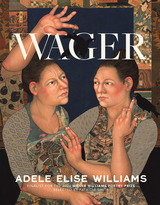 Wager
Adele Elise Williams
University of Arkansas Press, 2024 Wager, Adele Elise Williams’s raucous debut, celebrates the fearlessness and determination that can be wrested from strife. Early on, Williams confronts multiple challenges, both personal and communal, including persistent childhood anxieties and stunning neighborhood tragedies (“Ray down the street hung / himself like just-bought bananas needing time”). In the working-class communities she moves among, the poet tangles with her perceived failures as a wayward daughter, recovering addict, and skeptical scholar as she buries friends and lovers along the way. Self-possession is so hard-won in the southern gothic world of Williams’s poems, no wonder the speaker here is so roaringly audacious while often taking relish in getting close to the edge: “Sometimes God says YAHTZEE and I know this means / someone has won but someone has lost too — a holy man / is a gambling man, and that God of ours, / he takes bets after all.” Through it all, Williams pays homage to her lineage of resilient “beast women” and defiantly resists any constraint as she prods her own limits.
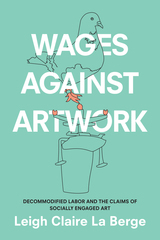 Wages Against Artwork: Decommodified Labor and the Claims of Socially Engaged Art
Leigh Claire La Berge
Duke University Press, 2019 The last twenty years have seen a rise in the production, circulation, and criticism of new forms of socially engaged art aimed at achieving social justice and economic equality. In Wages Against Artwork Leigh Claire La Berge shows how socially engaged art responds to and critiques what she calls decommodified labor—the slow diminishment of wages alongside an increase in the demands of work. Outlining the ways in which socially engaged artists relate to work, labor, and wages, La Berge examines how artists and organizers create institutions to address their own and others' financial precarity; why the increasing role of animals and children in contemporary art points to the turn away from paid labor; and how the expansion of MFA programs and student debt helps create the conditions for decommodified labor. In showing how socially engaged art operates within and against the need to be paid for work, La Berge offers a new theorization of the relationship between art and contemporary capitalism.
Wages and Economic Control in Norway, 1945–1957
Mark W. Leiserson
Harvard University Press Utilizing experience and information gained in more than ten years in Norway, the author presents an extensive body of empirical evidence on the difficulties of maintaining both price stability and free collective bargaining in a full employment economy. The first part of the book is devoted to an exploration of the course of wage policy and collective bargaining over wages, and the role these decisions played in determining the actual development of money wage levels. The second half consists of a detailed analysis of the relation between wage developments and the price level, the share of labor in national issues, the rate of capital formation, and the allocation of manpower within the economy.
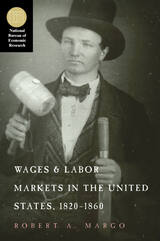 Wages and Labor Markets in the United States, 1820-1860
Robert A. Margo
University of Chicago Press, 1999 Research by economists and economic historians has greatly expanded our knowledge of labor markets and real wages in the United States since the Civil War, but the period from 1820 to 1860 has been far less studied. Robert Margo fills this gap by collecting and analyzing the payroll records of civilians hired by the United States Army and the 1850 and 1860 manuscript federal Censuses of Social Statistics. New wage series are constructed for three occupational groups—common laborers, artisans, and white-collar workers—in each of the four major census regions—Northeast, Midwest, South Atlantic, and South Central—over the period 1820 to 1860, and also for California between 1847 and 1860. Margo uses these data, along with previously collected evidence on prices, to explore a variety of issues central to antebellum economic development.
This volume makes a significant contribution to economic history by presenting a vast amount of previously unexamined data to advance the understanding of the history of wages and labor markets in the antebellum economy.
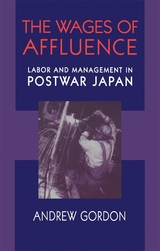 The Wages of Affluence: Labor and Management in Postwar Japan
Andrew Gordon
Harvard University Press, 2001 Andrew Gordon goes to the core of the Japanese enterprise system, the workplace, and reveals a complex history of contest and confrontation. The Japanese model produced a dynamic economy which owed as much to coercion as to happy consensus. Managerial hegemony was achieved only after a bitter struggle that undermined the democratic potential of postwar society. The book draws on examples across Japanese industry, but focuses in depth on iron and steel. This industry was at the center of the country's economic recovery and high-speed growth, a primary site of corporate managerial strategy and important labor union initiatives.
Beginning with the Occupation reforms and their influence on the workplace, Gordon traces worker activism and protest in the 1950s and '60s, and how they gave way to management victory in the 1960s and '70s. He shows how working people had to compromise institutions of self-determination in pursuit of economic affluence. He illuminates the Japanese system with frequent references to other capitalist nations whose workplaces assumed very different shape, and looks to Japan's future, rebutting hasty predictions that Japanese industrial relations are about to be dramatically transformed in the American free-market image. Gordon argues that it is more likely that Japan will only modestly adjust the status quo that emerged through the turbulent postwar decades he chronicles here.
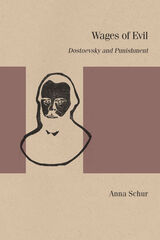 Wages of Evil: Dostoevsky and Punishment
Anna Schur
Northwestern University Press, 2012 Dostoevsky’s views on punishment are usually examined through the prism of his Christian commitments. For some, this means an orientation toward mercy; for others, an affirmation of suffering as a path to redemption. Anna Schur incorporates sources from philosophy, criminology, psychology, and history to argue that Dostoevsky’s thinking about punishment was shaped not only by his Christian ethics but also by the debates on penal theory and practice unfolding during his lifetime.
As Dostoevsky attempts to balance the various ethical and cultural imperatives, he displays ambivalence both about punishment and about mercy. This ambivalence, Schur argues, is further complicated by what Dostoevsky sees as the unfathomable quality of the self, which hinders every attempt to match crimes with punishments. The one certainty he holds is that a proper response to wrongdoing must include a concern for the wrongdoer’s moral improvement.
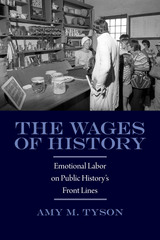 The Wages of History: Emotional Labor on Public History's Front Lines
Amy M. Tyson
University of Massachusetts Press, 2013 Anyone who has encountered costumed workers at a living history museum may well have wondered what their jobs are like, churning butter or firing muskets while dressed in period clothing. In The Wages of History, Amy Tyson enters the world of the public history interpreters at Minnesota's Historic Fort Snelling to investigate how they understand their roles and experience their daily work. Drawing on archival research, personal interviews, and participant observation, she reframes the current discourse on history museums by analyzing interpreters as laborers within the larger service and knowledge economies.
Although many who are drawn to such work initially see it as a privilege—an opportunity to connect with the public in meaningful ways through the medium of history—the realities of the job almost inevitably alter that view. Not only do interpreters make considerable sacrifices, both emotional and financial, in order to pursue their work, but their sense of special status can lead them to avoid confronting troubling conditions on the job, at times fueling tensions in the workplace.
This case study also offers insights—many drawn from the author's seven years of working as an interpreter at Fort Snelling—into the way gendered roles and behaviors from the past play out among the workers, the importance of creative autonomy to historical interpreters, and the ways those on public history's front lines both resist and embrace the site's more difficult and painful histories relating to slavery and American Indian genocide.
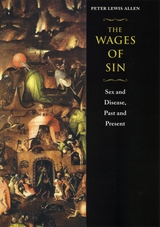 The Wages of Sin: Sex and Disease, Past and Present
Peter Lewis Allen
University of Chicago Press, 2000 Near the end of the century, a new and terrifying disease arrives suddenly from a distant continent. Infecting people through sex, it storms from country to country, defying all drugs and medical knowledge. The deadly disease provokes widespread fear and recrimination; medical authorities call the epidemic "the just rewards of unbridled lust"; a religious leader warns that "God has raised up new diseases against debauchery." The time was the 1490s; the place, Europe; the disease, syphilis; and the religious leader was none other than John Calvin.
Throughout history, Western society has often viewed sickness as a punishment for sin. It has failed to prevent and cure diseases—especially diseases tied to sex—that were seen as the retribution of a wrathful God. The Wages of Sin, the remarkable history of these diseases, shows how society's views of particular afflictions often heightened the suffering of the sick and substituted condemnation for care. Peter Allen moves from the medieval diseases of lovesickness and leprosy through syphilis and bubonic plague, described by one writer as "a broom in the hands of the Almighty, with which He sweepeth the most nasty and uncomely corners of the universe." More recently, medical and social responses to masturbation in the eighteenth and nineteenth centuries and AIDS in the twentieth round out Allen's timely and erudite study of the intersection of private morality and public health. The Wages of Sin tells the fascinating story of how ancient views on sex and sin have shaped, and continue to shape, religious life, medical practice, and private habits.
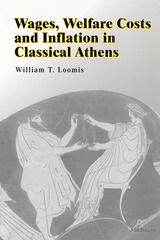 Wages, Welfare Costs and Inflation in Classical Athens
William T. Loomis
University of Michigan Press, 1999 William T. Loomis examines all surviving Athenian wages, salaries, welfare payments and other labor costs to determine what people really were paid for various kinds of work and allowances. These determinations, in turn, enable the author to cast a new and authoritative light on three controversial questions: Was there a "standard wage" in Athens? Were there periods of inflation and deflation? Did Athenians have an "embedded" or a "market" economy?
Individual chapters critically examine each surviving wage or other payment in thirteen job categories, including public office holders; soldiers and sailors; priests, oracles, and seers; overseers, architects, and other salaried construction personnel; and prostitutes and pimps. Three additional chapters then consider whether there was a "standard wage," inflation and deflation in Athens, and the implications of these conclusions for the hotly debated question about the nature of the Athenian economy.
This is the first comprehensive study of Athenian labor and welfare costs since August Böckh's Die Staatshaushaltung der Athener (1886). An updated critical study has been much needed, to take account of the greatly expanded evidence (Aristotle's Constitution of the Athenians, more than a dozen other papyrus texts and hundreds of inscriptions), and the uneven quality of the sources. This collection allows William T. Loomis to argue--contrary to prevailing scholarly opinion--that there never was a "standard wage" at Athens.
"This volume will be a significant contribution to all studies of ancient Greek civilization." --Alan L. Boegehold, Brown University
William Loomis is Visiting Professor of Classics, University of Michigan.
 Waging War on War: Peacefighting in American Literature
Giorgio Mariana
University of Illinois Press, 2015 The notion that war plays a fundamental role in the United States' idea of itself obscures the rich--and by no means naïve--seam of anti-war thinking that winds through American culture. Non-violent resistance, far from being a philosophy of passive dreamers, instead embodies Ralph Waldo Emerson's belief that peace "can never be defended, never be executed, by cowards." Giorgio Mariani rigorously engages with the essential question of what makes a text explicitly anti-war. Ranging from Emerson and Joel Barlow to Maxine Hong Kingston and Tim O'Brien, Waging War on War explores why sustained attempts at identifying the anti-war text's formal and philosophical features seem to always end at an impasse. Mariani moves a step beyond to construct a theoretical model that invites new inquiries into America's nonviolent, nonconformist tradition even as it challenges the ways we study U.S. warmaking and the cultural reactions to it. In the process, he shows how the ideal of nonviolence and a dislike of war have been significant, if nonhegemonic, features of American culture since the nation's early days. Ambitious and nuanced, Waging War on War at last defines anti-war literature while exploring the genre's role in an assertive peacefighting project that offered--and still offers--alternatives to violence.
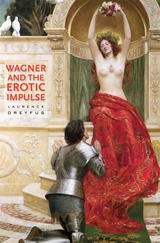 Wagner and the Erotic Impulse
Laurence Dreyfus
Harvard University Press, 2012 Though his image is tarnished today by unrepentant anti-Semitism, Richard Wagner (1813–1883) was better known in the nineteenth century for his provocative musical eroticism. In this illuminating study of the composer and his works, Laurence Dreyfus shows how Wagner’s obsession with sexuality prefigured the composition of operas such as Tannhäuser, Die Walküre, Tristan und Isolde, and Parsifal. Daring to represent erotic stimulation, passionate ecstasy, and the torment of sexual desire, Wagner sparked intense reactions from figures like Baudelaire, Clara Schumann, Nietzsche, and Nordau, whose verbal tributes and censures disclose what was transmitted when music represented sex.
Wagner himself saw the cultivation of an erotic high style as central to his art, especially after devising an anti-philosophical response to Schopenhauer’s “metaphysics of sexual love.” A reluctant eroticist, Wagner masked his personal compulsion to cross-dress in pink satin and drench himself in rose perfumes while simultaneously incorporating his silk fetish and love of floral scents into his librettos. His affection for dominant females and surprising regard for homosexual love likewise enable some striking portraits in his operas. In the end, Wagner’s achievement was to have fashioned an oeuvre which explored his sexual yearnings as much as it conveyed—as never before—how music could act on erotic impulse.
 Wagner Handbook
Ulrich Müller
Harvard University Press, 1992 Rarely has anyone in the history of Western culture stirred up such deep, contrary, and enduring passions as Richard Wagner. A proposal to perform his work ignites controversy in Israel. Wagner’s The Ride of the Valkyries blares from helicopters slicing the air of Apocalypse Now. His name leads a list of Germany’s spiritual heroes against a flaming backdrop in Anselm Kiefer’s largest work. Idolized by Nietzsche, appropriated by Hitler, defended by writers from Mann to Adorno, emulated by countless composers, interpreted by artists and filmmakers, Wagner has left us a legacy as complicated as it is profound. To this day the sheer magnitude of his accomplishment retains its power to overwhelm.
This book is a measure of that magnitude, an unprecedented attempt to bring together in one volume what is known about the composer’s life, his work, and his influence. Unparalleled in its scope and depth, this remarkable compendium offers readers a unique opportunity to understand what this prodigious man has meant to the Western world. Described by Brahms as a man of “colossal industry and horrendous energy,” Wagner composed dozens of works, many of them towering masterpieces; he influenced a whole generation of conductors, took part in a revolution, counseled kings and diplomats, and organized the building of the Bayreuth festival theater. His writings on a wide variety of subjects fill sixteen substantial volumes and his thousands of personal letters document a wildly eventful private life.
The Wagner Handbook addresses all of these aspects of the composer’s life and achievement. Central chapters include an account of Wagner’s place in music history by Carl Dahlhaus; Werner Breig’s treatment of individual musical works; Peter Wapnewski’s discussion of Wagner’s operatic works as literature; Isolde Vetter’s chapter on Wagner in the history of psychology; surveys of performance question over the years by Jens Malte Fischer and Oswal Bauer. These and other topics—the individuals who most powerfully influenced the composer and those he influenced, his impact on music history, and the political exploitation of his ideas—are masterfully drawn.
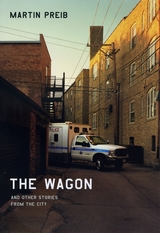 The Wagon and Other Stories from the City
Martin Preib
University of Chicago Press, 2010 Martin Preib is an officer in the Chicago Police Department—a beat cop whose first assignment as a rookie policeman was working on the wagon that picks up the dead. Inspired by Preib’s daily life on the job, The Wagon and Other Stories from the City chronicles the outer and inner lives of both a Chicago cop and the city itself. The book follows Preib as he transports body bags, forges an unlikely connection with his female partner, trains a younger officer, and finds himself among people long forgotten—or rendered invisible—by the rest of society. Preib recounts how he navigates the tenuous labyrinths of race and class in the urban metropolis, such as a domestic disturbance call involving a gang member and his abused girlfriend or a run-in with a group of drunk yuppies. As he encounters the real and imagined geographies of Chicago, the city reveals itself to be not just a backdrop, but a central force in his narrative of life and death. Preib’s accounts, all told in his breathtaking prose, come alive in ways that readers will long remember.
Wahhabism and the Rise of the House of Saud
Tarik Firro
Sussex Academic Press, 2022 This book examines the role of Muhammad Ibn Abd al-Wahhab (1703-1792) and his successors in reconsolidating the religious principles of Wahhabism. It explains the role of the Saudi princes in crystallizing the core of the Saudi-Wahhabi political entity within their tribal society. Discussion focuses on the first and second generations of Wahhabi scholars who maintained the Wahhabi creed with great success, keeping its hegemony as the main doctrine in Saudi Arabia. The focus on the role of Wahhabi scholars in the nineteenth century sheds new lights on the principles of continuity and discontinuity in the historical development of Saudi political entities and explains the origin of the modern Saudi State. Although major socio-economic and cultural change is now taking place under the leadership of Prince Muhammad ibn Salman, the main religious structures of the state remain firmly in place.
 Wahine Volleyball: 40 Years Coaching Hawaiʻi`s Team
Dave Shoji with Ann Miller
University of Hawaii Press, 2015 Dave Shoji, legendary coach for the University of Hawai`i women’s volleyball program, looks back at four decades of coaching to tell his story along with that of the Rainbow Wahine, four-time national champions and consistently among the top-ranked teams in college sports. With the assistance of longtime beat writer Ann Miller, Shoji provides an exclusive look at the state’s perennially successful athletic team. His memoir traces the history and rise of the program—from 1975, when he was hired as a part-time coach by women’s athletic director Donnis Thompson and matches were held in the “sweatbox” of Klum Gym; through the late 1970s and the 1980s, which saw the start of the Booster Club and excitement of playing in front of sell-out crowds at Honolulu’s Blaisdell Arena; into the 1990s with the team’s move to its current home at the Stan Sheriff Center, attracting the sport’s largest and most devoted following; to the landmark 2013 season when Shoji became the winningest coach in NCAA history and on his way to a fortieth year with the Rainbow Wahine program.
Interviews with memorable players, family, and assistant and rival coaches, together with over 100 action photos—plus twenty more in a color insert—bring back both thrilling and poignant memories of the greatest moments of Rainbow Wahine volleyball. The comprehensive yearly statistics, full player rosters, and handy index make the book a needed reference for trivia buffs. A keepsake for fans and players alike, Wahine Volleyball: 40 Years Coaching Hawai`i’s Team will delight any sports enthusiast as well as readers who enjoy first-person remembrances of what makes Hawai`i unique.
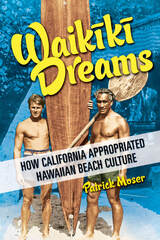 Waikiki Dreams: How California Appropriated Hawaiian Beach Culture
Patrick Moser
University of Illinois Press, 2024 Despite a genuine admiration for Native Hawaiian culture, white Californians of the 1930s ignored authentic relationships with Native Hawaiians. Surfing became a central part of what emerged instead: a beach culture of dressing, dancing, and acting like an Indigenous people whites idealized. Patrick Moser uses surfing to open a door on the cultural appropriation practiced by Depression-era Californians against a backdrop of settler colonialism and white nationalism. Recreating the imagined leisure and romance of life in Waikīkī attracted people buffeted by economic crisis and dislocation. California-manufactured objects like surfboards became a physical manifestation of a dream that, for all its charms, emerged from a white impulse to both remove and replace Indigenous peoples. Moser traces the rise of beach culture through the lives of trendsetters Tom Blake, John “Doc” Ball, Preston “Pete” Peterson, Mary Ann Hawkins, and Lorrin “Whitey” Harrison while also delving into California’s control over images of Native Hawaiians via movies, tourism, and the surfboard industry. Compelling and innovative, Waikīkī Dreams opens up the origins of a defining California subculture.
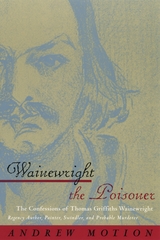 Wainewright the Poisoner: The Confessions of Thomas Griffiths Wainewright
Andrew Motion
University of Chicago Press, 2001 Andrew Motion brings all his lyricism and inventiveness to bear in this fictional autobiography of the great swindler, Thomas Griffiths Wainewright. A painter, writer, and friend of Blake, Byron, and Keats, Wainewright was almost certainly a murderer. When he died in a penal colony in Tasmania, he left behind fragments of documents and a beguiling legend which Motion uses to create an imagined confession laced with facts, telling the story as no straightforward history could.
"Thomas Griffiths Wainewright is a dream subject for either novelist or biographer. . . . Andrew Motion, Britain's poet laureate, clearly felt that neither straight biography nor pure fiction would do Wainewright's complexities justice, and so he combined the two genres. The result is stunning. The central voice is that of Wainewright himself, reflecting back on his life. After each chapter Mr. Motion has added detailed notes that inform and flesh out the narrative, giving not only his own informed opinion of Wainewright's actions but also those of Wainewright's contemporaries and the scholars and writers who have studied him over the past two centuries."—Lucy Moore, Washington Times
"Brilliantly innovative, gripping, intricately researched, Motion's biography does justice to its subject at last."—John Carey, The Sunday Times
"Engaging and convincing. . . . The trajectory of this character-from neglected and resentful child to arrogant and envious London dandy to sociopathic murderer on to an enfeebled, frightened prisoner-is indelibly imagined and drawn."—Edmund White, Financial Times
"[A] fascinating look at an evil artist, a charmer still having his way with us. We can hear him being economical with the truth, telling us and himself just what he wants to hear."—Michael Olmert, New Jersey Star Ledger
"Motion crafts a fascinating tale as complex and compelling as if Wainewright himself had written it."—Michael Spinella, Booklist
"Did he kill his servant, and possibly others as well? . . . The footnotes seem to say yes, but Wainewright adamantly argues his own case. Motion's prose is flawless, and Wainewright's voice is convincing. But in the long run, it's this ambiguity that makes Wainewright the Poisoner a fascinating and memorable read."—R.V. Schelde, Sacramento News and Review
"Who could as for a better Romantic villain than Thomas Griffiths Wainewright? . . . [The book] succeeds on many levels: as an act of ventriloquism, a work of scholarship, a psychological study, as a set of sharp portraits of famous men and an engrossing read. . . ."—Polly Shulman, Newsday
"Instead of a straightforward biography, Andrew Motion gives us Wainewright's first person, fictionalized "confession."—a document as circumspect, slyly reticent, and oeaginously smooth as the man himself. Splendid."—John Banville, Literary Review
"A genuine tour de force, and on a non-fictional level, a telling portrait of a strange, intriguing and repellant man."—Brian Fallon, Irish Times
"A marvelous literary hybrid that totters with one foot in the world of nonfiction, the other in the land of make-believe. One is alternatively swept up in Motion's dizzy imaginative pastiche, or sent crashing into a dusty stack of scholarly cogitations. . . ."—Philadelphia Inquirer
"As true a portrait of a liar as its subject could wish. Rich and strange. . . ."—Glasgow Herald
Wait
Alison Stine
University of Wisconsin Press, 2011 In a small town under a spell, a child bride prays for the sheriff’s gun. Iron under a bed stops a nightmare. The carousel artist can carve only birds. Part fairy tale and part gothic ballad, Wait spans a single year: the year before a young woman’s marriage. Someone is always watching—from the warehouse, from the woods. And on the outskirts of town, someone new is waiting.
The Waiting
Johnson, Megan
University of Iowa Press, 2005 In a startling and original poetic voice, Megan Johnson in The Waiting reveals a vigilant young person who has suffered an unmentionable loss and who dismantles and reconstitutes lyric modes in a relentless search for solace. A lyric adventure of grief and search, The Waiting reinvents language from raw materials, driven by intense emotional need.
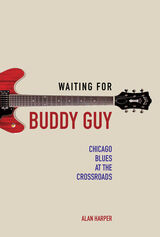 Waiting for Buddy Guy: Chicago Blues at the Crossroads
Alan Harper
University of Illinois Press, 2016 In the late 1970s and early 1980s, British blues fan Alan Harper became a transatlantic pilgrim to Chicago. "I've come here to listen to the blues," he told an American customs agent at the airport, and listen he did, to the music in its many styles, and to the men and women who lived it in the city's changing blues scene. Harper's eloquent memoir conjures the smoky redoubts of men like harmonica virtuoso Big Walter Horton and pianist Sunnyland Slim. Venturing from stageside to kitchen tables to the shotgun seat of a 1973 Eldorado, Harper listens to performers and others recollect memories of triumphs earned and chances forever lost, of deep wells of pain and soaring flights of inspiration. Harper also chronicles a time of change, as an up-tempo, whites-friendly blues eclipsed what had come before, and old Southern-born black players held court one last time before an all-conquering generation of young guitar aces took center stage.
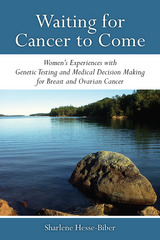 Waiting for Cancer to Come: Women’s Experiences with Genetic Testing and Medical Decision Making for Breast and Ovarian Cancer
Sharlene Hesse-Biber
University of Michigan Press, 2014 Waiting for Cancer to Come tells the stories of women who are struggling with their high risk for cancer. Based on interviews and surveys of dozens of women, this book pieces together the diverse yet interlocking experiences of women who have tested positive for the BRCA 1/2 gene mutations, which indicate a higher risk of developing breast and ovarian cancer. Sharlene Hesse-Biber brings these narratives to light and follows women’s journeys from deciding to get screened for BRCA, to learning the test has come back positive, to dealing with their risk. Many women already know the challenges of a family history riddled with cancer and now find themselves with the devastating knowledge of their own genetic risk. Using the voices of the women themselves to describe the under-explored BRCA experience, Waiting for Cancer to Come looks at the varied emotional, social, economic, and psychological factors at play in women’s decisions about testing and cancer prevention.
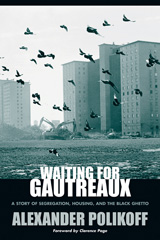 Waiting for Gautreaux: A Story of Segregation, Housing, and the Black Ghetto
Alexander Polikoff
Northwestern University Press, 2007 Winner, 2006 The American Lawyer Lifetime Achievement Award
On his thirty-ninth birthday in 1966, Alexander Polikoff, a volunteer ACLU attorney and partner in a Chicago law firm, met some friends to discuss a pro bono case. Over lunch, the four talked about the Chicago Housing Authority construction program. All the new public housing, it seemed, was going into black neighborhoods. If discrimination was prohibited in public schools, wasn't it also prohibited in public housing?
And so began Gautreaux v. CHA and HUD, a case that from its rocky beginnings would roll on year after year, decade after decade, carrying Polikoff and his colleagues to the nation's Supreme Court (to face then-solicitor general Robert Bork); establishing precedents for suits against the discriminatory policies of local housing authorities, often abetted by HUD; and setting the stage for a nationwide experiment aimed at ending the concentration--and racialization--of poverty through public housing. Sometimes Kafkaesque, sometimes simply inspiring, and never less than absorbing, the story of Gautreaux, told by its principal lawyer, moves with ease through local and national civil rights history, legal details, political matters, and the personal costs--and rewards--of a commitment to fairness, equality, and justice. Both the memoir of a dedicated lawyer, and the narrative of a tenacious pursuit of equality, this story--itself a critical, still-unfolding chapter in recent American history--urges us to take an essential step in ending the racial inequality that Alexis de Toqueville prophetically named America's "most formidable evil."
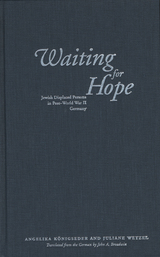 Waiting for Hope: Jewish Displaced Persons in Post-World War II Germany
Angelika Konigseder
Northwestern University Press, 2001 After the defeat of Germany in World War II, more than a hundred thousand Jewish survivors of the Holocaust were transported to camps maintained by the allies for displaced persons (DPs). In this new history, historians Angelika Königseder and Juliane Wetzel offer a social and cultural history of the post-WWII displaced persons camps.
Starting with the discovery of death camps by Allied forces, Königseder and Wetzel describe the inadequate preparations made for the survivors. The soldiers were ill equipped to deal with the physical wreckage and mental anguish of their charges, but American rabbis soon arrived to perform invaluable work helping the survivors cope. The historians also devote attention to autonomous Jewish life in and near the camps: theater groups and orchestras prospered, schools were founded, a tuberculosis hospital and clinic for DPs was established, and underground organizations handled illegal immigration to Israel and trained soldiers to fight in Palestine.
Drawing on original documents and the work of other historians, Waiting for Hope sheds light on a largely unknown period in postwar Jewish history and shows that the suffering of the survivors did not end with the war.
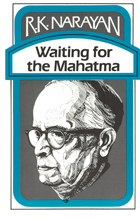 Waiting for Mahatma
R. K. Narayan
University of Chicago Press, 1955 "R.K. Narayan . . . has been compared to Gogol in England, where he has acquired a well-deserved reputation. The comparison is apt, for Narayan, an Indian, is a writer of Gogol's stature, with the same gift for creating a provincial atmosphere in a time of change. . . . One is convincingly involved in this alien world without ever being aware of the technical devices Narayan so brilliantly employs."—Anthony West, The New Yorker
"The experience of reading one of his novels is . . . comparable to one's first reaction to the great Russian novels: the fresh realization of the common humanity of all peoples, underlain by a simultaneous sense of strangeness—like one's own reflection seen in a green twilight."—Margaret Parton, New Herald Tribune Book Review
"The hardest of all things for a novelist to communicate is the extraordinary ordinariness of most human happiness. . . . Jane Austen, Soseki, Chekhov: a few bring it off. Narayan is one of them."—Francis King, Spectator
"The novels of R.K. Narayan are the best I have read in any language for a long time."—Amit Roy, Daily Telegraph
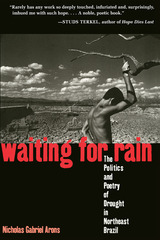 Waiting for Rain: The Politics and Poetry of Drought in Northeast Brazil
Nicholas Gabriel Arons
University of Arizona Press, 2004 When droughts hit northeastern Brazil, thousands of rural workers are forced to abandon their homes for the cities in search of work. The double impact of drought and corruption—with politicians taking advantage of drought to buy votes and pilfer government accounts—contributes to an endless cycle of human suffering.
In order to understand the impact of drought and the phenomenon of drought politics, Nicholas Gabriel Arons goes beyond traditional social-science scholarship to sources such as novels, poetry, popular art, and oral history. For many people in the region, these artistic renditions of life are, ironically, a better reflection of reality than political rhetoric, government archives, and newspaper accounts—even though they are infused with myth or hyperbole.
Drawing on interviews with artists and poets and on his own experiences in the Brazilian Northeast, Arons has written a poignant account of how drought has impacted the region’s culture. He intertwines ecological, social, and political issues with the words of some of Brazil’s most prominent authors and folk poets to show how themes surrounding drought—hunger, migration, endurance, nostalgia for the land—have become deeply embedded in Nordeste identity. Through this tapestry of sources, Arons shows that what is often thought of as a natural phenomenon is actually the result of centuries of social inequality, political corruption, and unsustainable land use.
Waiting for Rain dramatically depicts a region still suffering from austere social and political realities, where drought—even during rainy seasons—is ubiquitous in the hearts and minds of its residents. A book of hope and resistance, myth and reality, and suffering and salvation, it is also a personal narrative of self-discovery, tracing a young man’s struggle to understand how human tragedy on a grand scale can exist alongside natural beauty.
 Waiting for Robots: The Hired Hands of Automation
Antonio A. Casilli
University of Chicago Press, 2025 An essential investigation that pulls back the curtain on automation, like AI, to show human workers’ hidden labor.
Artificial Intelligence fuels both enthusiasm and panic. Technologists are inclined to give their creations leeway, pretend they’re animated beings, and consider them efficient. As users, we may complain when these technologies don’t obey, or worry about their influence on our choices and our livelihoods. And yet, we also yearn for their convenience, see ourselves reflected in them, and treat them as something entirely new. But when we overestimate the automation of these tools, award-winning author Antonio A. Casilli argues, we fail to recognize how our fellow humans are essential to their efficiency. The danger is not that robots will take our jobs, but that humans will have to do theirs.
In this bracing and powerful book, Casilli uses up-to-the-minute research to show how today’s technologies, including AI, continue to exploit human labor—even ours. He connects the diverse activities of today’s tech laborers: platform workers, like Uber drivers and Airbnb hosts; “micro workers,” including those performing atomized tasks like data entry on Amazon Mechanical Turk; and the rest of us, as we evaluate text or images to show we’re not robots, react to Facebook posts, or approve or improve the output of generative AI. As Casilli shows us, algorithms, search engines, and voice assistants wouldn’t function without unpaid or underpaid human contributions. Further, he warns that if we fail to recognize this human work, we risk a dark future for all human labor.
Waiting for Robots urges us to move beyond the simplistic notion that machines are intelligent and autonomous. As the proverbial Godot, robots are the bearers of a messianic promise that is always postponed. Instead of bringing prosperity for all, they discipline the workforce, so we don’t dream of a world without drudgery and exploitation. Casilli’s eye-opening book makes clear that most “automation” requires human labor—and likely always will—shedding new light on today’s consequences and tomorrow’s threats of failing to recognize and compensate the “click workers” of today.
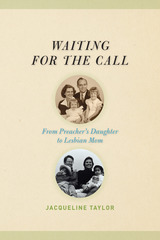 Waiting for the Call: From Preacher's Daughter to Lesbian Mom
Jacqueline Taylor
University of Michigan Press, 2007 “Well-written, absorbing, and a great pleasure to read . . . will appeal to Christians struggling to square their traditional beliefs with acceptance of homosexuality as well as to all those interested in adoption, lesbian marriage, and the changing shape of America’s families.” —Elizabeth C. Fine, Virginia Tech University Waiting for the Call takes readers from the foothills of the Appalachians—where Jacqueline Taylor was brought up in a strict evangelical household—to contemporary Chicago, where she and her lesbian partner are raising a family. In a voice by turns comic and loving, Taylor recounts the amazing journey that took her in profoundly different directions from those she or her parents could have ever envisioned. Taylor’s father was a Southern Baptist preacher, and she struggled to deal with his strictures as well as her mother’s manic-depressive episodes. After leaving for college, Taylor finds herself questioning her faith and identity, questions that continue to mount when—after two divorces, a doctoral degree, and her first kiss with a woman—she discovers her own lesbianism and begins a most untraditional family that grows to include two adopted children from Peru. Even as she celebrates and cherishes this new family, Taylor insists on the possibility of maintaining a loving connection to her religious roots. While she and her partner search for the best way to explain adoption to their children and answer the inevitable question, “Which one is your mom?” they also seek out a church that will unite their love of family and their faith. Told in the great storytelling tradition of the American South, full of deep feeling and wry humor, Waiting for the Call engagingly demonstrates how one woman bridged the gulf between faith and sexual identity without abandoning her principles.
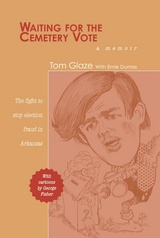 Waiting for the Cemetery Vote: The Fight to Stop Election Fraud in Arkansas
Tom Glaze
University of Arkansas Press, 2011 Waiting for the Cemetery Vote begins with an overview chapter of Arkansas election fraud since the nineteenth century and then moves on to more specific examples of fraudulent activities over a dozen or so years that coincide with the onset of the modern progressive era in Arkansas. Author Tom Glaze, who was a trial lawyer battling election fraud during this time, is the ideal chronicler for this topic, bringing a memoirist's intimate insight together with a wealth of historical knowledge. Glaze describes the manipulation of absentee ballots and poll-tax receipts; votes cast by the dead, children, and animals; forgeries of ballots from nursing homes; and threats to body or livelihood made to anyone who would dare question these activities or monitor elections. Deceptive practices used to control election results were disturbingly brazen in the gubernatorial elections in the 1960s and were especially egregious in Conway and Searcy Counties in the 1970s and in special elections for the state senate in Faulkner, Conway, and Van Buren Counties. A clean-election movement began in the early 1970s, led not by party or political leaders but by individual citizens. These vigilant and courageous Arkansans undertook to do what their public institutions persistently failed to: insure that elections for public office were honest and that the will of the people was scrupulously obliged. Prominent and colorful among these groups was a small band of women in Conway County who dubbed themselves the "Snoop Sisters" and took on the long-established corrupt machine of Sheriff Marlin Hawkins. Written with longtime Arkansas political writer Ernie Dumas and illustrated with cartoons from the inimitable George Fisher, Waiting for the Cemetery Vote will be an entertaining and informative read for any Arkansas history and politics buffs.
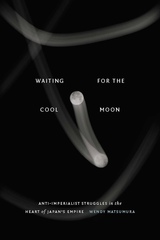 Waiting for the Cool Moon: Anti-imperialist Struggles in the Heart of Japan's Empire
Wendy Matsumura
Duke University Press, 2024 In Waiting for the Cool Moon Wendy Matsumura interrogates the erasure of colonial violence at the heart of Japanese nation-state formation. She critiques Japan studies’ role in this effacement and contends that the field must engage with anti-Blackness and anti-Indigeneity as the grounds on which to understand imperialism, colonialism, fascism, and other forces that shape national consciousness. Drawing on Black radical thinkers’ critique of the erasure of the Middle Passage in universalizing theories of modernity’s imbrication with fascism, Matsumura traces the consequences of the Japanese empire’s categorization of people as human and less-than-human as manifested in the 1920s and 1930s, and the struggles of racialized and colonized people against imperialist violence. She treats the archives safeguarded by racialized, colonized women throughout the empire as traces of these struggles, including the work they performed to keep certain stories out of view. Matsumura demonstrates that tracing colonial sensibility and struggle is central to grappling with their enduring consequences for the present.
Waiting for the Dawn: Mircea Eliade in Perspective
Davíd Carrasco
University Press of Colorado, 1991 First published in 1991, Waiting for the Dawn is the result of a year-long interdisciplinary study of Mircea Eliade’s scholarly, literary, and autobiographical works which took place at the University of Colorado in 1982. With a preface by Davíd Carrasco that takes into account recent developments in Eliade scholarship, this important work is back in print after renewed interest in Eliade thanks to Francis Ford Coppola’s screen adaptation Youth without Youth (2007).
Waiting for the Light
Alicia Ostriker
University of Pittsburgh Press, 2017 Winner of the 2017 National Jewish Book Award, poetry category
What is it like living today in the chaos of a city that is at once brutal and beautiful, heir to immigrant ancestors "who supposed their children's children would be rich and free?" What is it to live in the chaos of a world driven by "intolerable, unquenchable human desire?" How do we cope with all the wars? In the midst of the dark matter and dark energy of the universe, do we know what train we're on? In this cornucopia of a book, Ostriker finds herself immersed in phenomena ranging from a first snowfall in New York City to the Tibetan diaspora, asking questions that have no reply, writing poems in which "the arrow may be blown off course by storm and returned by miracle."
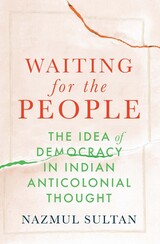 Waiting for the People: The Idea of Democracy in Indian Anticolonial Thought
Nazmul Sultan
Harvard University Press, 2024 An original reconstruction of how the debates over peoplehood defined Indian anticolonial thought, and a bold new framework for theorizing the global career of democracy.
Indians, their former British rulers asserted, were unfit to rule themselves. Behind this assertion lay a foundational claim about the absence of peoplehood in India. The purported “backwardness” of Indians as a people led to a democratic legitimation of empire, justifying self-government at home and imperial rule in the colonies.
In response, Indian anticolonial thinkers launched a searching critique of the modern ideal of peoplehood. Waiting for the People is the first account of Indian answers to the question of peoplehood in political theory. From Surendranath Banerjea and Radhakamal Mukerjee to Mohandas Gandhi and Jawaharlal Nehru, Indian political thinkers passionately explored the fraught theoretical space between sovereignty and government. In different ways, Indian anticolonial thinkers worked to address the developmental assumptions built into the modern problem of peoplehood, scrutinizing contemporary European definitions of “the people” and the assumption that a unified peoplehood was a prerequisite for self-government. Nazmul Sultan demonstrates how the anticolonial reckoning with the ideal of popular sovereignty fostered novel insights into the globalization of democracy and ultimately drove India’s twentieth-century political transformation.
Waiting for the People excavates, at once, the alternative forms and trajectories proposed for India’s path to popular sovereignty and the intellectual choices that laid the foundation for postcolonial democracy. In so doing, it uncovers largely unheralded Indian contributions to democratic theory at large. India’s effort to reconfigure the relationship between popular sovereignty and self-government proves a key event in the global history of political thought, one from which a great deal remains to be learned.
 Waiting For The Revolution To End: Syrian Displacement, Time and Subjectivity
Charlotte Al-Khalili
University College London, 2023 An exploration of the Syrian revolution through the experiences of citizens in exile.
Based on more than three years of embedded fieldwork with Syrians displaced in the border city of Gaziantep (southern Turkey), this book places the Syrian revolution and its tragic aftermath under ethnographic scrutiny. It charts the evolution from peaceful uprising (2011) to armed confrontation (2012), descent into fully fledged conflict (2013) and finally to proxy war (2015), to propose an understanding of revolution beyond success and failure.
While the Assad regime remains in place, the Syrian revolution (al-thawra) still holds a transformational power that can be located on intimate and world-making scales. Charlotte Al-Khalili traces the unintended consequences of revolution to reveal the reshaping of Syrian life-worlds and exiles’ evolving theorizations, experiences, and imaginations of al-thawra. She describes the in-between spatio-temporal realm inhabited by Syrians displaced to Turkey as they await the revolution’s outcomes and maps the revolution’s multidimensional and multi-scalar effects on their everyday life. By following the chronology of events inside Syria and Syrians’ geography of displacement, Waiting for the Revolution to End makes the relation between revolution and displacement its centerpiece, both as an ethnographic object and an analytical device.
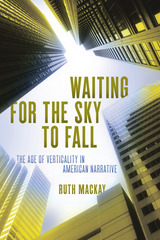 Waiting for the Sky to Fall: The Age of Verticality in American Narrative
Ruth Mackay
Ohio State University Press, 2016 Waiting for the Sky to Fall: The Age of Verticality in American Narrative by Ruth Mackay traces the figures of flight, grievous falls, and collapsing towers, all of which haunt American narratives before and after 9/11. Mackay examines how these events prefigure 9/11, exploring the narrative residue left by the “end” of horizontal space—when settlers reached America’s Pacific Coast, leaving nowhere westward on the continent to go. She then continues into the aftermath of the fall of the Twin Towers. This period of time marks an era of verticality: an age that offers a transformed concept of the limits of space, entwined with a sense of anxiety and trepidation.
With this study, Mackay asks: In what oblique ways has verticality leaked into American narrative? Why do metaphors of up and down recur across the twentieth century? With close readings of Jonathan Safran Foer’s Extremely Loud and Incredibly Close, Winsor McCay’s comic strip Little Nemo in Slumberland, Upton Sinclair’s Oil! and its film rendering There Will Be Blood, Allen Ginsberg’s poetic dissections of the nuclear bomb, and Leslie Marmon Silko’s imagining of flight in Almanac of the Dead, this interdisciplinary study culminates with a discussion of Philippe Petit’s tightrope walk between the Twin Towers. Waiting for the Sky to Fall examines how vertical representation cleaves to, and often transforms the associations of, specific events that are physically and visually disorienting, disquieting, or even traumatic.
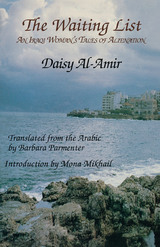 The Waiting List: An Iraqi Woman's Tales of Alienation
By Daisy Al-Amir
University of Texas Press, 1994 Daisy Al-Amir is one of the more visible figures in women's fiction in the Arab world today. This collection of stories, originally published in Lebanon as Ala La'ihat al-Intizar, is the most recent of her five publications. Her stories intimately reflect women's experiences in the chaotic worlds of the Lebanese civil war and the rise of Saadam Hussain as Iraq's leader. Set in Iraq, Cyprus, and Lebanon, the stories shed light on an unusual Middle East refugee experience—that of a cultural refugee, a divorced woman who is educated, affluent, and alone. Al-Amir is also a poet and novelist, whose sensual prose grows out of a long tradition of Iraqi poetry. But one also finds existential themes in her works, as Al-Amir tries to balance what seems fated and what seems arbitrary in the turbulent world she inhabits. She deals with time and space in a minimalist, surreal style, while studying the disappointments of life through the subjective lens of memory. Honestly facing the absence of family and the instability of place, Al-Amir gives lifelike qualities to the inanimate objects of her rapidly changing world. In addition to the stories, two examples of the author's experimental poems are included. In her introduction, Mona Mikhail places these stories and poems in the context of contemporary Islamic literature and gender studies.
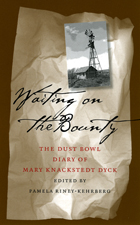 Waiting On The Bounty: Dust Bowl Diary Mary Dyck
Pamela Riney-Kehrberg
University of Iowa Press, 1999 The daughter of German immigrants, Mary Knackstedt married Henry Dyck, a Mennonite farmer, and in 1905 moved west to a settlement near Lamont Township in Hamilton County, Kansas. For the next thirty years they enjoyed growth and prosperity. Then the drought and dust storms that had driven many farmers from the region in the early years of the century returned. The Dycks remained on their farm and witnessed the mass exodus of farmers and townspeople—including close friends and family—who fled the Kansas wheat country to find work.
Though she had only a fifth-grade education, Mary Knackstedt Dyck faithfully kept a diary. Written with pencil on lined notebook paper, her daily notations tell the story of farm life on the far western border of Kansas during the grim Dust Bowl years. Manuscript diaries from this era and region are extremely rare, and those written by farm women are even more so. From the point of view of a wife, mother, and partner in the farming enterprise, Dyck recorded the everyday events as well as the frustrations of living with drought and dust storms and the sadness of watching one's children leave the farm.
A remarkable historical document, the diary describes a period in this century before the telephone and indoor plumbing were commonplace in rural homes—a time when farm families in the Plains states were isolated from world events, and radio provided an enormously important link between farmsteads and the world at large. Waiting on the Bounty brings us unusual insights into the agricultural and rural history of the United States, detailing the tremendous changes affecting farming families and small towns during the Great Depression. Pamela Riney-Kehrberg has provided an edited version of the diary entries from 1936 to 1941. Her informative introduction tells the story of the Dycks' settlement in western Kansas and places the diary in its historical context.
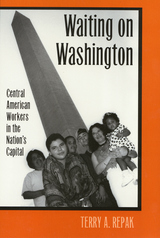 Waiting On Washington: Central American Workers in the Nation's Capital
Terry A. Repak
Temple University Press, 1995 In an analysis of recent immigration patterns in Washington, D.C., Terry A. Repak documents the unusual predominance of women among Central American immigrants. Two thirds of the arriving immigrants in earlier decades have been women, many of them recruited by international diplomats and U.S. government employees to work as housekeepers and nannies. Repak considers the labor force participation patterns for women compared to men, the effect of immigration laws—particularly the IRCA's uneven impact on women versus men—and the profound adjustments in gender roles and identities that accompany migration. Showing an extraordinary amount of autonomy, most of these immigrant women decided to migrate without consulting either fathers or partners, and they gained even greater independence once settled. Repak plots the career trajectories of numerous Central American immigrant women and men to illustrate the array of the women's responses, gender differences in the migration and assimilation experience, the availability of work, and the possibility for upward mobility and higher wages. Providing social, economic and political context, she looks at the conditions that set the stage for this migration, including the rapid expansion of service jobs in the 1960s and 1970s in Washington, D. C. and the political strife in such Central American countries as war-torn El Salvador, Nicaragua, and Guatemala.
The Waiting Room Reader: Stories to Keep You Company
Joan Cusack Handler
CavanKerry Press, 2010 The Reader was co-sponsored and co-conceived by CavanKerry and LaurelBooks partner, The Arnold P.Gold Foundation for Humanism in Medicine. Publisher Joan Cusack Handler and Gold Foundation President and CEO Sandra Gold observed that patients, while waiting to learn about their physical health, typically are provided only pop culture magazines—perhaps entertaining but without the solace and comfort that literature provides. The Waiting Room Reader was designed to address that need by bringing fine and accessible writing to “keep the patients company.” Here are uplifting and inspiring poems that focus on life’s gifts – everyday pleasures: love and family, food and home, work and play, dreams and the earth. This collection, originally offered only to hospitals and physicians’ waiting rooms, was received with great success and is now available to a wider audience.
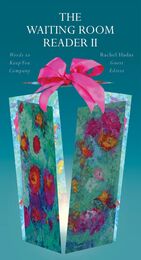 The Waiting Room Reader: Words to Keep You Company
Rachel Hadas
CavanKerry Press, 2013 From the introduction: “This book, the second in the Waiting Room Reader series, grows from the belief of its visionary originators, Joan Cusack Handler, director of CavanKerry Press, and Sandra O. Gold, president of the Arnold P. Gold Foundation for Humanism in Medicine, that one good thing to be able to pay attention to in waiting rooms is poetry. This is a belief that I, as guest editor of this volume, emphatically share. Poems with staying power are always themselves acts of attentiveness, and reading any good poem both demands and rewards attention. The job, then, is to make sure poems can be found in waiting rooms, where they will always be needed. All the works in this collection (primarily poems but also a handful of short prose pieces) enact longing and memory; they recall, they evoke, they praise. The writing of just about every piece in this book turns out to have been an act of reclamation, an evocation of some lost original, which isn’t so lost after all. “The pieces gathered here touch upon themes poets have always visited: memory, family, love, loss, nature. Voices and styles naturally and delightfully vary; some pieces are chiseled and succinct, others loose and rhapsodic. But all, in addition to being accomplished, share the generosity and intensity of their attention to a particular piece of experience.” Among the contributors are Robin Behn, Maxine Kumin, Molly Peacock, Linda Pastan, Liz Rosenberg, Elizabeth Spires, and Jeffrey Harrison.
Wake
Bin Ramke
University of Iowa Press, 1999 Throughout Bin Ramke's book of poems, certain elements recur insistently: birds and boyhood, betrayal and longings that careen between flesh and faith. Ramke refuses to distinguish between scientific and poetic approaches to knowing the world. In Wake, the poet does not pretend to offer wisdom but instead offers words, and the words are given as much freedom as possible. The title itself resonates with all its presumptive meanings: an alternative to dreaming, a ceremony binding the living to the dead, and the pattern left briefly in water by boats—handwriting as turbulence in a fluid medium. Elements of the world at large are woven into the language of these poems, resulting in a conversation among transcripts from the trial of Jeffrey Dahmer, passages from the notebooks of John James Audubon, a meditation on the Book of Daniel, whole epic sentences out of Milton, and the modest observations of the struggling poet himself.
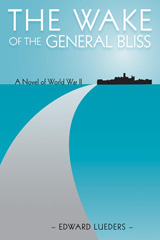 The Wake of the General Bliss: A Novel of World War II
Edward Lueders
University of Utah Press, 2008 Set aboard a ship carrying troops home from India at the end of World War II, Edward Lueders’ autobiographical novel opens with the dramatic events that ensue when the call goes out, 'Man overboard!' As the vessel drifts, engines stopped, in search of the lost man, the story begins to delve deeper into the paradox at the center of our lives, as irreducible isolation is juxtaposed with inevitable coexistence.
The ship becomes a complex metaphor for the thousands of men aboard and, by extension, for all of us who exist both as individuals and as parts of the human community. These motifs are developed through the interplay of three men aboard ship, Staff Sgt. LeRoy Warner, Sgt. Mark Reiter, and Sgt. Stanley Norman, who entertain troops as a jazz trio. These GI musicians improvise through solo sections in which each reflects hauntingly on his past and dreams of his future. As they search for meaning beyond subjectivism, beyond suffering and randomness, their music is about the possibilities for harmony.
Although miscues, counterbeats, and dissonance apparently mock our efforts to break out of ourselves, sometimes, however fleetingly, everything falls into place. Then the prose of our lives turns unexpectedly to poetry and we experience an exhilarating unity.
The Wake of the Unseen Object: Travels through Alaska's Native Landscapes
Tom Kizzia
University of Alaska Press, 2020 A journey to Alaska’s remote roadless villages, during a time of great historical transition, brings us this enduring portrait of a place and its people. Alutiiq, Yup’ik, Inupiaq, and Athabascan subjects reveal themselves as entirely contemporary individuals with deep longings and connection to the land and to their past. Tom Kizzia’s account of his travels off the Alaska road system, first published in 1991, has endured with a sterling reputation for its thoughtful, poetic, unflinching engagement with the complexity of Alaska’s rural communities. Wake of the Unseen Object is now considered some of the finest nonfiction writing about Alaska. This new edition includes an updated introduction by the author, looking at what remains the same after thirty years and what is different—both in Alaska, and in the expectations placed on a reporter visiting from another world.
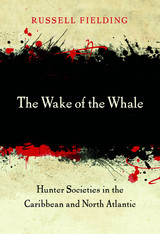 The Wake of the Whale: Hunter Societies in the Caribbean and North Atlantic
Russell Fielding
Harvard University Press, 2018 Despite declining stocks worldwide and increasing health risks, artisanal whaling remains a cultural practice tied to nature’s rhythms. The Wake of the Whale presents the art, history, and challenge of whaling in the Caribbean and North Atlantic, based on a decade of award-winning fieldwork.
Sightings of pilot whales in the frigid Nordic waters have drawn residents of the Faroe Islands to their boats and beaches for nearly a thousand years. Down in the tropics, around the islands of St. Vincent and the Grenadines, artisanal whaling is a younger trade, shaped by the legacies of slavery and colonialism but no less important to the local population. Each culture, Russell Fielding shows, has developed a distinct approach to whaling that preserves key traditions while adapting to threats of scarcity, the requirements of regulation, and a growing awareness of the humane treatment of animals.
Yet these strategies struggle to account for the risks of regularly eating meat contaminated with methylmercury and other environmental pollutants introduced from abroad. Fielding considers how these and other factors may change whaling cultures forever, perhaps even bringing an end to this way of life.
A rare mix of scientific and social insight, The Wake of the Whale raises compelling questions about the place of cultural traditions in the contemporary world and the sacrifices we must make for sustainability.
Publication of this book was supported, in part, by a grant from Furthermore: a program of the J. M. Kaplan Fund.
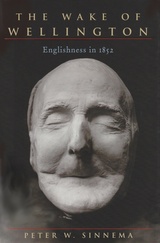 The Wake of Wellington: Englishness in 1852
Peter W. Sinnema
Ohio University Press, 2006 Soldier, hero, and politician, the Duke of Wellington is one of the best-known figures of nineteenth-century England. From his victory at Waterloo over Napoleon in 1815, he rose to become prime minister of his country. But Peter Sinnema finds equal fascination in Victorian England’s response to the duke’s death. The Wake of Wellington considers Wellington’s spectacular funeral pageant in the fall of 1852—an unprecedented event that attracted one and a half million spectators to London—as a threshold event against which the life of the soldier-hero and High Tory statesman could be re-viewed and represented. Canvassing a profuse and dramatically proliferating Wellingtoniana, Sinnema examines the various assumptions behind, and implications of, the Times’s celebrated claim that the Irish-born Wellington “was the very type and model of an Englishman.” The dead duke, as Sinnema demonstrates, was repeatedly caught up in interpretive practices that stressed the quasi-symbolic relations between hero and nation. The Wake of Wellington provides a unique view of how in death Wellington and his career were promoted as the consummation of a national destiny intimately bound up with Englishness itself, and with what it meant to be English at midcentury.
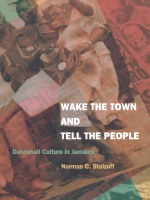 Wake the Town and Tell the People: Dancehall Culture in Jamaica
Norman C. Stolzoff
Duke University Press, 2000 Jamaican dancehall has long been one of the most vital and influential cultural and artistic forces within contemporary global music. Wake the Town and Tell the People presents, for the first time, a lively, nuanced, and comprehensive view of this musical and cultural phenomenon: its growth and historical role within Jamaican society, its economy of star making, its technology of production, its performative practices, and its capacity to channel political beliefs through popular culture in ways that are urgent, tangible, and lasting.
Norman C. Stolzoff brings a fan’s enthusiasm to his broad perspective on dancehall, providing extensive interviews, original photographs, and anthropological analysis from eighteen months of fieldwork in Kingston. Stolzoff argues that this enormously popular musical genre expresses deep conflicts within Jamaican society, not only along lines of class, race, gender, sexuality, and religion but also between different factions struggling to gain control of the island nation’s political culture. Dancehall culture thus remains a key arena where the future of this volatile nation is shaped. As his argument unfolds, Stolzoff traces the history of Jamaican music from its roots in the late eighteenth century to 1945, from the addition of sound systems and technology during the mid-forties to early sixties, and finally through the post-independence years from the early sixties to the present.
Wake the Town and Tell the People offers a general introduction for those interested in dancehall music and culture. For the fan or musicologist, it will serve as a comprehensive reference book.
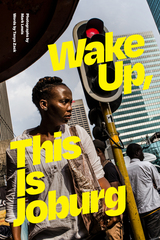 Wake Up, This Is Joburg
Words by Tanya Zack, Photographs by Mark Lewis
Duke University Press, 2022 A single image taken from a high-rise building in inner-city Johannesburg uncovers layers of history—from its premise and promise of gold to its current improvisations. It reveals the city as carcass and as crucible, where informal agents and processes spearhead its rapid reshaping and transformation. In Wake Up, This Is Joburg, writer Tanya Zack and photographer Mark Lewis offer a stunning portrait of Johannesburg and personal stories of some of the city’s ordinary, odd, and outrageous residents. Their photos and essays take readers into meat markets where butchers chop cow heads; the eclectic home of an outsider artist that features turrets and full of manikins; long-abandoned gold pits beneath the city, where people continue to mine informally; and lively markets, taxi depots, and residential high-rises. Sharing people’s private and work lives and the extraordinary spaces of the metropolis, Zack and Lewis show that Johannesburg’s urban transformation occurs not in a series of dramatic, wide-scale changes but in the everyday lives, actions, and dreams of individuals.
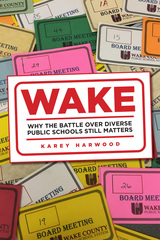 Wake: Why the Battle over Diverse Public Schools Still Matters
Karey Alison Harwood
Rutgers University Press, 2024 The Wake County Public School System was once described as a beacon of hope for American school districts. It was both academically successful and successfully integrated. It accomplished these goals through the hard work of teachers and administrators, and through a student assignment policy that made sure no school in the countywide district became a high poverty school. Although most students attended their closest school, the “diversity policy” modified where some students were assigned to make sure no school had more than 40% of its students qualifying for free or reduced-price lunch or more than 25% performing below grade level. When the school board election of 2009 swept into office a majority who favored “neighborhood schools,” the diversity policy that had governed student assignment for years was eliminated. Wake: Why the Battle Over Diverse Public Schools Still Matters tells the story of the aftermath of that election, including the fierce public debate that ensued during school board meetings and in the pages of the local newspaper, and the groundswell of community support that voted in a pro-diversity school board in 2011. What was at stake in those years was the fundamental direction of the largest school district in North Carolina and the 14th largest in the U.S. Would it maintain a commitment to diverse schools, and if so, how would it balance that commitment with various competing interests and demands? Through hundreds of published opinion articles and several in depth interviews with community leaders, Wake examines the substance of that debate and explores the community’s vision for public education. Wake also explores the importance of knowing the history of a place, including the history of school segregation. Wake County’s example still resonates, and the battle over diverse public schools still matters, because owning responsibility for the problem of segregated schools (or not) will shape the direction of America’s future.
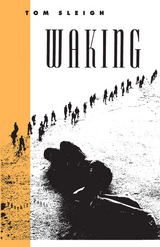 Waking
Tom Sleigh
University of Chicago Press, 1990 One of our most gifted poets, Sleigh reveals with vigor and delicacy the connections forged between the dead and the living. Waking is a moving narrative of the creation of the self.
". . . . it takes a book like Tom Sleigh's Waking to remind us of all that was most innately stirring and necessary about the confessional insurrection. . . . in Waking Sleigh proves himself worthy of spinning gold thread from the straw of sincerity, elevating his so-called confessions from the merely revealing to the durably revelatory."—David Barber, Poetry
"[Sleigh] is a consummate stylist whose formal control and exploitation of convention is graceful and calm. And yet it is from the calm and steady control that some of Sleigh's most emotionally powerful moments are acheived. . . .Waking is one of the strongest collections of poems to appear in the last few years."—Michael Collier, Partisan Review
"Tom Sleigh's second book of poems, Waking is so fine one can hardly do justice to it in a review. The second poem, 'Ending,' is a remarkable piece of work which introduces the notion of the 'hook'—which hooks us to life even while it kills us. It is a presence of painful mortality which haunts the rest of the book."—Liz Rosenberg, New York Times Book Review
"Waking handsomely and affirmatively demonstrates its own clean and demanding premise: one's imagination is awakened to life by the burden of mortality. One reads in these poems a view not of the poet's suffering, but of our own temporal joys and sorrows."—Jay Meek, Hungry Mind Review
"With the publication of Waking, his second collection of poems, Tom Sleigh establishes his voice among the strongest of his generation. A poet of subject and craft, his skill allows him to avoid the slackness of much free verse and, at the same time, break free of the stiff old numbers in order to create a spoken language of rhythmic intensity and eloquence. . . . In this book Tom Sleigh's vigilance provides his readers with an invaluable gift: we can wake our lives."—Stuart Dischell, Boston Review
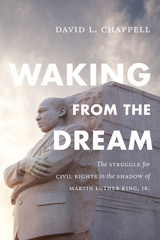 Waking from the Dream: The Struggle for Civil Rights in the Shadow of Martin Luther King, Jr.
David L. Chappell
Duke University Press, 2016 In Waking from the Dream David L. Chappell—whose book A Stone of Hope the Atlantic Monthly called "one of the three or four most important books on the civil rights movement"— provides a sweeping history of the fight to keep the civil rights movement alive following Martin Luther King, Jr.’s assassination. Chappell reveals that, far from coming to an abrupt end with King's death, the civil rights movement continued to work to realize King's vision of an equal society. Entering a new phase where historic victories were no longer within reach, the movement's veterans struggled to rally around common goals; and despite moments where the movement seemed to be on the verge of dissolution, it kept building coalitions, lobbying for legislation, and mobilizing activists. Chappell chronicles five key events of the movement's post-King era: the passage of the Fair Housing Act in 1968; the debates over unity and leadership at the National Black Political Conventions; the campaign for full-employment legislation; the establishment of Martin Luther King, Jr. Day; and Jesse Jackson's quixotic presidential campaigns. With Waking from the Dream, Chappell provides a revealing look into a seldom-studied era of civil rights history, examines King's place in American memory, and explains how a movement labored to overcome the loss of its leader.
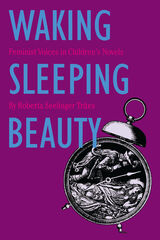 Waking Sleeping Beauty: Feminist Voices in Children's Novels
Roberta S. Trites
University of Iowa Press, 1997 The Sleeping Beauty in Roberta Seelinger Trites' intriguing text is no silent snoozer passively waiting for Prince Charming to energize her life. Instead she wakes up all by herself and sets out to redefine the meaning of “happily ever after.” Trites investigates the many ways that Sleeping Beauty's newfound voice has joined other strong female voices in feminist children's novels to generate equal potentials for all children. Waking Sleeping Beauty explores issues of voice in a wide range of children's novels, including books by Virginia Hamilton, Patricia MacLachlan, and Cynthia Voight as well as many multicultural and international books. Far from being a limiting genre that praises females at the expense of males, the feminist children's novel seeks to communicate an inclusive vision of politics, gender, age, race, and class. By revising former stereotypes of children's literature and replacing them with more complete images of females in children's books, Trites encourages those involved with children's literature—teachers, students, writers, publishers, critics, librarian, booksellers, and parents—to be aware of the myriad possibilities of feminist expression. Roberta Trites focuses on the positive aspects of feminism: on the ways females interact through family and community relationships, on the ways females have revised patriarchal images, and on the ways female writers use fictional constructs to transmit their ideologies to readers. She thus provides a framework that allows everyone who enters a classroom with a children's book in hand to recognize and communicate—with an optimistic, reality-based sense of “happily ever after”—the politics and the potential of that book.
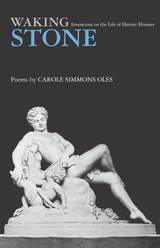 Waking Stone: Inventions on the Life of Harriet Hosmer
Carole Simmons Oles
University of Arkansas Press, 2006 From Carole Simmons Oles comes a new modern poetry biography, this one based on the life of American sculptor Harriet Hosmer (1830–1908). After an exceptional apprenticeship in Rome, Hosmer opened a studio there where she was associated with Nathaniel Hawthorne, Henry James, and the Brownings. Though some of her work survives today, much of it has disappeared. Oles rediscovers Hosmer’s life in Waking Stone. This is a dialogue, an exploration of what Oles calls their “parallel universes.” In beautiful and affecting lyric and narrative poems, some in Hosmer’s voice, some in her own, Oles bends time and circumstances to reveal the essential kinship between two women artists. Oles keeps readers moving through Hosmer’s story, with its flashes of delight, anger, mischief, and triumph, as well as through Oles’s life and time, speaking imaginatively to young women about cutting themselves with razor blades, and to older women about suffering disfiguring treatments for breast cancer.
 Waldef: A French Romance from Medieval England
Ivana Djordjević
Arc Humanities Press, 2020 This first English translation of Le Roman de Waldef makes a significant representative of the French literature of medieval England accessible for the first time. Its wide-ranging content provides an ideal introduction to a number of themes in medieval literature, making it suitable for a variety of undergraduate and graduate courses.
The fast-moving romance plot of this early thirteenth-century tale recounts the ancestry and exploits of Waldef and his two sons, set against a history of pre-Conquest England. The narrative shares themes and incident types with other important insular romances, including the Lai of Haveloc, Boeve de Haumtone, and Gui de Warewic. Waldef’s scope, interest in battle, and political stratagems bear reading alongside medieval chronicles, while secret love affairs connect it with other romance literature of the period, and adventures across a wide area of the known world provide affinities with medieval travel narrative.
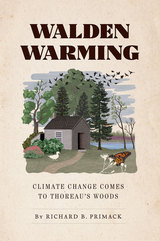 Walden Warming: Climate Change Comes to Thoreau's Woods
Richard B. Primack
University of Chicago Press, 2014 In his meticulous notes on the natural history of Concord, Massachusetts, Henry David Thoreau records the first open flowers of highbush blueberry on May 11, 1853. If he were to look for the first blueberry flowers in Concord today, mid-May would be too late. In the 160 years since Thoreau’s writings, warming temperatures have pushed blueberry flowering three weeks earlier, and in 2012, following a winter and spring of record-breaking warmth, blueberries began flowering on April 1—six weeks earlier than in Thoreau’s time. The climate around Thoreau’s beloved Walden Pond is changing, with visible ecological consequences.
In Walden Warming, Richard B. Primack uses Thoreau and Walden, icons of the conservation movement, to track the effects of a warming climate on Concord’s plants and animals. Under the attentive eyes of Primack, the notes that Thoreau made years ago are transformed from charming observations into scientific data sets. Primack finds that many wildflower species that Thoreau observed—including familiar groups such as irises, asters, and lilies—have declined in abundance or have disappeared from Concord. Primack also describes how warming temperatures have altered other aspects of Thoreau’s Concord, from the dates when ice departs from Walden Pond in late winter, to the arrival of birds in the spring, to the populations of fish, salamanders, and butterflies that live in the woodlands, river meadows, and ponds.
Primack demonstrates that climate change is already here, and it is affecting not just Walden Pond but many other places in Concord and the surrounding region. Although we need to continue pressuring our political leaders to take action, Primack urges us each to heed the advice Thoreau offers in Walden: to “live simply and wisely.” In the process, we can each minimize our own contributions to our warming climate.
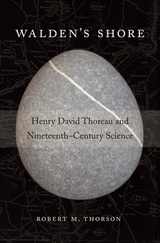 Walden’s Shore: Henry David Thoreau and Nineteenth-Century Science
Robert M. Thorson
Harvard University Press, 2014 "Let us settle ourselves, and work and wedge our feet downward," Thoreau invites his readers in Walden, "till we come to a hard bottom and rocks in place, which we can call reality." Walden's Shore explores Thoreau's understanding of that hard reality, not as metaphor but as physical science. Robert M. Thorson is interested in Thoreau the rock and mineral collector, interpreter of landscapes, and field scientist whose compass and measuring stick were as important to him as his plant press. At Walden's climax, Thoreau asks us to imagine a "living earth" upon which all animal and plant life is parasitic. This book examines Thoreau's understanding of the geodynamics of that living earth, and how his understanding informed the writing of Walden.
The story unfolds against the ferment of natural science in the nineteenth century, as Natural Theology gave way to modern secular science. That era saw one of the great blunders in the history of American science--the rejection of glacial theory. Thorson demonstrates just how close Thoreau came to discovering a "theory of everything" that could have explained most of the landscape he saw from the doorway of his cabin at Walden. At pivotal moments in his career, Thoreau encountered the work of the geologist Charles Lyell and that of his protégé Charles Darwin. Thorson concludes that the inevitable path of Thoreau's thought was descendental, not transcendental, as he worked his way downward through the complexity of life to its inorganic origin, the living rock.
Waldo Gifford Leland and the Origins of the American Archival Profession
Peter J. Wosh
Society of American Archivists, 2011 The professional accomplishments of Waldo Gifford Leland (1879-1966) are legendary: historian, surveyor of archival repositories in America and in France, father of the American Historical Association's Conference of Archivists, archival theorist, J. Franklin Jameson's key lieutenant in the battle for the establishment of the National Archives, second president of the Society of American Archivists, and long time head of the American Council of Learned Societies. This splendid classic brings together Leland's most significant writings concerning archives and archival methods, concentrating on the period from 1908 to 1920, when Leland was most involved in helping to create the American archives profession.
Wali Pitu and Muslim Pilgrimage in Bali, Indonesia: Inventing a Sacred Tradition
Syaifudin Zuhri
Leiden University Press, 2022 This ethnographic book deals with the emergence of the Wali Pitu (seven saints) tradition and Muslim pilgrimage in Bali, Indonesia. It touches upon the issues of translocal connectivity between Java and Bali, Islam-Hindu relationship, relations between Muslim groups, and questions of authority and authenticity of saint worship tradition. It offers a new perspective on Bali, seeing the island as a site of cultural motion straddling in between Islam and Hinduism with complexities of local figurations, and belongings of ‘Muslim Balinese’. The study also urges the intricate relationship between religion and tourism, between devotion and economy, and shows that the Wali Pitu tradition has facilitated the transgression of spatial and cultural boundaries.
 A Walk around the Pond: Insects in and over the Water
Gilbert Waldbauer
Harvard University Press, 2008 A water strider darts across a pond, its feet dimpling the surface tension; a giant water bug dives below, carrying his mate’s eggs on his back; hidden among plant roots on the silty bottom, a dragonfly larva stalks unwary minnows. Barely skimming the surface, in the air above the pond, swarm mayflies with diaphanous wings. Take this walk around the pond with Gilbert Waldbauer and discover the most amazingly diverse inhabitants of the freshwater world.
In his hallmark companionable style, Waldbauer introduces us to the aquatic insects that have colonized ponds, lakes, streams, and rivers, especially those in North America. Along the way we learn about the diverse forms these arthropods take, as well as their remarkable modes of life—how they have radiated into every imaginable niche in the water environment, and how they cope with the challenges such an environment poses to respiration, vision, thermoregulation, and reproduction. We encounter the caddis fly larva building its protective case and camouflaging it with stream detritus; green darner dragonflies mating midair in an acrobatic wheel formation; ants that have adapted to the tiny water environment within a pitcher plant; and insects whose adaptations to the aquatic lifestyle are furnishing biomaterials engineers with ideas for future applications in industry and consumer goods.
While learning about the evolution, natural history, and ecology of these insects, readers also discover more than a little about the scientists who study them.
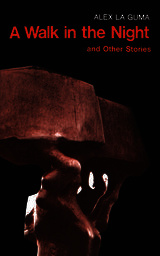 A Walk in the Night and Other Stories
Alex La Guma
Northwestern University Press, 1967 In the title story, in a Cape Town shantytown called District Six in the 1960s, Michael Adonis has lost his job at a metal sheet factory after an argument with a white supervisor. Illuminating the toxic effects of poverty, police brutality, and violence, the book paints a stark and unforgettable portrait of Adonis's emotional and physical destruction in apartheid South Africa. These works reveal the plight of non-whites in apartheid South Africa, laying bare the lives of the poor and the outcasts who filled the ghettoes and shantytowns. Of French and Malagasy stock, involved in South African politics from an early age, Alex La Guma was arrested for treason with 155 others in 1956 and finally acquitted in 1960. During the State of Emergency following the Sharpeville massacre he was detained for five months. Continuing to write, he endured house arrest and solitary confinement. La Guma left South Africa as a refugee in 1966 and lived in exile in London and Havana. He died in 1986. A Walk in the Night and Other Stories reveals La Guma as one of the most important African writers of his time.
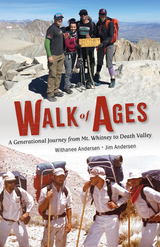 Walk of Ages: A Generational Journey from Mt. Whitney to Death Valley
Withanee Andersen
University of Nevada Press, 2024 Following in her father’s footsteps, Withanee Andersen begins the expedition of a lifetime when she and her comrades embark on a trek from Mt. Whitney to Death Valley, tracing the rugged path her father, Jim Andersen, traversed forty-three years earlier.
With hopes of being listed in the Guinness Book of World Records, Jim led the first documented walk from the highest to lowest point in the contiguous United States in 1974. He lived, albeit just barely, to tell the tale to his daughter, sparking a desire in Withanee to retrace his steps in his honor. In 2017, she took on the incredible task of recreating Jim’s legacy trek of 131 miles with the help of divine intervention, ice-cold beer, and her parents, who were following along as the support party.
Walk of Ages humorously relates the parallel journey of an epic adventure told from two perspectives—a daughter’s difficult quest, and a father who supports her through it while recalling his own experiences from four decades earlier. Throughout this momentous odyssey, readers will realize how a once-in-a-generation adventure leads to life-changing transformation, and that the bond between father and daughter knows no bounds.
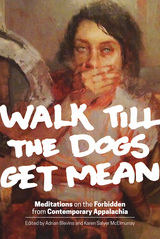 Walk Till the Dogs Get Mean: Meditations on the Forbidden from Contemporary Appalachia
Adrian Blevins
Ohio University Press, 2015 In Walk Till the Dogs Get Mean, Adrian Blevins and Karen Salyer McElmurray collect essays from today’s finest established and emerging writers with roots in Appalachia. Together, these essays take the theme of silencing in Appalachian culture, whether the details of that theme revolve around faith, class, work, or family legacies.
In essays that take wide-ranging forms—making this an ideal volume for creative nonfiction classes—contributors write about families left behind, hard-earned educations, selves transformed, identities chosen, and risks taken. They consider the courage required for the inheritances they carry.
Toughness and generosity alike characterize works by Dorothy Allison, bell hooks, Silas House, and others. These writers travel far away from the boundaries of a traditional Appalachia, and then circle back—always—to the mountains that made each of them the distinctive thinking and feeling people they ultimately became. The essays in Walk Till the Dogs Get Mean are an individual and collective act of courage.
Contributors:
Dorothy Allison, Rob Amberg, Pinckney Benedict, Kathryn Stripling Byer, Sheldon Lee Compton, Michael Croley, Richard Currey, Joyce Dyer, Sarah Einstein, Connie May Fowler, RJ Gibson, Mary Crockett Hill, bell hooks, Silas House, Jason Howard, David Huddle, Tennessee Jones, Lisa Lewis, Jeff Mann, Chris Offutt, Ann Pancake, Jayne Anne Phillips, Melissa Range, Carter Sickels, Aaron Smith, Jane Springer, Ida Stewart, Jacinda Townsend, Jessie van Eerden, Julia Watts, Charles Dodd White, and Crystal Wilkinson.
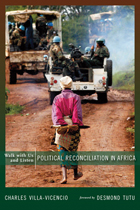 Walk with Us and Listen: Political Reconciliation in Africa
Charles Villa-Vicencio. Foreword byDesmond Tutu
Georgetown University Press, 2009 Effective peace agreements are rarely accomplished by idealists. The process of moving from situations of entrenched oppression, armed conflict, open warfare, and mass atrocities toward peace and reconciliation requires a series of small steps and compromises to open the way for the kind of dialogue and negotiation that make political stability, the beginning of democracy, and the rule of law a possibility. For over forty years, Charles Villa-Vicencio has been on the front lines of Africa's battle for racial equality. In Walk with Us and Listen, he argues that reconciliation needs honest talk to promote trust building and enable former enemies and adversaries to explore joint solutions to the cause of their conflicts. He offers a critical assessment of the South African experiment in transitional justice as captured in the Truth and Reconciliation Commission and considers the influence of ubuntu, in which individuals are defined by their relationships, and other traditional African models of reconciliation. Political reconciliation is offered as a cautious model against which transitional politics needs to be measured. Villa-Vicencio challenges those who stress the obligation to prosecute those allegedly guilty of gross violation of human rights, replacing this call with the need for more complementarity between the International Criminal Court and African mechanisms to achieve the greater goals of justice and peace building.
 Walkable City Rules: 101 Steps to Making Better Places
Jeff Speck
Island Press, 2018 “Cities are the future of the human race, and Jeff Speck knows how to make them work.”
—David Owen, staff writer at the New Yorker
Nearly every US city would like to be more walkable—for reasons of health, wealth, and the environment—yet few are taking the proper steps to get there. The goals are often clear, but the path is seldom easy. Jeff Speck’s follow-up to his bestselling Walkable City is the resource that cities and citizens need to usher in an era of renewed street life. Walkable City Rules is a doer’s guide to making change in cities, and making it now.
The 101 rules are practical yet engaging—worded for arguments at the planning commission, illustrated for clarity, and packed with specifications as well as data. For ease of use, the rules are grouped into 19 chapters that cover everything from selling walkability, to getting the parking right, escaping automobilism, making comfortable spaces and interesting places, and doing it now!
Walkable City was written to inspire; Walkable City Rules was written to enable. It is the most comprehensive tool available for bringing the latest and most effective city-planning practices to bear in your community. The content and presentation make it a force multiplier for place-makers and change-makers everywhere.
Walked Through Storm to You: Love Sonnets
Roger Armbrust
Parkhurst Brothers, Inc., 2022 Armbrust writes sonnets on a variety of themes, primarily addressed to his muse and his lovers. Since 1979, when his first book of poetry went to press, he continues to write, as if he opens a vein to pour his own blood onto the page to do it.
In this book of 126 sonnets, the poet invites us to walk with him as his creative sense takes us through every mood of nature on earth, and to the universe beyond. Imagery’s connections turn hearing 2 a.m. rain into Hemingway’s and James Dickey’s typewriter keys, leading the poet to write. Each poem seems to meld us to relationships.
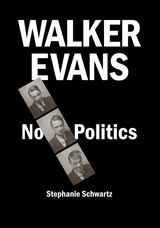 Walker Evans: No Politics
By Stephanie Schwartz
University of Texas Press, 2020 “NO POLITICS whatever.” Walker Evans made this emphatic declaration in 1935, the year he began work for FDR’s Resettlement Administration. Evans insisted that his photographs of tenant farmers and their homes, breadlines, and the unemployed should be treated as “pure record.” The American photographer’s statements have often been dismissed. In Walker Evans: No Politics, Stephanie Schwartz challenges us to engage with what it might mean, in the 1930s and at the height of the Great Depression, to refuse to work politically. Offering close readings of Evans’s numerous commissions, including his contribution to Carleton Beals’s anti-imperialist tract, The Crime of Cuba (1933), this book is a major departure from the standard accounts of Evans’s work and American documentary. Documentary, Schwartz reveals, is not a means of being present—or being “political.” It is a practice of record making designed to distance its maker from the “scene of the crime.” That crime, Schwartz argues, is not just the Depression; it is the processes of Americanization reshaping both photography and politics in the 1930s. Historicizing documentary, this book reimagines Evans and his legacy—the complexities of claiming “no politics.”
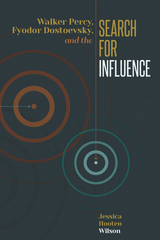 Walker Percy, Fyodor Dostoevsky, and the Search for Influence
Jessica Hooten Wilson
Ohio State University Press, 2017 Although Walker Percy named many influences on his work and critics have zeroed in on Kierkegaard in particular, no one has considered his intentional influence: the nineteenth-century Russian novelist Fyodor Dostoevsky. In a study that revives and complicates notions of adaptation and influence, Jessica Hooten Wilson details the long career of Walker Percy. Walker Percy, Fyodor Dostoevsky, and the Search for Influence demonstrates—through close reading of both writers’ works, examination of archival materials, and biographical criticism—not only how pervasive and inescapable Dostoevsky’s influence was but also how necessary it was to the distinctive strengths of Percy’s fiction.
From Dostoevsky, Percy learned how to captivate his non-Christian readership with fiction saturated by a Christian vision of reality. Not only was his method of imitation in line with this Christian faith but also the aesthetic mode and very content of his narratives centered on his knowledge of Christ. The influence of Dostoevsky on Percy, then, becomes significant as a modern case study for showing the illusion of artistic autonomy and long-held, Romantic assumptions about artistic originality. Ultimately, Wilson suggests, only by studying the good that came before can one translate it in a new voice for the here and now.
 Walking a City's History: Mexico City from the Sixteenth Century to the Present
Mauricio Tenorio-Trillo
University of Chicago Press Take a street-level tour of Mexico’s capital and learn how one of the world’s most extraordinary cities has transformed over the centuries.
Walking a City´shistory is both a richly documented panoramic view of Mexico City’s long history and an intimate essay on its social and cultural fabric. In this book, Mauricio Tenorio-Trillo uses his expertise as a historian and his talents as a storyteller to bring the city to life.
Using influential moments in Mexico City’s history from the Battle of Tenochtitlán in 1521 to post-COVID times, Tenorio-Trillo illustrates the capital’s transformations against a national and global background. Walking a City’s History offers an original, unique perspective on the social, architectural, artistic, and political dimensions of Mexico City, guided by chronicles, literary works, historical accounts, and the author´s own lifetime of walks through the city.
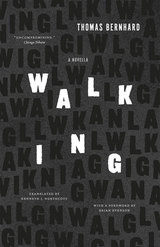 Walking: A Novella
Thomas Bernhard
University of Chicago Press, 2015 A bleak, hilarious novella from a master of black comedy that Publishers Weekly called "one of the 10 funniest books ever"
Thomas Bernhard is “one of the masters of contemporary European fiction” (George Steiner); “one of the century’s most gifted writers” (Newsday); “a virtuoso of rancor and rage” (Bookforum). And although he is favorably compared with Franz Kafka, Samuel Beckett, and Robert Musil, it is only in recent years that he has gained a devoted cult following in America.
A powerful, compact novella, Walking provides a perfect introduction to the absurd, dark, and uncommonly comic world of Bernhard, showing a preoccupation with themes—illness and madness, isolation, tragic friendships—that would obsess Bernhard throughout his career. Walking records the conversations of the unnamed narrator and his friend Oehler while they walk, discussing anything that comes to mind but always circling back to their mutual friend Karrer, who has gone irrevocably mad. Perhaps the most overtly philosophical work in Bernhard’s highly philosophical oeuvre, Walking provides a penetrating meditation on the impossibility of truly thinking.
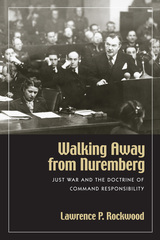 Walking Away from Nuremberg: Just War and the Doctrine of Command Responsibility
Lawrence P. Rockwood
University of Massachusetts Press, 2007 In September 1994, Lawrence P. Rockwood, then a counterintelligence officer with the U.S. Army's Tenth Mountain Division, was deployed to Haiti as part of Operation Restore Democracy, the American-led mission to oust the regime of Raoul Cedras and reinstall President Jean-Bertrand Aristide. Shortly after arriving in-country, Captain Rockwood began receiving reports of human rights abuses at the local jails, including the murder of political prisoners. He appealed to his superiors for permission to take action but was repeatedly turned down. Eventually, after filing a formal complaint with an army inspector general, he set off to inspect the jails on his own. The next day, Captain Rockwood found himself on a plane headed back to the United States, where he was tried by court-martial, convicted on several counts, and discharged from military service. In this book, Rockwood places his own experience within the broader context of the American military doctrine of "command responsibility"—the set of rules that holds individual officers directly responsible for the commission of war crimes under their authority. He traces the evolution of this doctrine from the Civil War, where its principles were first articulated as the "Lieber Code," through the Nuremberg trials following World War II, where they were reaffirmed and applied, to the present. Rockwood shows how in the past half-century the United States has gradually abandoned its commitment to these standards, culminating in recent Bush administration initiatives that in effect would shield American commanders and officials from prosecution for many war crimes. The Abu Ghraib and Guantánamo prison abuse scandals, the recently disclosed illegal CIA detention centers, the unprecedented policy of tolerating acts considered as torture by both international standards and U.S. military doctrine, and the recent cover-ups of such combat-related war crimes as the Haditha massacre of November 2005, all reflect an "official anti-humanitarian" trend, Rockwood argues, that is at odds with our nation's traditions and principles.
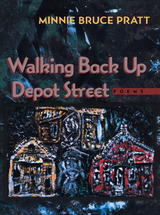 Walking Back Up Depot Street
Minnie Bruce Pratt
University of Pittsburgh Press, 1999 Selected as ForeWord Magazine’s 1999 Gay/Lesbian Book of the Year
In Pratt's fourth volume of poems, Walking Back Up Depot Street, we are led by powerful images into what is both a story of the segregated rural South and the story of a white woman named Beatrice who is leaving that home for the postindustrial North. Beatrice searches for the truth behind the public story-the official history-of the land of her childhood. She struggles to free herself from the lies she was taught while growing up-and she finds the other people who are also on this journey.
In these dramatically multivocal narrative poems, we hear the words and rhythms of Bible Belt preachers, African-American blues and hillbilly gospel singers, and sharecropper country women and urban lesbians. We hear the testimony of freed slaves and white abolitionists speaking against Klan violence, fragments of speeches by union organizers and mill workers, and snatches of songs from those who marched on the road to Selma. Beatrice walks back into the past and finds the history of resistance that she has never been taught; she listens to her fellow travelers as they all get ready to create the future.
Walking Backwards
Lee Sharkey
Tupelo Press, 2016 Walking Backwards examines resistance to violence and repression through evocations of contemporary events and conversations with poets and artists whose voices arise from the Holocaust. Employing a remarkable variety of formal strategies— lyrics, parables, testimony, paratactic narratives and re-castings of Torah stories, inter-leavings with other texts—these poems offer a complex vantage on cultural erasure and persistence. Sharkey conjures a simultaneous present to reclaim a heritage expressed by gaps and silencing. Paul Celan, Nelly Sachs, and the Yiddish language poets Abraham Sutzkever and Peretz Markish become contemporaries, as her words mingle with theirs to bear the weight of the unspoken. “What have we come for,” the poet asks, “to sleep where the dead slept in the bed of our absence?” What redemption she finds is in language.
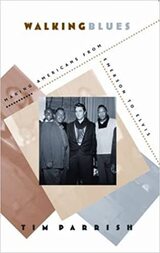 Walking Blues: Making Americans from Emerson to Elvis
Timothy Parrish
University of Massachusetts Press, 2009 Who or what is an American? Many scholars have recently argued that in a country of such vast cultural and ethnic diversity as the United States it is not useful or even possible to talk of a single national identity. Are people right to suggest that the very idea of "Americanness" is merely a myth designed to obscure the divisions among us?
This is the central question addressed by Tim Parrish in this imaginative interdisciplinary study. Working in the tradition of the blues, an art form based on the adaptation of cultural past to present, Parrish seeks to show what happens when we think of American identity not as some transcendental entity or essence, but as an ongoing process. At the core of his analysis is an appreciation of the rich legacy of pragmatism, a distinctly American frame of mind that sees truth as an act rather than an object, as a matter of doing rather than being. While the philosophical roots of pragmatism can be found in the writings of Ralph Waldo Emerson, William and Henry James, and Horace Kallen, the same intellectual approach informs the work of writers such as Ralph Ellison, Mary Antin, and Philip Roth as well as creative artists such as Son House, Elvis Presley, and James Brown. What all of these figures share, according to Parrish, is a recognition of the intrinsic connection between thought and action that has allowed Americans to define who they are through what they do.
Walking Blues accounts for our cultural diversity without either insisting that we are all the same or denying that we have anything in common. Far from glossing over difference, Parrish shows how our American social, racial, and ethnic conflicts often mark the starting point for the various acts of creation through which we make—and remake—ourselves as Americans.
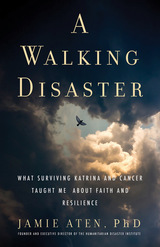 A Walking Disaster: What Surviving Katrina and Cancer Taught Me about Faith and Resilience
Jamie Aten
Templeton Press, 2020 Is there a meaning to our suffering? Is hope realistic when tragedy befalls us? Is a return to normalcy possible after our life is uprooted by catastrophe? These are the questions that disaster psychologist Dr. Jamie Aten wrestled with when he was diagnosed with Stage IV colon cancer. In this gripping memoir, Aten shares the life-affirming and faith-renewing insights that he discovered during his tumultuous struggle against the disease.
Aten’s journey began in 2005 when Hurricane Katrina struck his community. After witnessing the devastation wrought by the storm, he dedicated his career to investigating how people respond to and recover from all manner of disasters. He studied disaster zones around the globe and founded the Humanitarian Disaster Institute at Wheaton College. His expertise, however, was little comfort when a fateful visit with his oncologist revealed advanced and aggressive cancer. “You’re in for your own personal disaster” was his doctor’s prognosis.
Thrust into a battle for his life, with cancer cells and chemotherapy ravaging his body, Aten found his professional interest taking on new meaning. His ordeal taught him firsthand how we can sustain ourselves when burdened with seemingly unbearable suffering. Some of his counterintuitive insights include: to find hope, be cautious of optimism; when you want help the least is when you need it most; and spiritual surrender, rather than a passive act, is instead an act of profound courage.
This last point speaks to the element of grace in Dr. Aten’s story. As he struggled to understand the significance of his suffering, he found himself examining his Christian faith down to its bedrock and learned to experience the redeeming presence of God in his life. Dr. Aten has a natural exuberance that shines through his writing. Infused with his compassionate voice and humanitarian concern,
A Walking Disaster is ultimately an inspirational story about the power of the human spirit to endure trauma with courage.
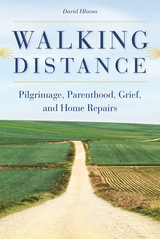 Walking Distance: Pilgrimage, Parenthood, Grief, and Home Repairs
David Hlavsa
Michigan State University Press, 2015 In the summer of 2000, David Hlavsa and his wife Lisa Holtby embarked on a pilgrimage. After trying for three years to conceive a child and suffering through the monthly cycle of hope and disappointment, they decided to walk the Camino de Santiago, a joint enterprise—and an act of faith—they hoped would strengthen their marriage and prepare them for parenthood.
Though walking more than 400 miles across the north of Spain turned out to be more difficult than they had anticipated, after a series of misadventures, including a brief stay in a Spanish hospital, they arrived in Santiago. Shortly after their return to Seattle, Lisa became pregnant, and the hardships of the Camino were no comparison to what followed: the stillbirth of their first son and Lisa’s harrowing second pregnancy.
Walking Distance is a moving and disarmingly funny book, a good story with a happy ending—the safe arrival of David and Lisa’s second son, Benjamin. David and Lisa get more than they bargained for, but they also get exactly what they wanted: a child, a solid marriage, and a richer life.
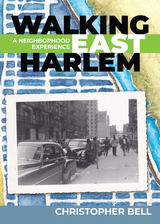 Walking East Harlem: A Neighborhood Experience
Christopher Bell
Rutgers University Press, 2025 They call it Spanish Harlem or sometimes just El Barrio. But for over a century, East Harlem has been a melting pot of many ethnic groups, including Puerto Rican, Dominican, Cuban, and Mexican immigrants, as well as Italian, Jewish, and African American communities. Though gentrification is rapidly changing the face of this section of upper Manhattan, it is still full of sites that attest to its rich cultural heritage.
Now East Harlem native Christopher Bell takes you on a tour of his beloved neighborhood. He takes you on three separate walking tours, each visiting a different part of East Harlem and each full of stories about its theaters, museums, art spaces, schools, community centers, churches, mosques, and synagogues. You’ll also learn about the famous people who lived in El Barrio, such as actress Cecily Tyson, opera singer Marian Anderson, portrait artist Alice Neel, incomparable poet Julia De Burgos, and King of Latin Music Tito Puente.
Lavishly illustrated with over fifty photos, Walking East Harlem points out not only the many architectural and cultural landmarks in the neighborhood but also the historical buildings that have since been demolished. Whether you are a tourist or a resident, this guide will give you a new appreciation for El Barrio’s exciting history, cultural diversity, and continued artistic vibrancy.
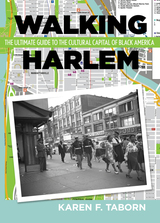 Walking Harlem: The Ultimate Guide to the Cultural Capital of Black America
Taborn, Karen
Rutgers University Press, 2018 With its rich cultural history and many landmark buildings, Harlem is not just one of New York’s most distinctive neighborhoods; it’s also one of the most walkable.
This illustrated guide takes readers on five separate walking tours of Harlem, covering ninety-one different historical sites. Alongside major tourist destinations like the Apollo Theater and the Abyssinian Baptist Church, longtime Harlem resident Karen Taborn includes little-known local secrets like Jazz Age speakeasies, literati, political and arts community locales. Drawing from rare historical archives, she also provides plenty of interesting background information on each location.
This guide was designed with the needs of walkers in mind. Each tour consists of eight to twenty-nine nearby sites, and at the start of each section, readers will find detailed maps of the tour sites, as well as an estimated time for each walk. In case individuals would like to take a more leisurely tour, it provides recommendations for restaurants and cafes where they can stop along the way.
Walking Harlem gives readers all the tools they need to thoroughly explore over a century’s worth of this vital neighborhood’s cultural, political, religious, and artistic heritage. With its informative text and nearly seventy stunning photographs, this is the most comprehensive, engaging, and educational walking tour guidebook on one of New York’s historic neighborhoods.
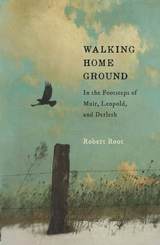 Walking Home Ground: In the Footsteps of Muir, Leopold, and Derleth
Robert Root
Wisconsin Historical Society Press, 2017 When longtime author Robert Root moves to a small town in southeast Wisconsin, he gets to know his new home by walking the same terrain traveled by three Wisconsin luminaries who were deeply rooted in place—John Muir, Aldo Leopold, and August Derleth. Root walks with Muir at John Muir State Natural Area, with Leopold at the Shack, and with Derleth in Sac Prairie; closer to home, he traverses the Ice Age Trail, often guided by such figures as pioneering scientist Increase Lapham. Along the way, Root investigates the changes to the natural landscape over nearly two centuries, and he chronicles his own transition from someone on unfamiliar terrain to someone secure on his home ground.In prose that is at turns introspective and haunting, Walking Home Ground inspires us to see history’s echo all around us: the parking lot that once was forest; the city that once was glacier. "Perhaps this book is an invitation to walk home ground," Root tells us. "Perhaps, too, it’s a time capsule, a message in a bottle from someone given to looking over his shoulder even as he tries to examine the ground beneath his feet."
Walking in Art Education: Ecopedagogical and A/r/tographical Encounters.
Edited by Nicole Rallis, Ken Morimoto, Michele Sorensen, Valerie Triggs, and Rita Irwin
Intellect Books, 2024 This edited collection highlights ways that arts-educators address learning with the land through walking practices across spatial, temporal, and cultural differences.
In Walking in Art Education, authors explore walking and a/r/tography in their local contexts. As a result, the book finds that kinship and relationality are significant themes that permeate across a/r/tographic practices focused on ecopedagogy and learning with the land. These walking practices serve as ecopedagogical moments that attune us to human-land and more-than-human relationships, while also moving us past Western-centric understandings of land and place. More than this, the book situates this work in a/r/tographic practices taking up walking as one method for engagement.
Walking in Cities: Quotidian Mobility as Urban Theory, Method, and Practice
Evrick Brown
Temple University Press, 2015 Walking connects the rhythms of urban life to the configuration of urban spaces. As the contributors and editors show in Walking in Cities, walking also reflects the systematic inequalities that order contemporary urban life. Walking has different meanings because it can be a way of temporarily “taking possession” of urban space, or it can make the relatively powerless more vulnerable to crime. The essays in Walking in Cities explore how walking intersects with sociological dimensions such as gender, race and ethnicity, social class, and power. Various chapters explorethe flâneuse, or female urban drifter, in Tehran’s shopping malls; Hispanic neighborhoods in New York, San Diego, and El Paso; and the intra-neighborhood and inter-class dynamics of gentrification in Greenpoint, Brooklyn.The essays in Walking in Cities provide important lessons about urban life.
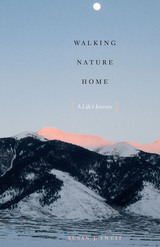 Walking Nature Home: A Life's Journey
By Susan J. Tweit
University of Texas Press, 2009 Without a map, navigate by the stars. Susan Tweit began learning this lesson as a young woman diagnosed with an autoimmune disease that was predicted to take her life in two to five years. Offered no clear direction for getting well through conventional medicine, Tweit turned to the natural world that was both her solace and her field of study as a plant ecologist. Drawing intuitive connections between the natural processes and cycles she observed and the functions of her body, Tweit not only learned healthier ways of living but also discovered a great truth—love can heal. In this beautifully written, moving memoir, she describes how love of the natural world, of her husband and family, and of life itself literally transformed and saved her own life. In tracing the arc of her life from young womanhood to middle age, Tweit tells stories about what silence and sagebrush, bird bones and sheep dogs, comets, death, and one crazy Englishman have to teach us about living. She celebrates making healthy choices, the inner voices she learned to hear on days alone in the wilderness, the joys of growing and eating an organic kitchen garden, and the surprising redemption in restoring a once-blighted neighborhood creek. Linking her life lessons to the stories she learned in childhood about the constellations, Tweit shows how qualities such as courage, compassion, and inspiration draw us together and bind us into the community of the land and of all living things.
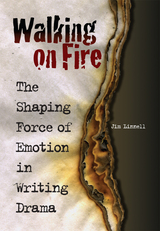 Walking on Fire: The Shaping Force of Emotion in Writing Drama
Jim Linnell
Southern Illinois University Press, 2011 In this bold new way of looking at dramatic structure, Jim Linnell establishes the central role of emotional experience in the conception, execution, and reception of plays. Walking on Fire: The Shaping Force of Emotion in Writing Drama examines dramatic texts through the lens of human behavior to identify the joining of event and emotion in a narrative, defined by Linnell as emotional form.Effectively building on philosophy, psychology, and critical theory in ways useful to both scholars and practitioners, Linnell unfolds the concept of emotional form as the key to understanding the central shaping force of drama. He highlights the Dionysian force of human emotion in the writer as the genesis for creative work and articulates its power to determine narrative outcomes and audience reaction.Walking on Fire contains writing exercises to open up playwrights to the emotional realities and challenges of their work. Additionally, each chapter offers case studies of traditional and nonlinear plays in the known canon that allow readers to evaluate the construction of these works and the authors’ practices and intentions through an xamination of the emotional form embedded in the central characters’ language, thoughts, and behaviors. The plays discussed include Henrik Ibsen’s A Doll’s House, William Shakespeare’s Hamlet, Athol Fugard’s “MASTER HAROLD”. . .and the boys, Donald Margulies’s The Loman Family Picnic, Harold Pinter’s The Birthday Party, and Tony Kushner’s Angels in America.
Walking on Fire opens up new conversations about content and emotion for writers and offers exciting answers to the questions of why we make drama and why we connect to it. Linnell’s userfriendly theory and passionate approach create a framework for understanding the links between the writer’s work in creating the text, the text itself, and the audience’s engagement.
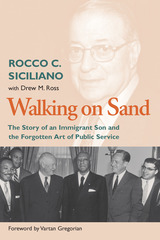 Walking On Sand: The Story of an Immigrant Son and the Forgotten Art of Public Service
Rocco C Siciliano
University of Utah Press, 2004
Rocco C. Siciliano broke new ground as the first Italian-American to serve in the White House as an assistant to the president, Dwight D. Eisenhower. At 31, "Ike’s Youngest" attained a prominence not suggested in his humble beginnings in Salt Lake City, Utah. But his upbringing in the Mormon-dominated community, where he balanced the heritage of his striving immigrant parents with his own aspirations for success, prepared him for a wide variety of service. This service includes leading a special weapons platoon in the 10th Mountain Division in World War II, bringing Martin Luther King Jr. to meet with President Eisenhower, and becoming a recognized business leader in California.
Siciliano used his expertise in labor, personnel management, and business to contribute substantively to the J. Paul Getty Center, the Los Angeles Philharmonic Association, the Committee for Economic Development, and the "Volcker" Commission on Public Service, among others.
The variety of Siciliano’s experiences reinvigorates our understanding of the forgotten art of public service. Walking on Sand emphasizes the role that public service can play for corporations, communities, states, and the nation. This story is a gift from the Greatest Generation to the many people who serve America today and will serve her tomorrow.
 Walking on the Wild Side: Long-Distance Hiking on the Appalachian Trail
Fondren, Kristi M
Rutgers University Press, 2015 Received the 2016 Theodore and Franklin Roosevelt Award for Excellence in Recreation and Park Research from the National Recreation and Park Association
The most famous long-distance hiking trail in North America, the 2,181-mile Appalachian Trail—the longest hiking-only footpath in the world—runs along the Appalachian mountain range from Georgia to Maine. Every year about 2,000 individuals attempt to “thru-hike” the entire trail, a feat equivalent to hiking Mount Everest sixteen times. In Walking on the Wild Side, sociologist Kristi M. Fondren traces the stories of forty-six men and women who, for their own personal reasons, set out to conquer America’s most well known, and arguably most social, long-distance hiking trail.
In this fascinating in-depth study, Fondren shows how, once out on the trail, this unique subculture of hikers lives mostly in isolation, with their own way of acting, talking, and thinking; their own vocabulary; their own activities and interests; and their own conception of what is significant in life. They tend to be self-disciplined, have an unwavering trust in complete strangers, embrace a life of poverty, and reject modern-day institutions. The volume illuminates the intense social intimacy and bonding that forms among long-distance hikers as they collectively construct a long-distance hiker identity. Fondren describes how long-distance hikers develop a trail persona, underscoring how important a sense of place can be to our identity, and to our sense of who we are. Indeed, the author adds a new dimension to our understanding of the nature of identity in general.
Anyone who has hiked—or has ever dreamed of hiking—the Appalachian Trail will find this volume fascinating. Walking on the Wild Side captures a community for whom the trail is a sacred place, a place to which they have become attached, socially, emotionally, and spiritually.
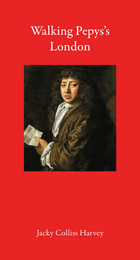 Walking Pepys's London
Jacky Colliss Harvey
Haus Publishing, 2022 Brings to life the world of Samuel Pepys with five walks through London.
Samuel Pepys, the seventeenth century's best-known diarist, walked around London for miles, chronicling these walks in his diary. He made the two-and-a-half-mile trek to Whitehall from his house near the Tower of London on an almost daily basis. These streets, where many of his professional conversations took place while walking, became for him an alternative to his office.
With Walking Pepys’s London, we come to know life in London from the pavement up and see its streets from the perspective of this renowned diarist. The city was a key character in Pepys’s life, and this book draws parallels between his experience of seventeenth-century London and the lives of Londoners today. Bringing together geography, biography, and history, Jacky Colliss Harvey reconstructs the sensory and emotional experience of Pepys’s time. Full of fascinating details, Walking Pepys’s London is a sensitive exploration into the places that made the greatest English diarist of all time.
Walking Shadows: Orson Welles, William Randolph Hearst, and Citizen Kane
John Evangelist Walsh
University of Wisconsin Press, 2004 Walking Shadows dramatically dissects the wild, high-profile battle between newspaper tycoon William Randolph Hearst and famous young actor, director, and filmmaker Orson Welles over Welles’s groundbreaking film Citizen Kane. In 1940 and 1941 it became the center of public controversy and scandal, especially in Hollywood where Welles’s own stark honesty and blatant self-confidence heightened the drama.
Citizen Kane portrayed the ruthless career of an all-powerful magnate bearing (not accidentally) a striking resemblance to Hearst, who immediately tried to kill the picture. John Evangelist Walsh here illuminates the conflict between these two outsize personalities and for the first time brings Hearst’s vengeful anti-Kane campaign to the fore. Walsh provides thorough documentation, supplemental notes, and an extended bibliography.
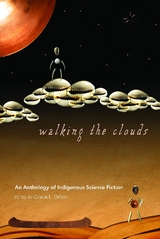 Walking the Clouds: An Anthology of Indigenous Science Fiction
Edited by Grace L. Dillon
University of Arizona Press, 2012 In this first-ever anthology of Indigenous science fiction Grace Dillon collects some of the finest examples of the craft with contributions by Native American, First Nations, Aboriginal Australian, and New Zealand Maori authors. The collection includes seminal authors such as Gerald Vizenor, historically important contributions often categorized as "magical realism" by authors like Leslie Marmon Silko and Sherman Alexie, and authors more recognizable to science fiction fans like William Sanders and Stephen Graham Jones. Dillon's engaging introduction situates the pieces in the larger context of science fiction and its conventions.
Organized by sub-genre, the book starts with Native slipstream, stories infused with time travel, alternate realities and alternative history like Vizenor's "Custer on the Slipstream." Next up are stories about contact with other beings featuring, among others, an excerpt from Gerry William's The Black Ship. Dillon includes stories that highlight Indigenous science like a piece from Archie Weller's Land of the Golden Clouds, asserting that one of the roles of Native science fiction is to disentangle that science from notions of "primitive" knowledge and myth. The fourth section calls out stories of apocalypse like William Sanders' "When This World Is All on Fire" and a piece from Zainab Amadahy's The Moons of Palmares. The anthology closes with examples of biskaabiiyang, or "returning to ourselves," bringing together stories like Eden Robinson's "Terminal Avenue" and a piece from Robert Sullivan's Star Waka.
An essential book for readers and students of both Native literature and science fiction, Walking the Clouds is an invaluable collection. It brings together not only great examples of Native science fiction from an internationally-known cast of authors, but Dillon's insightful scholarship sheds new light on the traditions of imagining an Indigenous future.
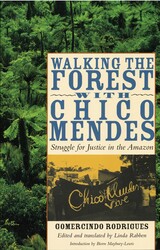 Walking the Forest with Chico Mendes: Struggle for Justice in the Amazon
By Gomercindo Rodrigues, Edited and translated by Linda Rabben
University of Texas Press, 2007 A close associate of Chico Mendes, Gomercindo Rodrigues witnessed the struggle between Brazil's rubber tappers and local ranchers—a struggle that led to the murder of Mendes. Rodrigues's memoir of his years with Mendes has never before been translated into English from the Portuguese. Now, Walking the Forest with Chico Mendes makes this important work available to new audiences, capturing the events and trends that shaped the lives of both men and the fragile system of public security and justice within which they lived and worked. In a rare primary account of the celebrated labor organizer, Rodrigues chronicles Mendes's innovative proposals as the Amazon faced wholesale deforestation. As a labor unionist and an environmentalist, Mendes believed that rain forests could be preserved without ruining the lives of workers, and that destroying forests to make way for cattle pastures threatened humanity in the long run. Walking the Forest with Chico Mendes also brings to light the unexplained and uninvestigated events surrounding Mendes's murder. Although many historians have written about the plantation systems of nineteenth-century Brazil, few eyewitnesses have captured the rich rural history of the twentieth century with such an intricate knowledge of history and folklore as Rodrigues.
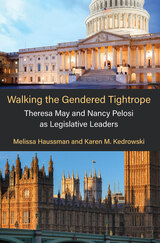 Walking the Gendered Tightrope: Theresa May and Nancy Pelosi as Legislative Leaders
Melissa Haussman and Karen M. Kedrowski
University of Michigan Press, 2023 Walking the Gendered Tightrope analyzes the gendered expectations for women in high offices through the examples of British Prime Minister Theresa May and U.S. Speaker of the House Nancy Pelosi. Even at their highest positions, and while completing their greatest achievements, both May and Pelosi faced gendered critiques and intraparty challenges to their leadership. While other books have analyzed the barriers to higher office that women face, this book reveals how women in positions of power are still forced to balance feminine stereotypes with the perception of power as masculine in order to prove their legitimacy. By examining intraparty dynamics, this book offers a unique comparison between a majoritarian presidential and Westminster parliamentary system. While their parties promoted Pelosi and May to highlight their progressive values, both women faced continually gendered critiques about their abilities to lead their caucuses on difficult policy issues, such as the Affordable Care Act and two Trump impeachment votes for Nancy Pelosi, or finishing Brexit for Theresa May. Grounded in the legislative literature from the United States and Britain, as well as historical accounts and personal interviews, Walking the Gendered Tightrope contributes to the fields of gender and politics, legislative studies, American politics, and British politics.
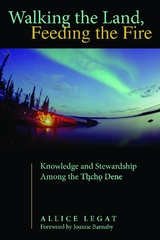 Walking the Land, Feeding the Fire: Knowledge and Stewardship Among the Tlicho Dene
By Allice Legat; Foreword by Joanne Barnaby
University of Arizona Press, 2012 In the Dene worldview, relationships form the foundation of a distinct way of knowing. For the Tlicho Dene, indigenous peoples of Canada's Northwest Territories, as stories from the past unfold as experiences in the present, so unfolds a philosophy for the future. Walking the Land, Feeding the Fire vividly shows how—through stories and relationships with all beings—Tlicho knowledge is produced and rooted in the land. Tlicho-speaking people are part of the more widespread Athapaskan-speaking community, which spans the western sub-arctic and includes pockets in British Columbia, Alberta, California, and Arizona. Anthropologist Allice Legat undertook this work at the request of Tlicho Dene community elders, who wanted to provide younger Tlicho with narratives that originated in the past but provide a way of thinking through current critical land-use issues. Legat illustrates that, for the Tlicho Dene, being knowledgeable and being of the land are one and the same.
Walking the Land, Feeding the Fire marks the beginning of a new era of understanding, drawing both connections to and unique aspects of ways of knowing among other Dene peoples, such as the Western Apache. As Keith Basso did with his studies among the Western Apache in earlier decades, Legat sets a new standard for research by presenting Dene perceptions of the environment and the personal truths of the storytellers without forcing them into scientific or public-policy frameworks. Legat approaches her work as a community partner—providing a powerful methodology that will impact the way research is conducted for decades to come—and provides unique insights and understandings available only through traditional knowledge.
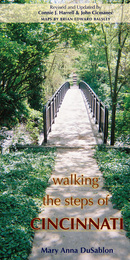 Walking the Steps Of Cincinnati: A Guide to the Queen City’s Scenic and Historic Secrets
Mary Anna DuSablon
Ohio University Press, 2014 Walking the Steps of Cincinnati: A Guide to the Queen City’s Scenic and Historic Secrets is a revised and updated version of Mary Anna DuSablon’s original guidebook, first published in 1998. This new edition describes and maps thirty-four walks of varying lengths and levels of difficulty around the neighborhoods of Cincinnati, following scenic or historic routes and taking in many of the city’s more than four hundred sets of steps. Some of these walks follow the same routes laid out by DuSablon in the first edition of the guide; others have been revised to reflect changes in the city and its neighborhoods, the physical condition of the steps, and the scenic views of Cincinnati that they afford; and still others are altogether new. In writing their descriptions of the walks, authors Connie J. Harrell and John Cicmanec have retraced each path and taken all new photographs of the steps as well as architectural and natural landmarks along the way. Cartographer Brian Balsley has drawn a fresh set of maps, and Roxanne Qualls, vice-mayor of Cincinnati, has graciously written a new foreword.
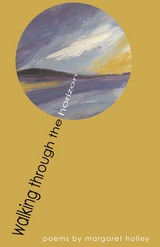 Walking Through the Horizon: Poems
Margaret Holley
University of Arkansas Press, 2006 Attachment to the familiar and the challenge of leaving it for new horizons link the poems in this collection by Margaret Holley. The poems are full of feeling and wisdom in equal parts, and are enriched and informed by the poet’s landscape, whether it is Switzerland or Arizona. The landscape, in fact, becomes a kind of mirror we gaze into to see the future that at every turn is approaching and moving through us to illuminate the past. The journey of this book shows how the conditions of our lives are illumined by our cultural forbears—Goethe, Chopin, Nietzsche, Bonnard, Klee—by the heritage of personal memory, and by the ever amazing “book of nature.” A book remarkable for the complete authenticity of its feeling and candor, Walking Through the Horizon shows us the simultaneity of the past and the future and is grounds for hopefulness and joy: “These are gifts worth passing on: / the beckoning vista, the sudden frontier, / the rivers of days and years to come.”
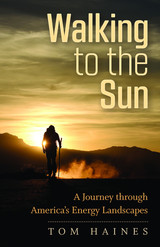 Walking to the Sun: A Journey through America's Energy Landscapes
Tom Haines
University Press of New England, 2018 On a winter day in 2013, Tom Haines stood in front of his basement furnace and wondered about the source of the natural gas that fueled his insulated life. During the next four years, Haines, an award-winning journalist and experienced wanderer, walked hundreds of miles through landscapes of fuel—oil, gas, and coal, and water, wind, and sun—on a crucial exploration of how we live on Earth in the face of a growing climate crisis. Can we get from the fossil fuels of today to the renewables of tomorrow? The story Haines tells in Walking to the Sun is full not only of human encounters—with roustabouts working on an oil rig, farmers tilling fields beneath wind turbines, and many others—but also of the meditative range that arrives with solitude far from home. Walking to the Sun overcomes the dislocation of our industrial times to look closely at the world around us and to consider what might come next.
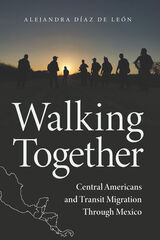 Walking Together: Central Americans and Transit Migration Through Mexico
Alejandra Díaz de León
University of Arizona Press, 2023 Migration through Mexico is violent and uncertain, yet in Walking Together we see how this experience bonds some people together like family even though they may not have started that way before the journey.
Migrants in transit form several types of social networks, develop trust, and engage in acts of solidarity. The need to be recognized and grieved, compounded by the practical use of pooling information and resources, leads migrants to form small, strong groups called road families. Through the generalized sharing of information and small items such as food and blankets, migrants also form a transient community that includes everyone on the road at the same time. Sociologist Alejandra Díaz de León shows the trajectories of families that left together, showing, surprisingly, that families might not be the best social arrangement in transit.
Drawing on multisited research, this work contributes to debates on the role of social networks in clandestine migration processes and to discussions on how people create social networks and trust under violent and stressful situations. The detailed ethnographic narratives and accessible writing weave together theory with empirical observations to highlight and humanize the migrant experience.
Sitting at the intersection of border studies, immigration studies, and Latinx studies, this concise volume shows how Central American migrants in transit through Mexico survive the precarious and unpredictable road by forming different types of social ties.
Walking Towards Walden: A Pilgrimage in Search of Place
John Hanson Mitchell
University Press of New England, 2015 Walking Towards Walden is an exploration of the sense of place, what it means, how it developed, and why it matters. Based on an eighteenth-century literary device in which a group of friends undertake a walking tour and discuss a certain subject, this wide-ranging story emerges from the author’s fifteen-mile bushwhack through woods, backyards, and marshes—from a hilltop in Westford, Massachusetts, to the town of Concord, Massachusetts—trespassing all along the way. A mock epic, complete with encounters with armed mercenaries and vicious dogs, the book covers all the aspects of place—art, literature, myth, and even music.
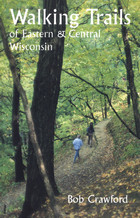 Walking Trails of Eastern and Central Wisconsin
Bob Crawford
University of Wisconsin Press, 1997 The sheer physical beauty and varied landscapes of eastern and central Wisconsin are best experienced on its walking trails. Walking Trails of Eastern and Central Wisconsin is a handy guide to trails that wind through the streets of old Milwaukee and the forests of the Kettle Moraine, across the Niagara Escarpment, along the shores of picturesque Door County, or up the sandstone mound at Lone Rock for a panoramic view of flatlands that once were the bed of glacial Lake Wisconsin.
A companion to the popular Walking Trails of Southern Wisconsin, this book describes more than 200 trails in 72 locations throughout five of the state's major regions. Bob Crawford provides maps and detailed instructions to make the trails easy to locate.
With each trail description you'll find:
* details about the route and terrain, as well as geographical, biological, or historical features of interest;
* regulations including open days and hours, and rules regarding dogs, trail bikes, cross-country skiing, and other activities;
* information about available restrooms, drinking water, nature centers, and other facilities at the site;
* a description assessing degree of difficulty—slope, width, maintenance, and other such factors—and a helpful rating of "walkability" on a scale from 1 to 5.
The only comprehensive guide to hiking locations in the eastern part of the state, this book also provides lists of trail locations that include playground equipment for kids and picnic facilities for those who want to make a day trip of their hiking outing. Appendices spotlight trails that boast historical significance, ice age features, picnic areas, and cross-country skiing opportunities.
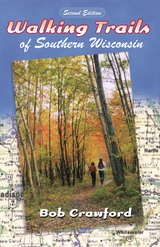 Walking Trails of Southern Wisconsin
Bob Crawford
University of Wisconsin Press, 2000 Take a walk on the wild side with the completely updated version of this popular guide.
This edition now includes coverage of Lafayette and Vernon counties, plus new information on more trails, including ones at Avoca Prairie Savanna State Natural Area, Wildcat Mountain State Park, and Blackhawk Lake Recreational Area. Author Bob Crawford has also revised eleven trail maps in nine counties and updated material throughout the book, which now describes more than 150 trails at more than sixty locations.
These trails wind across southern Wisconsin—into forests and along shores, over glacial formations and around Native American earthworks—and showcase some of the most beautiful and interesting walking trails in the nation. Walking Trails of Southern Wisconsin retains its handy, pocket-sized format plus all the other features that made the first edition so successful: • details about routes and terrain plus geographical, biological, or historical features of interest
• regulations including open days and hours, and rules regarding dogs, trail bikes, cross-country skiing, and other activities
• information about available restrooms, drinking water, nature centers, and other facilities at the site
• a description assessing degree of difficulty—slope, width, maintenance, and other such factors—and a helpful rating of “walkability” on a scale from 1 to 5 Crawford also provides information about nearby parks, preserves, glacial formations, historical sites, tourist attractions, and other points of interest for those who want to turn a hike into a day trip or weekend outing. Staying fit was never so easy nor so much fun.
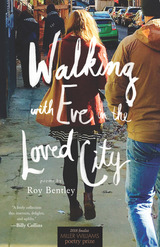 Walking with Eve in the Loved City: Poems
Roy Bentley
University of Arkansas Press, 2018 Finalist, 2018 Miller Williams Poetry Prize Walking with Eve in the Loved City is an ambitious collection. Using a variety of male figures—Jeff Goldblum, Ringo Starr, the poet’s uncle Billy, to name a few—these poems skillfully interrogate masculinity and its cultural artifacts, searching for a way to reconcile reverence for the father figure with a crisis of faith about the world as run by men. And yet, despite the gravity of the subjects these poems engage, this is a hopeful, frequently funny book that encourages the reader to look deeply at the world, and then to laugh if she can. Roy Bentley often accomplishes this work through a careful balancing of honesty and misdirection, as when in the poem “Can’t Help Falling in Love” the real drama of the narrative—the appearance of an affair between the speaker’s father and a drive-in restaurant carhop—operates as a backdrop for the eight-year-old speaker’s puerile attraction to the woman; or when the vampire Nosferatu (a frequent figure in the poems) materializes in a trailer park, his immortality becoming a lens through which to process the speaker’s righteous anger about wealth and poverty. God too features prominently—as does doubt. Drawing from the vernacular of his childhood, Bentley accesses the simultaneous austerity and lyrical opulence of the King James Bible to invent stories in which the last note struck is often a call to pay kinder attention. More than anything, these poems serve as humanistic advocates, using the power of narrative—film, interview, imagination, memoir—to highlight how people matter. Walking with Eve in the Loved City invites the reader to join in this watching and witnessing, to take part in renewing how we see.
 Walking with Jesus Christ: Catholic and Evangelical Visions of the Moral Life
Steven Hoskins
Saint Paul Seminary Press , 2023 Walking with Jesus Christ: Catholic and Evangelical Visions of the Moral Life is the collected essays and consensus statements of the second round of the National Evangelical-Catholic Dialogue. In 2021 the National Evangelical-Catholic Dialogue completed its four-year round of discussion on the moral life, at the University of St. Thomas in St. Paul, MN. Sessions were held each year on the following topics. In 2017, the dialogue discussed the norms governing the moral life. In 2018, the dialogue discussed sexual ethics. In 2019, the dialogue discussed social ethics. Finally, in 2021 the dialogue discussed the relationship of the moral life to eschatology. At each of the annual meetings, members presented background papers that formed the basis of that meeting’s discussion and became starting points for constructing a common statement. These common statements and background papers make up this book. The members of the dialogue hope this book will provide a fruitful starting point for future conversations between evangelicals and Catholics.
The Catholic essays begin with the contributions of Catholic theologians Daniel Keating, William Stevenson and Christian Washburn, who examine the various norms for Catholic moral theology including the role of Scripture, tradition, magisterium, and natural law (2017). David Fleischacker, Daniel Keating, and Christian Washburn examine the morality of marriage, contraception, abortion, and homosexual acts (2018). Daniel Keating and William Stevenson discuss social ethics, including Catholic social teaching and socialism (2019). David Fleischacker and Christian Washburn discuss the relationship of the moral life to our final beatific end (2020).
The Evangelical essays begin with the contribution of Evangelical theologians Bruce Cromwell and Dennis Jowers who explore the norms of Protestant Ethics (2017). David Van Drunen and Luke Geraty discuss sexual ethics from different ends of the Evangelical perspective (2018). Glen Menzies and Steve Hoskins evaluate approaches to evangelical social ethics from Pentecostal and Wesleyan points of view (2019). Bruce Cromwell and Steve Hoskins discuss the notions of eschatology and ethics from a Wesleyan viewpoint (2020).
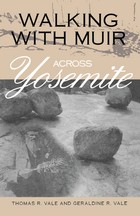 Walking with Muir across Yosemite
Thomas R. Vale
University of Wisconsin Press, 1998 Does today’s visitor trekking Yosemite National Park find it much different from what John Muir encountered a century ago? Thomas and Geraldine Vale retrace Muir’s path, based upon journal descriptions of his activities and experiences during his first summer in the Sierra Nevada Mountains. From the foothills through Yosemite Valley and on up to the Tuolumne Meadows, the Vales follow the present roads and trails that crossed Muir’s route, imagining his reaction to the landscape while reflecting on the natural world in both his time and ours.
Illustrated with drawings by John Muir and drawings and photos by the Vales, Walking with Muir across Yosemite emphasizes that current visitors to Yosemite—indeed to any national park—can still experience the solitude, wildness, and romanticism of nature. They believe, however, that this modern exploration would benefit from a national parks policy that actively promotes nature study and encourages a more profound interaction between humans and the natural world.
Walking with the Wind
Abbas Kiarostami
Harvard University Press This bilingual edition of recent verse by the celebrated Iranian filmmaker Abbas Kiarostami (award-winning director of such films as Close-Up and Taste of Cherry) includes English translations of more than two hundred crystalline, haiku-like poems, together with their Persian originals. The translators, noted Persian literature scholars Ahmad Karimi-Hakkak and Michael Beard, contribute an illuminating introduction to Kiarostami's poetic enterprise, examining its relationship to his unique cinematic corpus and to the traditions of classic and contemporary Persian poetry.
Of interest to enthusiasts of cinema and literature alike, Walking with the Wind—the second volume in Harvard Film Archive's series "Voices and Visions in Film"—sheds light on a contemporary master who transforms simple fragments of reality into evocative narrative landscapes.
 The Walking Wounded: Festering and Ricocheting Trauma After Gun Violence
Jooyoung Lee
University of Chicago Press A sobering encounter with lives transformed by gun violence and an urgent call to build more comprehensive systems to care for wounded people.
Gun violence is a plague in the United States; even survivors experience suffering that wreaks havoc on their lives and our communities. Although excellent emergency trauma care means that eighty percent of shooting victims do not die from their injuries, surviving is only the first step. Most find themselves trapped in a healthcare and judicial system that only amplifies their pain, trauma, and uncertainty.
In The Walking Wounded, Jooyoung Lee invites readers into the hospitals, courtrooms, and porches where gunshot victims struggle to rebuild their lives. Drawing from years of fieldwork in Philadelphia, Lee shows how victims’ injuries fester into new problems over time in the absence of meaningful follow-up care. Attempting routine tasks with a wounded body reminds survivors that they are no longer who they used to be—both physically and socially. Lee shows how trauma ricochets through a victim’s world as family and friends are also affected by their injuries. To make matters worse, Lee argues that existing government safety nets place victims into ever more precarious circumstances that compound their suffering.
In the face of healthcare and judicial systems that fail wounded people, Lee urges a sensible and sensitive rehabilitative process aimed at equipping the walking wounded with ongoing care that aspires for more than mere survival: regaining independent lives.
Walking, Writing and Performance: Autobiographical Texts by Deirdre Heddon, Carl Lavery and Phil Smith
Edited by Roberta Mock
Intellect Books, 2009 This collection charts three projects by performers who generate autobiographical writing by walking through inspirational landscapes. Included in the book are the full texts of The Crab Walks and Crab Steps Aside by Phil Smith, Mourning Walk by Carl Lavery, and Tree by Deirdre Heddon, each accompanied by photographs and contextual essays. Taken together or separately, the work of all three artist-scholars raises important issues about memory, the ethics of autobiographical performance, ritual, life writing, and site-specific performance.
The Wall
Ilan Stavans
University of Pittsburgh Press, 2018 The Wall is a poetic exploration—across time, space, and language, real as well as metaphorical—of the U.S.-Mexican wall dividing the two civilizations, of similar walls (Jerusalem, China, Berlin, Warsaw, etc.) in history, and of the act of separating people by ideology, class, race, and other subterfuges. It is an indictment of hateful political rhetoric. In the spirit of Virgil’s Aeneid and Spoon River Anthology by Edgar Lee Master, it gives voice in symphonic fashion to an assortment of participants (immigrants, border patrol, soldiers, activists, presidents, people dead and alive) involved in the debate on walls. It brings in elements of literature and pop culture, fashion and cuisine. Poetry becomes a tool to explore raw human emotions in all its extremes.
 The Wall and the Garden: Selected Massachusetts Election Sermons, 1670-1775
A.W. Plumstead, Editor
University of Minnesota Press, 1968 The Wall and the Garden was first published in 1968. Minnesota Archive Editions uses digital technology to make long-unavailable books once again accessible, and are published unaltered from the original University of Minnesota Press editions. The election day sermon in colonial New England was an annual, formal address by a minister of the gospel to the newly assembled legislature of the colony. The tradition began in the Massachusetts Bay colony in 1634, and it continued, in Boston, for 250 years. In this volume, Professor Plumstead presents a collection of nine of the Massachusetts election sermons, chosen from among the surviving Massachusetts sermons which were printed between 1661 and 1775. They are not chosen as representative but, rather, as the best, judged on a basis of literary excellence and ideas and points of style relevant to later developments in American literature and history. There are changes in style and theme in the 105 years between the first and the last selection, and, in his brief introduction to each of the sermons, the editor discusses these changes and the sermon's relationship to the tradition as a whole. In a general introduction, Professor Plumstead provides background information about the history and significance of the election sermons. As he makes clear, the election sermon tradition offers a vantage point for seeing both continuity and change in colonial intellectual history. The sermons in this collection will complement colonial studies by bringing the reader close to the spirit of the times. The title of the volume, The Wall and the Garden, derives from the frequent use by colonial preachers of the metaphors of the garden and the wall to describe the colonies and their spiritual enemies.
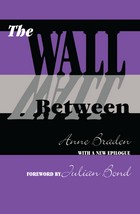 The Wall Between
Anne Braden
University of Tennessee Press, 1999 "The Wall Between is a chilling depiction of a pattern repeated over and over again across the South as brave Blacks and whites tried to breach the barrier between the races. . . . We need to know Anne Braden's story, perhaps even more in 1999 than when she wrote it in 1957." —from the foreword by Julian Bond
In 1954, Anne and Carl Braden bought a house in an all-white neighborhood in Louisville, Kentucky, on behalf of a black couple, Andrew and Charlotte Wade. The Wall Between is Anne Braden's account of what resulted from this act of friendship: mob violence against the Wades, the bombing of the house, and imprisonment for her husband on charges of sedition.
A nonfiction finalist for the 1958 National Book Award, The Wall Between is one of only a few first-person accounts from civil rights movement activists—even rarer for its author being white. Offering an insider's view of movement history, it is as readable for its drama as for its sociological importance. It contains no heroes or villains, according to Braden—only people urged on by forces of history that they often did not understand.
In an epilogue written for this edition, the author traces the lives of the Bradens and Wades subsequent to events in the original book and reports on her and her husband's continuing activities in the Civil Rights movement, including reminiscences of their friendship with Martin Luther King. Looking back on that history, she warns readers that the entire nation still must do what white Southerners did in the 1950s to ensure equal rights: turn its values, assumptions, and policies upside down.
In his foreword to this edition, Julian Bond reflects on the significance of the events Anne describes and the importance of the work the Bradens and others like them undertook. What's missing today, he observes, is not Wades who want a home but Bradens who will help them fight for one. Anne and Carl Braden showed that integrated groups fight best for an integrated world, and The Wall Between is a lasting testament to that dedication.
The Author: Ann Braden was born in Louisville, Kentucky, and worked as a newspaper reporter and a public relations agent for trade unions. She served as a delegate to the 1984 and 1988 Democratic National Conventions and has been a visiting professor at Northern Kentucky University, where she teaches civil rights history. She continues to work with the Kentucky Alliance against Racial and Political Repression.
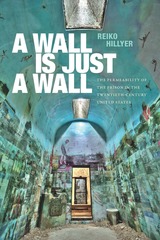 A Wall Is Just a Wall: The Permeability of the Prison in the Twentieth-Century United States
Reiko Hillyer
Duke University Press, 2024 Throughout the twentieth century, even the harshest prison systems in the United States were rather porous. Incarcerated people were regularly released from prison for Christmas holidays; the wives of incarcerated men could visit for seventy-two hours relatively unsupervised; and governors routinely commuted the sentences of people convicted of murder. By the 1990s, these practices had become rarer as politicians and the media—in contrast to corrections officials—described the public as potential victims who required constant protection against the threat of violence. In A Wall Is Just a Wall Reiko Hillyer focuses on gubernatorial clemency, furlough, and conjugal visits to examine the origins and decline of practices that allowed incarcerated people to transcend prison boundaries. Illuminating prisoners’ lived experiences as they suffered, critiqued, survived, and resisted changing penal practices, she shows that the current impermeability of the prison is a recent, uneven, and contested phenomenon. By tracking the “thickening” of prison walls, Hillyer historicizes changing ideas of risk, the growing bipartisan acceptance of permanent exile and fixing the convicted at the moment of their crime as a form of punishment, and prisoners’ efforts to resist.
The Wall Jumper: A Berlin Story
Peter Schneider
University of Chicago Press, 1998 "Schneider's characters, like Kundera's, are sentient and sophisticated figures at a time when the constraints of Communist rule persist but its energy has entirely vanished."—Richard Eder, Los Angeles Times Book Review
When the Berlin Wall was still the most tangible representation of the Cold War, Peter Schneider made this political and ideological symbol into something personal, that could be perceived on a human level, from more than one side. In Schneider's Berlin, real people cross the Wall not to defect but to quarrel with their lovers, see Hollywood movies, and sometimes just because they can't help themselves—the Wall has divided their emotions as much as it has their country.
"An honest, rich book. . . . It is one those rare books that come back at odd moments to intrude on your comfortable conclusions and easy images."—Robert Houston, Nation
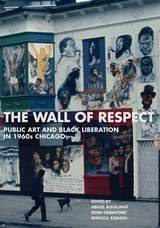 The Wall of Respect: Public Art and Black Liberation in 1960s Chicago
Edited by Abdul Alkalimat, Romi Crawford, and Rebecca Zorach
Northwestern University Press, 2017 The Wall of Respect: Public Art and Black Liberation in 1960s Chicago is the first in-depth, illustrated history of a lost Chicago monument. The Wall of Respect was a revolutionary mural created by fourteen members of the Organization of Black American Culture (OBAC) on the South Side of Chicago in 1967. This book includes photographs by Darryl Cowherd, Bob Crawford, Roy Lewis, and Robert A. Sengstacke, and gathers historic essays, poetry, and previously unpublished primary documents from the movement’s founders that provide a guide to the work’s creation and evolution.
The Wall of Respect received national critical acclaim when it was unveiled on the side of a building at Forty-Third and Langley in Chicago’s Bronzeville neighborhood. Painters and photographers worked side by side on the mural's seven themed sections, which featured portraits of Black heroes and sheroes, among them John Coltrane, Nina Simone, Billie Holiday, Malcolm X, Muhammad Ali, and W. E. B. Du Bois. The Wall became a platform for music, poetry, and political rallies. Over time it changed, reflecting painful controversies among the artists as well as broader shifts in the Civil Rights and Black Liberation Movements.
At the intersection of African American culture, politics, and Chicago art history, The Wall of Respect offers, in one keepsake-quality work, an unsurpassed collection of images and essays that illuminate a powerful monument that continues to fascinate artists, scholars, and readers in Chicago and across the United States.
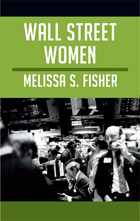 Wall Street Women
Melissa S. Fisher
Duke University Press, 2012 Wall Street Women tells the story of the first generation of women to establish themselves as professionals on Wall Street. Since these women, who began their careers in the 1960s, faced blatant discrimination and barriers to advancement, they created formal and informal associations to bolster one another's careers. In this important historical ethnography, Melissa S. Fisher draws on fieldwork, archival research, and extensive interviews with a very successful cohort of first-generation Wall Street women. She describes their professional and political associations, most notably the Financial Women's Association of New York City and the Women's Campaign Fund, a bipartisan group formed to promote the election of pro-choice women. Fisher charts the evolution of the women's careers, the growth of their political and economic clout, changes in their perspectives and the cultural climate on Wall Street, and their experiences of the 2008 financial collapse. While most of the pioneering subjects of Wall Street Women did not participate in the women's movement as it was happening in the 1960s and 1970s, Fisher argues that they did produce a "market feminism" which aligned liberal feminist ideals about meritocracy and gender equity with the logic of the market.
Wall To Wall America: Post Office Murals in the Great Depression
Karal Ann Marling
University of Minnesota Press, 2000 A revealing cultural history of this American art form. In her intriguing and heavily illustrated look at post office murals of the 1930s, Karal Ann Marling examines these unique government-sponsored works of art not only as paintings but as part of American cultural history. Depicting scenes from the farm, the frontier, and the factories, these murals were commissioned by the Treasury Department during the administration of Franklin D. Roosevelt. Placed in the building where everyone in town had reason to stop, the thousand-odd paintings discussed here were truly intended to hold appeal for everyone. This spirited and often irreverent discussion offers a close look at the murals and what they represented to small-town America during the Great Depression.
 Wall to Wall: Mural Art around the World
Mary Ann Fraser
J. Paul Getty Trust, The, 2024 An exciting tour of remarkable wall art around the globe, from prehistoric caves to futuristic wonders.
People have been drawing on walls since ancient times. They do it to create beauty, to tell a story, to make a statement, or just to say, “I was here.” You can find wall art in a remote cave in Patagonia and a desert castle in Jordan, a kingly palace in the Republic of Benin and the National Palace of Mexico, a miles-long flood channel in Los Angeles and a sky-high rooftop in Norway.
In Wall to Wall, award-winning author, illustrator, and muralist Mary Ann Fraser takes readers on a worldwide journey through time, stopping to see amazing mural art along the way. Stunning color illustrations and fascinating photographs illuminate both famous and little-known examples, and lighthearted text tells engaging stories about the people who inspired or created them. A glossary, selected bibliography, and section about the preservation of murals conclude the book. No reader will ever again pass by a mural—whether in a historic building, a museum, or out on the street—without stopping to take a closer look.
Ages ten to fourteen
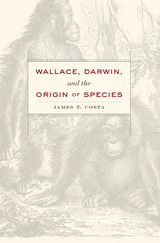 Wallace, Darwin, and the Origin of Species
James T. Costa
Harvard University Press, 2014 Charles Darwin is often credited with discovering evolution through natural selection, but the idea was not his alone. The naturalist Alfred Russel Wallace, working independently, saw the same process at work in the natural world and elaborated much the same theory. Their important scientific contributions made both men famous in their lifetimes, but Wallace slipped into obscurity after his death, while Darwin’s renown grew. Dispelling the misperceptions that continue to paint Wallace as a secondary figure, James Costa reveals the two naturalists as true equals in advancing one of the greatest scientific discoveries of all time.
Analyzing Wallace’s “Species Notebook,” Costa shows how Wallace’s methods and thought processes paralleled Darwin’s, yet inspired insights uniquely his own. Kept during his Southeast Asian expeditions of the 1850s, the notebook is a window into Wallace’s early evolutionary ideas. It records his evidence-gathering, critiques of anti-evolutionary arguments, and plans for a book on “transmutation.” Most important, it demonstrates conclusively that natural selection was not some idea Wallace stumbled upon, as is sometimes assumed, but was the culmination of a decade-long quest to solve the mystery of the origin of species.
Wallace, Darwin, and the Origin of Species also reexamines the pivotal episode in 1858 when Wallace sent Darwin a manuscript announcing his discovery of natural selection, prompting a joint public reading of the two men’s papers on the subject. Costa’s analysis of the “Species Notebook” shines a new light on these readings, further illuminating the independent nature of Wallace’s discoveries.
 Wallace Stegner and the Continental Vision: Essays on Literature, History, and Landscape
Edited by Curt Meine; Foreword by Paul W. Johnson
Island Press, 1997 Wallace Stegner (1909-1993) was, in the words of historian T. H. Watkins, "a walking tower of American letters." Winner of the Pulitzer prize and the National Book Award for fiction, founder of the Stanford Writing Program, recipient of three Guggenheim fellowships and innumerable honorary degrees, Stegner was both a brilliant writer and an exceptional teacher.Wallace Stegner and the Continental Vision brings together leading literary critics, historians, legal scholars, geographers, scientists, and others to present a multifaceted exploration of Stegner's work and its impact, and a thought-provoking examination of his life. Contributors consider Stegner as writer, as historian, and as conservationist, discussing his place in the American literary tradition, his integral role in shaping how Americans relate to the land, and his impact on their own personal lives and careers. They present an eclectic mix of viewpoints as they explore aspects of Stegner's work that they find most intriguing, inspiring, and provocative: Jackson J. Benson on the personal qualities that so distinctively shaped Stegner's writings Walter Nugent on the historical context of Stegner's definition of the West T. H. Watkins on Stegner's contributions to the modern conservation movement Terry Tempest Williams on Stegner's continuing importance as an "elder" in the community of writers he nurtured Other contributors include Dorothy Bradley, John Daniel, Daniel Flores, Melody Graulich, James R. Hepworth, Richard L. Knight, Curt Meine, Thomas R. Vale, Elliott West, and Charles F. Wilkinson.Wallace Stegner and the Continental Vision is an illuminating look at Stegner's many and varied contributions to American literature and society. Longtime admirers of Stegner will appreciate it for the new perspectives it provides, while readers less familiar with him will find it a valuable and accessible introduction to his life and work.
 Wallace Stegner: Dean of Western Writers
Beam, Alex
Signature Books, 2025 In this brisk and riveting biography, Alex Beam takes readers on a journey through Wallace Stegner’s life and complicated legacy as one of the twentieth century’s best storytellers and chroniclers of the American West. In a career that spanned half a century, Stegner wrote fourteen novels and seventeen works of nonfiction. Reared on the Canadian-American frontier and educated in Salt Lake City, Utah, this quintessential Man of the West won both the Pulitzer Prize and the National Book Award. He landed a coveted teaching job at Harvard but, eager to get back to the West, left it for a professorship at Stanford. Stegner was a full-throated environmentalist who served on the board of the Sierra Club, worked for the Secretary of the Interior, and wrote the famous Wilderness Letter on the healing power of open spaces. He founded Stanford University’s legendary Stegner Writing Fellowship, where his students included Edward Abbey, Wendell Berry, Ken Kesey, Larry McMurtry, Sandra Day O'Connor, Tillie Olsen, and Scott Turow. In his later years Stegner wondered if he had lived too deep into the wrong century. He left Stanford when he felt students no longer accorded professors the respect they deserved, and later became embroiled in a plagiarism scandal that tarred his Pulitzer Prize-winning Angle of Repose. Stegner ended his career with his valedictory masterpiece, Crossing to Safety. It was his rare Eastern novel, set in his adopted home of Greensboro, Vermont, where he chose to be buried.
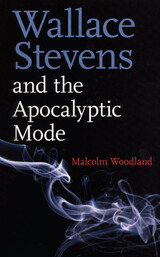 Wallace Stevens And The Apocalyptic Mode
Woodland, Malcolm
University of Iowa Press, 2005 Wallace Stevens and the Apocalyptic Mode focuses on Stevens’s doubled stance toward the apocalyptic past: his simultaneous use of and resistance to apocalyptic language, two contradictory forces that have generated two dominant and incompatible interpretations of his work. The book explores the often paradoxical roles of apocalyptic and antiapocalyptic rhetoric in modernist and postmodernist poetry and theory, particularly as these emerge in the poetry of Stevens and Jorie Graham.
This study begins with an examination of the textual and generic issues surrounding apocalypse, culminating in the idea of apocalyptic language as a form of “discursive mastery” over the mayhem of events. Woodland provides an informative religious/historical discussion of apocalypse and, engaging with such critics as Parker, Derrida, and Fowler, sets forth the paradoxes and complexities that eventually challenge any clear dualities between apocalyptic and antiapocalyptic thinking.
Woodland then examines some of Stevens’s wartime essays and poems and describes Stevens’s efforts to salvage a sense of self and poetic vitality in a time of war, as well as his resistance to the possibility of cultural collapse. Woodland discusses the major postwar poems “Credences of Summer” and “The Auroras of Autumn” in separate chapters, examining the interaction of (anti)apocalyptic modes with, respectively, pastoral and elegy.
The final chapter offers a perspective on Stevens’s place in literary history by examining the work of a contemporary poet, Jorie Graham, whose poetry quotes from Stevens’s oeuvre and shows other marks of his influence. Woodland focuses on Graham's 1997 collection The Errancy and shows that her antiapocalyptic poetry involves a very different attitude toward the possibility of a radical break with a particular cultural or aesthetic stance.
Wallace Stevens and the Apocalyptic Mode, offering a new understanding of Stevens’s position in literary history, will greatly interest literary scholars and students.
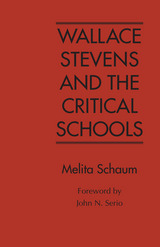 Wallace Stevens and the Critical Schools
Melita C. Schaum
University of Alabama Press, 1988 An overview of seventy years of Stevens criticism
Wallace Stevens and the Critical Schools reveals a field marked by conflict and contradiction, both within and among critical works in their attempts to explicate and appropriate this major American poet. Stevens’ changing reception among the critical schools reveals much about the shifting nature of American literature and criticism in this century and illuminates the often polemical process of literary canon formation. Each chapter of this book examines a particular aspect of the 20th-century critical involvement with Wallace Stevens’ poetry, introduced by a discussion of the poet’s work as an arena for the convergence of modern critical tendencies and concerns.
First, the author examines the avant-garde milieu of early 20th-century modernism, which implicated Stevens in its melee of affiliations and enmities and which influenced critics’ ambivalent responses to his early work. She traces the critical controversies of the poet’s emergence before and during the 1920s, specifically the clash between New Humanism and aestheticism, and demonstrates how the quality of irony in Stevens’ work became a part of the critics’ general repertoire in their assessment of this poet.
The 1930s, 1940s, and 1950s were decades during which Stevens criticism became dominated by the New Critical ideology. The turn toward deconstruction in Stevens criticism stands in part as a response to the New Critical dilemma, seen in the manner in which such critics as J. Hillis Miller and Joseph Riddel appropriated the concept of “decreation” to explain the sense of rupture in Stevens’ late poetry yet brought that concept to its logical end in a deconstructive paradigm.
Finally, Schaum identifies four major theoretical approaches to Stevens in the past two decades that continue to inform and direct the field of critical dissent and exploration in the 1980s. Such theories as Bloomian misprision, versions of hermeneutic criticism, redefinitions of the deconstructive enterprise, and the contemporary call for a new historicism continue the battle to appropriate Stevens as the “hard prize” of critical aims and investigations.
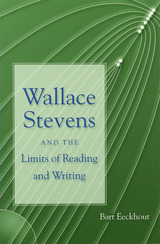 Wallace Stevens and the Limits of Reading and Writing
Bart Eeckhout
University of Missouri Press, 2002
Often considered America’s greatest twentieth-century poet, Wallace Stevens is without a doubt the Anglo-modernist poet whose work has been most scrutinized from a philosophical perspective. Wallace Stevens and the Limits of Reading and Writing both synthesizes and extends the critical understanding of Stevens’s poetry in this respect. Arguing that a concern with the establishment and transgression of limits goes to the heart of this poet’s work, Bart Eeckhout traces both the limits of Stevens’s poetry and the limits of writing as they are explored by that poetry.
Stevens’s work has been interpreted so variously and contradictorily that critics must first address the question of limits to the poetry’s signifying potential before they can attempt to deepen our appreciation of it. In the first half of this book, the limits of appropriating and contextualizing Stevens’s “The Snow Man,” in particular, are investigated. Eeckhout does not undertake this reading with the negative purpose of disputing earlier interpretations but with the more positive intention of identifying the intrinsic qualities of the poetry that have been responsible for the remarkable amount of critical attention it has received.
Having identified the major sources of Stevens’s polysemy and of the seeming free-for-all of his critical afterlife, Eeckhout then deals with ten of the poet’s shorter works, including “The Idea of Order at Key West,” and proceeds to analyze some of the important limits of writing explored by the poetry. These limits all revolve around the nexus of perception, thought, and language that constitutes the core dynamic out of which Stevens’s poetry is generated and to which it continually returns.
Stevens’s work presents one of the most poignant opportunities for letting the reader feel the ever-problematic relationship between specificity and generality that is at the heart of all literary writing. By negotiating between the particularity of poetic detail and the universality of philosophical ideas, Wallace Stevens and the Limits of Reading and Writing seeks to contribute both to the study of Stevens and to the fields of literary theory and philosophy.
 The Wallace Stevens Case: Law and the Practice of Poetry
Thomas Grey
Harvard University Press, 1991 Wallace Stevens was not only one of America's outstanding modernist poets but also a successful insurance lawyer--a fact that continues to intrigue many readers. Though Stevens tried hard to separate his poetry from his profession, legal theorist Thomas Grey shows that he did not ultimately succeed. After stressing how little connection appears on the surface between the two parts of Stevens's life, Grey argues that in its pragmatic account of human reasoning, the poetry distinctively illuminates the workings of the law.
In this important extension of the recent law-and-literature movement, Grey reveals Stevens as a philosophical poet and implicitly a pragmatist legal theorist, who illustrates how human thought proceeds through "assertion, qualification, and qualified reassertion," and how reason and passion fuse together in the act of interpretation. Above all, Stevens's poetry proves a liberating antidote to the binary logic that is characteristic of legal theory: one side of a case is right, the other wrong; conduct is either lawful or unlawful.
At the same time as he discovers in Stevens a pragmatist philosopher of law, Grey offers a strikingly new perspective on the poetry itself. In the poems that develop Stevens's "reality-imagination complex"--poems often criticized as remote, apolitical, and hermetic--Grey finds a body of work that not only captivates the reader but also provides a unique instrument for scrutinizing the thought processes of lawyers and judges in their exercise of social power.
 Wallace Stevens: Words Chosen Out of Desire
Helen Vendler
Harvard University Press, 1986 “More than any other single critic, Vendler has shown people how to read Stevens not as a philosopher...but as a passionate and often disappointed human being.”
—Stephanie Burt, Wallace Stevens Journal
A giant of modern poetry finds his greatest reader and fiercest advocate in the peerless Helen Vendler.
Wallace Stevens is often considered a cerebral, abstract poet. Alternating between ornamental flourish and philosophical contemplation, his work can seem impenetrable to casual readers. When a bewildered acquaintance once asked him to explain a poem, Stevens elliptically replied, “I don’t think you’d understand this unless you wrote it.”
And yet, as Helen Vendler shows, there is so much more to Stevens than dexterous wordplay or oblique cogitations on the relationship between reality and imagination. In a meticulous reading of his shorter poems—“The Idea of Order at Key West,” “The Snow Man,” and “The Emperor of Ice-Cream,” among others—Vendler excavates the depth of human feeling beneath his rarefied surfaces. Vendler’s Stevens is, above all, a poet of desire and its disillusions. His choices of words, fastidious as they are, mark his attempt to find a form adequate to his over-acute experience of ordinary life events: the failure of a marriage, the death of a neighbor, or a simple walk through his Connecticut neighborhood. Beyond sensual desire, his most profound yearning is to capture in poetry what his nerves cannot help but register, to encapsulate a world that has “stopped revolving except in crystal.”
Compiled from Vendler’s 1982 lectures at the University of Tennessee, Knoxville, Words Chosen Out of Desire showcases a leading critic at the peak of her powers, one whose masterful reconstructions played no small part in cementing Stevens’s place in the canon of literary modernism.
 Wallace Stevens: Words Chosen Out of Desire
Helen Vendler
Harvard University Press “More than any other single critic, Vendler has shown people how to read Stevens not as a philosopher...but as a passionate and often disappointed human being.”
—Stephanie Burt, Wallace Stevens Journal
A giant of modern poetry finds his greatest reader and fiercest advocate in the peerless Helen Vendler.
Wallace Stevens is often considered a cerebral, abstract poet. Alternating between ornamental flourish and philosophical contemplation, his work can seem impenetrable to casual readers. When a bewildered acquaintance once asked him to explain a poem, Stevens elliptically replied, “I don’t think you’d understand this unless you wrote it.”
And yet, as Helen Vendler shows, there is so much more to Stevens than dexterous wordplay or oblique cogitations on the relationship between reality and imagination. In a meticulous reading of his shorter poems—“The Idea of Order at Key West,” “The Snow Man,” and “The Emperor of Ice-Cream,” among others—Vendler excavates the depth of human feeling beneath his rarefied surfaces. Vendler’s Stevens is, above all, a poet of desire and its disillusions. His choices of words, fastidious as they are, mark his attempt to find a form adequate to his over-acute experience of ordinary life events: the failure of a marriage, the death of a neighbor, or a simple walk through his Connecticut neighborhood. Beyond sensual desire, his most profound yearning is to capture in poetry what his nerves cannot help but register, to encapsulate a world that has “stopped revolving except in crystal.”
Compiled from Vendler’s 1982 lectures at the University of Tennessee, Knoxville, Words Chosen Out of Desire showcases a leading critic at the peak of her powers, one whose masterful reconstructions played no small part in cementing Stevens’s place in the canon of literary modernism.
 Wallbangin': Graffiti and Gangs in L.A.
Susan A. Phillips
University of Chicago Press, 1999 Graffiti is as ubiquitous as telephone poles in America's cities; it is as old as the earliest civilizations. The most public medium in the country today, graffiti can signal territory, love, or liberation. Ironically, graffiti is understood by only a fraction of those who encounter it. Usually read as a sign of urban decay and as a loss of control over the physical environment, graffiti has become one of the most potent cultural languages of our age. Wallbangin' is an unprecedented, in-depth look at this phenomenon as it is embodied in the neighborhoods of one of its epicenters, Los Angeles.
Anthropologist Susan Phillips enters the lives of the African-American and Chicano gang members to write a comprehensive guide to their symbolic and visual expression. She not only decodes the graffiti—explaining how, for instance, gang boundaries are visually delimited and how "memorial" graffiti functions—but she also places it in the context of the changing urban landscapes within the city. Graffiti, she argues, is inextricably linked to political change, to race, and to art, and she demonstrates how those connections are played out in contemporary L.A. Wallbangin' is, on this level, an iconography of street imagery. But it is also a very personal narrative about entering the world of L.A. street gangs—a world of pride, enemies, affirmation, and humanity where gang members use graffiti to redefine their social and political position in society.
To many outsiders, graffiti is cryptic, senseless scribbling. But Phillips explains it as an ingenious and creative solution to the disenfranchisement felt by those who produce it. With personal narratives, provocative photography, and contemporary voices, Wallbangin' unlocks the mysteries behind street-level ideologies and their visual manifestations.
 Walled: Barriers, Migration, and Resistance in the U.S.-Mexico Borderlands
Edited by Andréanne Bissonnette and Élisabeth Vallet
University of Arizona Press, 2025 In 1993, then-U.S. President Bill Clinton oversaw the construction of the first stretch of the U.S.-Mexico border walls. Since that pivotal moment, every subsequent U.S. president has allowed for the construction of additional miles of walls or fences. Despite his initial pledge to halt the expansion of border walls, in July 2022, President Joe Biden authorized the construction of new sections in four locations within Arizona. This decision underscores the enduring complexity and contentious nature of the U.S.-Mexico border infrastructure.
From the bustling San Diego–Tijuana region to the borderlands of Brownsville-Matamoros, the U.S.-Mexico border is marked by extensive stretches of walls. Over the past thirty years, these walls have evolved from purely physical barriers into multifaceted systems encompassing administrative, legal, legislative, and biometric components. This volume invites readers to reflect on the transformations of the border since the construction of the initial fourteen miles of wall, and the subsequent addition of 1,940 miles. It provides a comprehensive exploration of the border’s evolution, and its profound and lasting impacts.
Bringing together recognized scholars in border studies, Walled delves into the varied manifestations and lived experiences associated with U.S.-Mexico border walls. The introduction by Andréanne Bissonnette and Élisabeth Vallet offers a thorough review of the border walls’ thirty-year history, placing it within a global context. Contributions offer diverse perspectives of the border experience, from state policies and migrant experiences to the daily lives of border residents. Topics such as militarization, migration, artistic resistance, and humanitarian aid are carefully examined. This volume is an essential resource for policymakers, activists, scholars, and anyone seeking to understand the intricate realities of border communities and the far-reaching consequences of border policies.
Contributors
Susana Báez-Ayala
Andréanne Bissonnette
Mathilde Bourgeon
Silvia M. Chávez-Baray
Irasema Coronado
Thalia D’Aragon-Giguère
Erin Hoekstra
Anthony Jimenez
T. Mark Montoya
Eva M. Moya
Scott Nicol
Héctor Antonio Padilla Delgado
Lisa Sun-Hee Park
Tony Payan
Patricia Ravelo-Blancas
David A. Shirk
Allyson Teague
Élisabeth Vallet
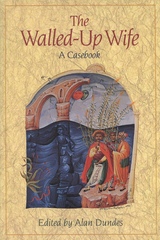 Walled-Up Wife: A Casebook
Alan Dundes
University of Wisconsin Press, 1996 For centuries, many Indo-European peoples have sung a poignant ballad about the tragic sacrifice of a female victim to ensure the successful completion of an important undertaking, such as the construction of a building, bridge, or well. The legend, and its many regional and stylistic variations throughout Eastern Europe and India, provides material for an original and engaging casebook of interpretations by folklorists, anthropologists, scholars of comparative religion, and literary critics.
Alan Dundes brings together eighteen essays on this classic ballad, each introduced by his headnotes. Some contributors offer competing nationalistic claims concerning the ballad’s origin, claims now in dispute because of previously overlooked South Asian versions; Ruth Mandel examines gender and power issues in the ballad; Lyubomira Parpulova-Gribble presents a structuralist reading; Krstivoj Kotur proposes a Christian interpretation; Mircea Eliade advocates a myth-ritual reading of blood sacrifices with cosmogonic connections in the Romanian text; and other readings explore female victimization and heroism by seeing the ballad’s theme as a metaphor for marriage, a male-constructed trap seriously restricting women’s freedom and mobility. Dundes concludes the collection with his own feminist and psychoanalytic interpretations of the ballad, followed by suggestions for further reading.
By emphasizing the ballad’s variant forms in diverse cultural contexts, analyzed from different disciplinary perspectives, this volume asks students of folklore to be aware of the multiplicity of approaches available to them in researching folk narrative.
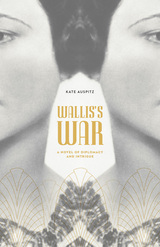 Wallis's War: A Novel of Diplomacy and Intrigue
Kate Auspitz
University of Chicago Press, 2015 Scandalous divorcée. Nazi sympathizer. Style icon. Her Grace the Duchess of Windsor. Such are the many—and many times questionable—monikers of the infamous Wallis Simpson. And with Wallis’s War, Kate Auspitz adds another to this list: unwitting heroine.
The facts: reviled by the British as a social-climbing seductress even as Time magazine named her its 1936 Woman of the Year, Simpson was the American socialite whose affair with King Edward VIII led him to abdicate the throne on the eve of WWII. In this fanciful novel written in the form of a fictional memoir, Auspitz imagines an alternative history in which Simpson was encouraged by Allied statesmen to remove defeatist, pro-German Edward from the throne, forever altering the course of the war. A comically unreliable narrator who knows more than she realizes, and reveals more than she knows, Simpson leads us from historic treaties and military campaigns to dinner parties and cruises as she describes encounters with everyone from Duff and Diana Cooper to Charles Lindbergh, Coco Chanel, and Hitler—all the while acting as a willing but seemingly oblivious pawn of international intrigue.
A rare blend of diplomacy and dalliance, fashion and fascists, this meticulously researched satire offers witty and erudite entertainment and leaves us speculating: who really brought about the abdication and—always—what were they wearing?
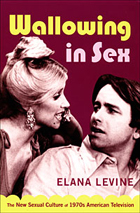 Wallowing in Sex: The New Sexual Culture of 1970s American Television
Elana Levine
Duke University Press, 2007 Passengers disco dancing in The Love Boat’s Acapulco Lounge. A young girl walking by a marquee advertising Deep Throat in the made-for-TV movie Dawn: Portrait of a Teenage Runaway. A frustrated housewife borrowing Orgasm and You from her local library in Mary Hartman, Mary Hartman. Commercial television of the 1970s was awash with references to sex. In the wake of the sexual revolution and the women’s liberation and gay rights movements, significant changes were rippling through American culture. In representing—or not representing—those changes, broadcast television provided a crucial forum through which Americans alternately accepted and contested momentous shifts in sexual mores, identities, and practices. Wallowing in Sex is a lively analysis of the key role of commercial television in the new sexual culture of the 1970s. Elana Levine explores sex-themed made-for-TV movies; female sex symbols such as the stars of Charlie’s Angels and Wonder Woman; the innuendo-driven humor of variety shows (The Sonny and Cher Comedy Hour, Laugh-In), sitcoms (M*A*S*H, Three’s Company), and game shows (Match Game); and the proliferation of rape plots in daytime soap operas. She also uncovers those sexual topics that were barred from the airwaves. Along with program content, Levine examines the economic motivations of the television industry, the television production process, regulation by the government and the tv industry, and audience responses. She demonstrates that the new sexual culture of 1970s television was a product of negotiation between producers, executives, advertisers, censors, audiences, performers, activists, and many others. Ultimately, 1970s television legitimized some of the sexual revolution’s most significant gains while minimizing its more radical impulses.
 The Wallpaper Fox: A Novel
Morris Philipson
University of Chicago Press, 2000 Written with razor-sharp wit and keen psychological insight, this compelling novel explores the way people—husbands, wives, parents, children, lovers—use and abuse each other. Under the meticulously maintained social conventions of the wealthy Warner family lie more primitive impulses and desires. As each character faces a crisis, we start to see the fascinating ways in which they make moral choices.
"Philipson gives us a very believable portrait of a marriage. He also gives us no easy answers . . . and best of all, real storytelling." —Publishers Weekly
"This solid and serious novel emerges as not just an expose of what really goes on behind the well-groomed facades of the affluent, but a thoughtful exploration of character and the efficacy of moral action in forming and reforming it." —Jane Larkin Crain, New York Times Book Review
"A swift, no-fudging narrative by a writer it is always rewarding to rediscover." —Sophie Wilkins, National Review
"An extraordinary novel, fascinating, compelling, and totally disconcerting." —Fort Worth Star-Telegram
"Has the drama, intelligence and moral force of an American Howards End."-Cynthia Ozick
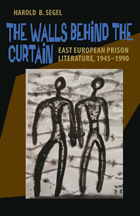 The Walls Behind the Curtain: East European Prison Literature, 1945–1990
Harold B. Segel
University of Pittsburgh Press, 2012 Because of their visibility in society and ability to shape public opinion, prominent literary figures were among the first targets of Communist repression, torture, and incarceration. Authors such as Alexsandr Solzhenitsyn famously documented the experience of internment in Soviet gulags. Little, however, has been published in the English language on the work of writers imprisoned by other countries of the Soviet bloc.
For the first time, The Walls Behind the Curtain presents a collection of works from East European novelists, poets, playwrights, and essayists who wrote during or after their captivity under communism. Harold B. Segel paints a backdrop of the political culture and prison and labor camp systems of each country, detailing the onerous conditions that writers faced. Segel then offers biographical information on each writer and presents excerpts of their writing. Notable literary figures included are Václav Havel, Eva Kanturková, Milan Šimecka, Adam Michnik, Milovan Djilas, Paul Goma, Tibor Déry, and Visar Zhiti, as well as many other writers.
This anthology recovers many of the most important yet overlooked literary voices from the era of Communist occupation. Although translated from numerous languages, and across varied cultures, there is a distinct commonality in the experiences documented by these works. The Walls Behind the Curtain serves as a testament to the perseverance of the human spirit and a quest for individual liberty that many writers forfeited their lives for.
 Walls: Enclosure and Ethics in the Modern Landscape
Thomas Oles
University of Chicago Press, 2014 Stone walls, concrete walls, chain-link walls, border walls: we live in a world of walls. Walls mark sacred space and embody earthly power. They maintain peace and cause war. They enforce separation and create unity. They express identity and build community. Yard to nation, city to self, walls define and dissect our lives. And, for Thomas Oles, it is time to broaden our ideas of what they can—and must—do.
In Walls, Oles shows how our minds and our politics are shaped by–and shape–our divisions in the landscape. He traces the rich array of practices and meanings connected to the making and marking of boundaries across history and prehistory, and he describes how these practices have declined in recent centuries. The consequence, he argues, is all around us in the contemporary landscape, riven by walls shoddy in material and mean in spirit. Yet even today, Oles demonstrates, every wall remains potentially an opening, a stage, that critical place in the landscape where people present themselves and define their obligations to one another. In an evocative epilogue, Oles brings to life a society of productive, intentional, and ethical enclosure—one that will leave readers more hopeful about the divided landscapes of the future.
 Walls: Essays, 1985-1990
Kenneth A. McClane
University of Notre Dame Press, 2010
Walls: Essays, 1985-1990, Kenneth McClane's first book of autobiographical essays (originally published in 1991), is closely related to his second collection, Color, published by the University of Notre Dame Press in 2009. Wallsis a powerful and deeply moving meditation on relationships. It begins with an essay on the death of McClane's brother, Paul, which "changed everything. Time, my work, everything found a new calculus."
His brother's life and death are present in some way in all the essays that follow "A Death in the Family," as McClane tells us about giving a poetry reading in a maximum-security prison; his experience of being one of the first two African American students to attend America's oldest private school; teaching creative writing; his sister, Adrienne; a divestment protest at Cornell; and his encounters with James Baldwin. McClane has written a new preface to this paperback edition of Walls.
"Wallsreminds us of the differences that set us apart, dividing our world into good kids and troublemakers, winners and losers, the beautiful and the damned. The anodyne for exile in these essays is McClane's common but by no means commonplace lexicon, at once evocative and spare, that leads us to painful but honest connection and the luminous possibility of empathy." --William L. Andrews, University of North Carolina at Chapel Hill
"Kenneth McClane's Walls is a collection of exquisitely crafted autobiographical essays that rivals the most profound nonfictional writings of James Baldwin in its skillful investigation of the hidden recesses of the always-throbbing black American soul. Indeed,Wallsis a beautifully calibrated exploration of the challenges faced by a courageously self-aware--and refreshingly self-revealing--black intellectual whose journey to and in the American mainstream is both menacing and exhilarating." --Michael Awkward, University of Michigan
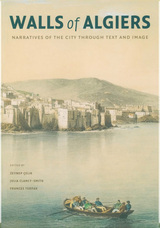 Walls of Algiers: Narratives of the city through text and image
Zeynep Çelik
J. Paul Getty Trust, The, 2023 Walls of Algiers examines the historical processes that transformed Ottoman Algiers, the "Bulwark of Islam," into "Alger la blanche," the colonial urban showpiece—and, after the outbreak of revolution in 1954—counter-model of France's global empire. In this volume, the city of Algiers serves as a case study for the analysis of the proactive and reactive social, political, technical, and artistic forces that generate a city's form. Visual sources—prints, photographs, paintings, architectural drawings, urban designs, and film—are treated as primary evidence that complements and even challenges textual documents.
The contributors' wide-ranging but intersecting essays span the disciplines of art history, social and cultural history, urban studies, and film history. Walls of Algiers presents a multifaceted look at the social use of urban space in a North African city. Its contributors' innovative methodologies allow important insights into often overlooked aspects of life in a city whose name even today conjures up enchantment as well as incomprehensible violence.
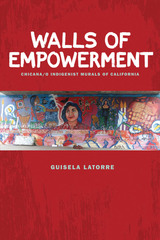 Walls of Empowerment: Chicana/o Indigenist Murals of California
By Guisela Latorre
University of Texas Press, 2008 Exploring three major hubs of muralist activity in California, where indigenist imagery is prevalent, Walls of Empowerment celebrates an aesthetic that seeks to firmly establish Chicana/o sociopolitical identity in U.S. territory. Providing readers with a history and genealogy of key muralists' productions, Guisela Latorre also showcases new material and original research on works and artists never before examined in print. An art form often associated with male creative endeavors, muralism in fact reflects significant contributions by Chicana artists. Encompassing these and other aspects of contemporary dialogues, including the often tense relationship between graffiti and muralism, Walls of Empowerment is a comprehensive study that, unlike many previous endeavors, does not privilege non-public Latina/o art. In addition, Latorre introduces readers to the role of new media, including performance, sculpture, and digital technology, in shaping the muralist's "canvas." Drawing on nearly a decade of fieldwork, this timely endeavor highlights the ways in which California's Mexican American communities have used images of indigenous peoples to raise awareness of the region's original citizens. Latorre also casts murals as a radical force for decolonization and liberation, and she provides a stirring description of the decades, particularly the late 1960s through 1980s, that saw California's rise as the epicenter of mural production. Blending the perspectives of art history and sociology with firsthand accounts drawn from artists' interviews, Walls of Empowerment represents a crucial turning point in the study of these iconographic artifacts.
The Walls of Jericho
Rudolph Fisher
University of Michigan Press, 1994 The first novel by one of the legends of the Harlem Renaissance
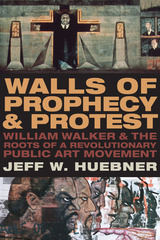 Walls of Prophecy and Protest: William Walker and the Roots of a Revolutionary Public Art Movement
Jeff W. Huebner
Northwestern University Press, 2019 Chicago is home to more intact African American street murals from the 1970s and ’80s than any other U.S. city. Among Chicago’s greatest muralists is the legendary William “Bill” Walker (1927–2011), compared by art historians to Diego Rivera and called the most accomplished contemporary practitioner of the classical mural tradition.
Though his art could not have been more public, Walker maintained a low profile during his working life and virtually withdrew from the public eye after his retirement in 1989. Author Jeff W. Huebner met Walker in 1990 and embarked on a series of insightful interviews that stretched over the next two decades. Those meetings and years of research form the basis of Walls of Prophecy and Protest, the story of Walker’s remarkable life and the movement that he inspired.
Featuring forty-three color images of Walker’s work, most long since destroyed or painted over, this handsome edition reveals the artist who was the primary figure behind Chicago’s famed Wall of Respect and who created numerous murals that depicted African American historical figures, protested social injustice, and promoted love, respect, racial unity, and community change.
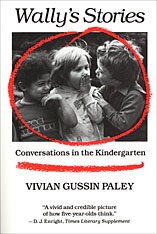 Wally’s Stories
Vivian Gussin Paley
Harvard University Press, 1981 Teachers are often taught that young children are incapable of logical thought. Prone to fantasy and unruffled by inconsistency, preschool children are frequently baffled by the first lessons of early schooling. Trained to gently resist the child’s illogic, teachers sometimes create just the incomprehension and anxiety they mean to avoid. In Wally’s Stories, Vivian Paley shows that none of this need be so.
Wally’s Stories is itself a story: the story of the evolution of a kindergarten classroom in which Paley learned to stop fighting childish fantasy and instead make use of it to stimulate the very best brand of thinking her five-year-olds can muster. Stories also lie at the heart of her classroom: stories that are first told by one of the children, then transcribed by the teacher, and then acted out by the class in dramatic productions of their own design. Paley shows that in the course of creating their own dramatic world, five-year-olds are capable of thought and language far in advance of what they accomplish in traditional classroom exercises. The children’s stories also become a vehicle that they can use to explain themselves to their teacher and to one another. Together, teacher and children develop an unusual environment, one that is logical and literate, based on rules of fairness, friendship, and fantasy.
Vivian Paley’s book is as refreshing as her teaching method—a new kind of book about a new kind of classroom.
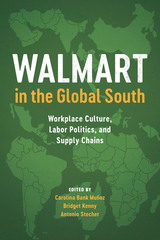 Walmart in the Global South: Workplace Culture, Labor Politics, and Supply Chains
Edited by Carolina Bank Muñoz, Bridget Kenny,and Antonio Stecher
University of Texas Press, 2018 As the largest private employer in the world, Walmart dominates media and academic debate about the global expansion of transnational retail corporations and the working conditions in retail operations and across the supply chain. Yet far from being a monolithic force conquering the world, Walmart must confront and adapt to diverse policies and practices pertaining to regulation, economy, history, union organization, preexisting labor cultures, and civil society in every country into which it enters. This transnational aspect of the Walmart story, including the diversity and flexibility of its strategies and practices outside the United States, is mostly unreported. Walmart in the Global South presents empirical case studies of Walmart’s labor practices and supply chain operations in a number of countries, including Chile, Brazil, Argentina, Nicaragua, Mexico, South Africa, and Thailand. It assesses the similarities and differences in Walmart’s acceptance into varying national contexts, which reveals when and how state regulation and politics have served to redirect company practice and to what effect. Regulatory context, state politics, trade unions, local cultures, and global labor solidarity emerge as vectors with very different force around the world. The volume’s contributors show how and why foreign workers have successfully, though not uniformly, driven changes in Walmart’s corporate culture. This makes Walmart in the Global South a practical guide for organizations that promote social justice and engage in worker struggles, including unions, worker centers, and other nonprofit entities.
The Walnut Trees of Altenburg
André Malraux
University of Chicago Press, 1992 "One of the key texts of Malraux's work . . . [its] pages must be counted among the most haunting in all of twentieth century literature."—Victor Brombert
"The description of the gas attack on the Russian front in 1915 will never be forgotten by anyone who has read it. . . . [Malraux] writes with the precision, the certitude and the authority of an obsessed person who knows that he has found the essence of what he has been looking for."—Conor Cruise O'Brien, from the Foreword
Malraux's greatest novel, Man's Fate, gave a grim, lurid picture of human suffering. [The Walnut Trees of Altenburg], written by a life-long observer of violent upheaval and within the shadows of World War II, gives a calm, thoughtful vision of humanistic endeavor that can transcend the absurdity of existence. Mature readers will find this a rewarding visit to one of the most accomplished writers of our time."—Choice
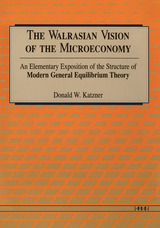 Walrasian Vision of the Microeconomy: An Elementary Exposition of the Structure of Modern General Equilibrium Theory
Donald W. Katzner
University of Michigan Press, 1990 The Walrasian Vision of the Microeconomy articulates the traditional vision that is conjured up in the minds of most contemporary economists as they contemplate the microeconomy. It does so by setting out a very simple general-equilibrium model containing 1 produced consumer good, 1 produced capital good, 2 factors, 2 consumers, and 2 firms. Most of the basic theoretical ingredients of perfect competition taught in microeconomic theory courses are geometrically developed in this context: market equilibrium, the derivation of consumer demand for goods and supply of factors from constrained utility maximization, the relation between cost and production functions, the derivation of firm output supply and input demand from profit maximization, and the connections between competitive equilibrium, Pareto optimality, and welfare maximization. Also included is an elementary geometric proof of the existence and uniqueness of competitive equilibrium. The underlying premise is that these elements are all components of a larger picture and, as a result, fit together into a unified whole. The book is ideally suited to accompany the fuller and more detailed expositions of standard microeconomic theory texts.
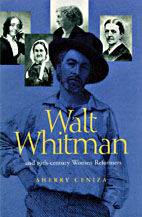 Walt Whitman and Nineteenth-Century Women Reformers
Sherry Ceniza
University of Alabama Press, 1999 Ceniza provides a dramatic rereading of Walt Whitman's poetry through the lens of 19th-century feminist culture.
Walt Whitman and 19th-Century Women Reformers documents Whitman's friendships with women during the 1850s, the decade of Whitman's most creative period. The book reveals startling connections between the first three editions of Leaves of Grass and the texts generated by the women he knew during this period, many of whom were radical activists in the women's rights movement.
Sherry Ceniza argues that Whitman's editions of Leaves became progressively more radically 'feminist' as he followed the women's rights movement during the 1850s and that he was influenced by what he called the 'true woman of the new aggressive type . . . woman under the new dispensation.' Ceniza documents the progression of the National Woman's Rights movement through the lives and writings of three of its leaders- Abby Hills Price, Paulina Wright Davis, and Ernestine L. Rose. By juxtaposing the texts written by these women with Leaves, Ceniza shows that Whitman used many of the same arguments and rhetorical gestures as his female activist friends.
The book also discusses the influence of women engaged in women's rights outside the National Woman's Rights organization. And Ceniza's opening chapter is devoted to a fresh interpretation of the life and thought of another strong-minded woman who influenced the poet's writing-Louisa Van Velsor Whitman, Walt Whitman's mother.
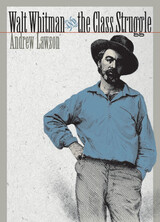 Walt Whitman and the Class Struggle
Andrew Lawson
University of Iowa Press, 2006 By reconsidering Whitman not as the proletarian voice of American diversity but as a historically specific poet with roots in the antebellum lower middle class, Andrew Lawson in Walt Whitman and the Class Struggle defines the tensions and ambiguities about culture, class, and politics that underlie his poetry.Drawing on a wealth of primary sources from across the range of antebellum print culture, Lawson uses close readings of Leaves of Grass to reveal Whitman as an artisan and an autodidact ambivalently balanced between his sense of the injustice of class privilege and his desire for distinction. Consciously drawing upon the languages of both the elite culture above him and the vernacular culture below him, Whitman constructed a kind of middle linguistic register that attempted to filter these conflicting strata and defuse their tensions: “You shall not look through my eyes either, nor take things from me, / You shall listen to all sides and filter them from yourself.” By exploring Whitman's internal struggle with the contradictions and tensions of his class identity, Lawson locates the source of his poetic innovation. By revealing a class-conscious and conflicted Whitman, he realigns our understanding of the poet's political identity and distinctive use of language and thus valuably alters our perspective on his poetry.
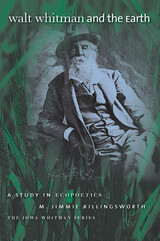 Walt Whitman and the Earth: A Study of Ecopoetics
M. Jimmie Killingsworth
University of Iowa Press, 2005 Now I am terrified at the Earth, it is that calm and patient,
It grows such sweet things out of such corruptions,
It turns harmless and stainless on its axis, with such endless successions of diseas’d corpses,
It distills such exquisite winds out of such infused fetor,
It renews with such unwitting looks its prodigal, annual, sumptuous crops,
It gives such divine materials to men, and accepts such leavings from them at last.
—Walt Whitman, from “This Compost” How did Whitman use language to figure out his relationship to the earth, and how can we interpret his language to reconstruct the interplay between the poet and his sociopolitical and environmental world? In this first book-length study of Whitman’s poetry from an ecocritical perspective, Jimmie Killingsworth takes ecocriticism one step further into ecopoetics to reconsider both Whitman’s language in light of an ecological understanding of the world and the world through a close study of Whitman’s language. Killingsworth contends that Whitman’s poetry embodies the kinds of conflicted experience and language that continually crop up in the discourse of political ecology and that an ecopoetic perspective can explicate Whitman’s feelings about his aging body, his war-torn nation, and the increasing stress on the American environment both inside and outside the urban world. He begins with a close reading of “This Compost”—Whitman’s greatest contribution to the literature of ecology,” from the 1856 edition of Leaves of Grass. He then explores personification and nature as object, as resource, and as spirit and examines manifest destiny and the globalizing impulse behind Leaves of Grass, then moves the other way, toward Whitman’s regional, even local appeal—demonstrating that he remained an island poet even as he became America’s first urban poet. After considering Whitman as an urbanizing poet, he shows how, in his final writings, Whitman tried to renew his earlier connection to nature. Walt Whitman and the Earth reveals Whitman as a powerfully creative experimental poet and a representative figure in American culture whose struggles and impulses previewed our lives today.
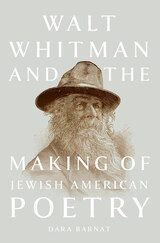 Walt Whitman and the Making of Jewish American Poetry
Dara Barnat
University of Iowa Press, 2023 Walt Whitman has served as a crucial figure within the tradition of Jewish American poetry. But how did Whitman, a non-Jewish, American-born poet, become so instrumental in this area of poetry, especially for poets whose parents, and often they themselves, were not “born here?”
Dara Barnat presents a genealogy of Jewish American poets in dialogue with Whitman, and with each other, and reveals how the lineage of Jewish American poets responding to Whitman extends far beyond the likes of Allen Ginsberg. From Emma Lazarus and Adah Isaacs Menken, through twentieth-century poets such as Charles Reznikoff, Karl Shapiro, Kenneth Koch, Muriel Rukeyser, Adrienne Rich, Marge Piercy, Alicia Suskin Ostriker, and Gerald Stern, this book demonstrates that Whitman has been adopted by Jewish American poets as a liberal symbol against exclusionary and anti-Semitic elements in high modernist literary culture. The turn to Whitman serves as a mode of exploring Jewish and American identity.
Walt Whitman and the World
Gay Wilson Allen
University of Iowa Press, 1995 Celebrating the various ethnic traditions that melded to create what we now call American literature, Whitman did his best to encourage an international reaction to his work. But even he would have been startled by the multitude of ways in which his call has been answered. By tracking this wholehearted international response and reconceptualizing American literature, Walt Whitman and the World demonstrates how various cultures have appropriated an American writer who ceases to sound quite so narrowly American when he is read into other cultures' traditions.
 Walt Whitman Bathing: POEMS
David Wagoner
University of Illinois Press, 1996 When David Wagoner's last collection, Through the Forest: New and Selected Poems, was published, Harold Bloom noted that Wagoner's "study of American nostalgias is as eloquent and moving as that of James Wright, and like Wright's poetry carries on some of the deepest currents in American verse." The same could be said of Walt Whitman Bathing, in which Wagoner's poems range from the lyric to the satiric, the elegiac to the transcendental, the autobiographical to the visionary. Other comments on Wagoner's earlier works: "Wagoner has the visual acuity of his loved hawks and a lifelong absorption with living and growing things. A lovely wit and a lively intelligence inform these poems." -- Maxine Kumin
"When Wagoner looks at something, he brings it to vivid and immediate life through an extraordinary power with a simple name: love. He is as formally various as Thomas Hardy, as playful as Dickinson, as wry as Frost." -- Dave Smith
"A sharp-eyed, even gutsy nature poet, the deftest and tenderest of love poets, Wagoner is a verbal magician capable of surprising, sometimes crazy tours de force."-- X. J. Kennedy
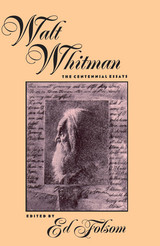 Walt Whitman: The Centennial Essays
Ed Folsom
University of Iowa Press, 1994 In 1992, the year of the hundredth anniversary of Walt Whitman's death, a major gathering of international scholars took place at the University of Iowa. Over 150 participants heard papers by 20 of the world's most eminent critics of Whitman. Three generations of scholars offered new essays that brilliantly tracked the course of past and present Whitman scholarship. So significant was this historic celebration of the great American poet that the opening session was covered by CBS “Sunday Morning,” National Public Radio's “Morning Edition,” the New York Times, and other newspapers across the country. Musical and theatrical performances, art exhibitions, slide shows, readings, songs, and even a recently discovered recording of Whitman's voice were presented during the three days of the conference. But the heart of the conference was this series of original essays by some of the most innovative scholars working in the field of American literature. There has ever been a more important collection of Whitman criticism. In these essays, readers will find the most suggestive recent approaches to Whitman alongside the most reliable traditional approaches. Walt Whitman: The Centennial Essays captures Whitman's energy and vitality, which have only increased in the century after his death.
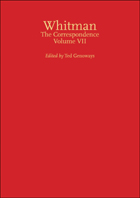 Walt Whitman: The Correspondence, Volume VII
Ted Genoways
University of Iowa Press, 2005 In 1961 the first volume of Edwin Haviland Miller’s The Correspondence was published in the newly established series the Collected Writings of Walt Whitman. Miller proceeded to publish five additional volumes of Whitman letters, and other leading scholars, including Roger Asselineau, compiled accompanying volumes of prose, poems, and daybooks. Yet by the late 1980s, the Whitman Collected Writings project was hopelessly scattered, fragmented, and incomplete.
Now, more than forty years after the inaugural volume’s original publication, Ted Genoways brings scholars the latest volume in Walt Whitman: The Correspondence. Incorporating all of the letters Miller had collected before his death in 2001 and combining them with more than a hundred previously unknown letters he himself gathered, Genoways’s volume is a perfect accompaniment to Miller’s original work.
Among the more than one hundred fifty letters collected in this volume are numerous correspondences concerning Whitman’s Civil War years, including a letter sending John Hay, the personal secretary to Abraham Lincoln, a manuscript copy of “O Captain, My Captain!” Additional letters address various aspects of the production of Leaves of Grass, the most notable being an extensive correspondence surrounding the Deathbed Edition, gathered by Whitman’s friend Horace Traubel, and reproduced here for the first time. Most significantly, this volume at last incorporates Whitman’s early letters to Abraham Paul Leech, first published by Arthur Golden in American Literature in 1986. The revelations contained in these letters must be considered among the most important discoveries about Whitman’s life made during the last half of the twentieth century.
Regardless of whether their significance is great or small, immediate or long-term, each new piece of Whitman’s correspondence returns us to a particular moment in his life and suggests the limitless directions that remain for Whitman scholarship.
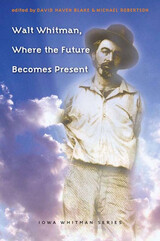 Walt Whitman, Where the Future Becomes Present
David Haven Blake
University of Iowa Press, 2008 Whitman’s poetry is full of places where he directly addresses his future readers, acknowledges the time span between them, then shrugs it off. “The greatest poet,” he writes in his preface to Leaves of Grass, “places himself where the future becomes present.” By celebrating the complex legacy of Leaves of Grass, the ten essayists in this spirited collection affirm the truth of its premise: “Past and present and future are not disjoined but joined.”
Walt Whitman, Where the Future Becomes Present invigorates Whitman studies by garnering insights from a diverse group of writers and intellectuals. Writing from the perspectives of art history, political theory, creative writing, and literary criticism, the contributors place Whitman in the center of both world literature and American public life. The volume is especially notable for being the best example yet published of what the editors call the New Textuality in Whitman studies, an emergent mode of criticism that focuses on the different editions of Whitman’s poems as independent works of art.
Written one hundred fifty years after the book’s publication, these timely, innovative responses to Leaves of Grass confirm that the future of Whitman’s poems is vital to our present.
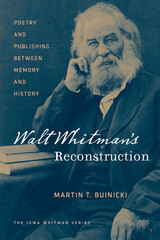 Walt Whitman's Reconstruction: Poetry and Publishing between Memory and History
Martin T. Buinicki
University of Iowa Press, 2012 For Walt Whitman, living and working in Washington, D.C., after the Civil War, Reconstruction meant not only navigating these tumultuous years alongside his fellow citizens but also coming to terms with his own memories of the war. Just as the work of national reconstruction would continue long past its official end in 1877, Whitman’s own reconstruction would continue throughout the remainder of his life as he worked to revise his poetic project—and his public image—to incorporate the disasters that had befallen the Union. In this innovative and insightful analysis of the considerable poetic and personal reimagining that is the hallmark of these postwar years, Martin Buinicki reveals the ways that Whitman reconstructed and read the war. The Reconstruction years would see Whitman transformed from newspaper editor and staff journalist to celebrity contributor and nationally recognized public lecturer, a transformation driven as much by material developments in the nation as by his own professional and poetic ambitions while he expanded and cemented his place in the American literary landscape. Buinicki places Whitman’s postwar periodical publications and business interests in context, closely examining his “By the Roadside” cluster as well as MemorandaDuring the War and Specimen Days as part of his larger project of personal and artistic reintegration. He traces Whitman’s shifting views of Ulysses S. Grant as yet another way to understand the poet’s postwar life and profession and reveals the emergence of Whitman the public historian at the end of Reconstruction. Whitman’s personal reconstruction was political, poetic, and public, and his prose writings, like his poetry, formed a major part of the postwar figure that he presented to the nation. Looking at the poet’s efforts to absorb the war into his own reconstruction narrative, Martin Buinicki provides striking new insights into the evolution of Whitman’s views and writings.
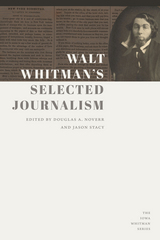 Walt Whitman's Selected Journalism
Walt Whitman
University of Iowa Press, 2015 Long before he was a celebrated poet, Walt Whitman was a working journalist. By the time he published the first edition of Leaves of Grass in 1855, Whitman had edited three newspapers and published thousands of reviews, editorials, and human-interest stories in newspapers in and around New York City. Yet for decades, much of his journalism has been difficult to access or even find. For the first time, Walt Whitman’s Selected Journalism thematically and chronologically organizes a compelling selection of Whitman’s journalism from the late 1830s to the Civil War. It includes writings from the poet’s first immersion into the burgeoning democratic culture of antebellum America to the war that transformed both the poet and the nation.
Walt Whitman’s Selected Journalism covers Whitman’s early years as a part-time editorialist and ambivalent schoolteacher between 1838 and 1841. After 1841, it follows his work as a dedicated full-time newspaperman and editor, most prominently at the New York Aurora and the Brooklyn Daily Eagle between 1842 and 1848. After 1848 and up to the Civil War, Whitman’s journalism shows his slow transformation from daily newspaper editor to poet. This volume gathers journalism from throughout these early years in his career, focusing on reporting, reviews, and editorials on politics and democratic culture, the arts, and the social debates of his day. It also includes some of Whitman’s best early reportage, in the form of the short, personal pieces he wrote that aimed to give his readers a sense of immediacy of experience as he guided them through various aspects of daily life in America’s largest metropolis.
Over time, journalism’s limitations pushed Whitman to seek another medium to capture and describe the world and the experience of America with words. In this light, today’s readers of Whitman are doubly indebted to his career in journalism. In presenting Whitman-the-journalist in his own words here, and with useful context and annotations by renowned scholars, Walt Whitman’s Selected Journalism illuminates for readers the future poet’s earliest attempts to speak on behalf of and to the entire American republic.
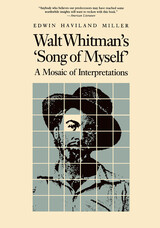 Walt Whitman's "Song of Myself": A Mosaic of Interpretations
Edwin Haviland Miller
University of Iowa Press, 1991 Walt Whitman's "Song of Myself" is a remarkable encyclopedia of how Whitman's greatest poem has been received by critics and poets since its appearance in 1855. From the beginning the poem has posed difficulties for readers because of the absence of rhyme, the free meter, the startling introduction of nonpoetic diction and erotic materials, and the richness and subtlety of a poet who ventured into new poetic territory in his effort to establish himself as the first bard of the democracy. Integrating the diverse views of approximately three hundred scholars, this volume does for Whitman what has been done for Shakespeare and others in variorum editions. Future readers and interpreters will now have easy access to an elaborate commentary upon which all subsequent interpretations will of necessity draw. Included in this edition is a complete facsimile of the 1855 edition of the poem, followed by an analysis of the work from section to section. An introduction reviews the background of the poem and its commentary, presenting detailed discussions of the many attempts to establish the structure of this seemingly formless poem. Also included are an appendix describing Whitman's catalogs and a bibliography of all the significant discussions of "Song of Myself" over the past 130 years. This highly useful book is destined to be the standard reference work for everyone concerned with Whitman's poetry.
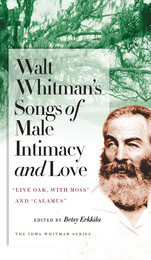 Walt Whitman's Songs of Male Intimacy and Love: "Live Oak, with Moss" and "Calamus"
Whitman, Walt
University of Iowa Press, 2011 In his 1859 “Live Oak, with Moss,” Walt Whitman’s unpublished sheaf of twelve poems on manly passion, the poet dreams of a city where men who love men can live and love openly. The revised “Live Oak, with Moss” poems became “Calamus,” Whitman’s cluster of poems on “adhesive” and manly love, comradeship, and democracy, in Leaves of Grass. Commemorating both the first publication of the “Calamus” poems and the little-known manuscript of notebook poems out of which the “Calamus” cluster grew, Whitman scholar Betsy Erkkila brings together in a single edition for the first time the “Live Oak, with Moss” poems, the 1860 “Calamus” poems, and the final 1881 “Calamus” poems. In addition to honoring the sesquicentennial of the “Calamus” cluster, she celebrates the ongoing legacy of Whitman’s songs of manly passion, sex, and love. The volume begins with Whitman’s elegantly handwritten manuscript of the “Live Oak, with Moss” poems, printed side by side with a typeset transcription and followed by a facsimile of the 1860 version of the “Calamus” poems. The concluding section reprints the final version of the “Calamus” poems from the 1881 edition of Leaves of Grass. In an afterword, Erkkila discusses the radical nature of these poems in literary, sexual, and social history; the changes Whitman made in the “Live Oak” and “Calamus” poems in the post–Civil War and Reconstruction years; the literary, political, and other contests surrounding the poems; and the constitutive role the poems have played in the emergence of modern heterosexual and homosexual identity in the United States and worldwide. The volume closes with a selected bibliography of works that have contributed to the critical and interpretive struggles around Whitman’s man-loving life. One hundred and fifty years after Whitman’s brave decision to speak publicly about a fully realized democracy, his country is still locked in a struggle over the rights of homosexuals. These public battles have been at the very center of controversies over the life, work, and legacy of Walt Whitman, America’s (and the world’s) major poet of democracy and its major singer of what he called “manly love” in all its moods. Together the poems in this omnibus volume affirm his creation of a radical new language designed to convey and affirm the poet’s man love.
 Walt Whitman's Workshop: A Collection of Unpublished Manuscripts
Walt Whitman
Harvard University Press Recent study of Whitman manuscripts has disclosed a number of significant unpublished documents, portions of which are presented in this book to afford opportunity for a first hand study of Whitman’s ideas and working methods. There are selections from manuscripts for public lectures; passages from notes and diaries revealing his attitude toward the abolitionist movement, presidential campaigns, and other historical and political matters; lost drafts of prefaces intended for American editions of “Leaves of Grass”; an introduction for a proposed English edition of his works; and finally, a number of letters and prefaces prepared for foreign editions and translations of his works which were projected but never published. This large body of material is of unique and first rate importance. The introduction and notes aim to throw light upon the history and interpretation of the material, but not to interfere in any way with allowing Walt Whitman to speak for himself.
 Walter B. Cannon, Science and Society
Elin L. Wolfe, A. Clifford Barger, and Saul Benison
Harvard University Press, 2000 This second volume completes the story begun in Walter B. Cannon: The Life and Times of a Young Scientist (Belknap Press, 1987), tracing the middle and late years of one of America’s most distinguished medical scientists.
It resumes during World War II with Cannon’s battlefield work on traumatic shock in England and France, and follows him to Harvard Medical School as he investigated the workings of the sympathetic division of the autonomic nervous system, reaffirmed his emergency theory of the sympathico-adrenal system, and developed his now-famous concept of homeostasis and pioneer contributions to the newly emerging field of neuroendocrinology. This volume also recounts Cannon’s work with society on a broader scale, including defending the practice of animal experimentation, the rescue of European medical émigrés fleeing the Nazis and Fascists, and providing medical aid to the Spanish Loyalists and to China. Moreover, as a senior statesman of science, Cannon helped guide policies and programs that shaped the future of medical research, practice, and education.
 Walter Benjamin: A Critical Life
Howard Eiland and Michael Jennings
Harvard University Press, 2014 Walter Benjamin is one of the twentieth century's most important intellectuals, and also one of its most elusive. His writings—mosaics incorporating philosophy, literary criticism, Marxist analysis, and a syncretistic theology—defy simple categorization. And his mobile, often improvised existence has proven irresistible to mythologizers. His writing career moved from the brilliant esotericism of his early writings through his emergence as a central voice in Weimar culture and on to the exile years, with its pioneering studies of modern media and the rise of urban commodity capitalism in Paris. That career was played out amid some of the most catastrophic decades of modern European history: the horror of the First World War, the turbulence of the Weimar Republic, and the lengthening shadow of fascism. Now, a major new biography from two of the world's foremost Benjamin scholars reaches beyond the mosaic and the mythical to present this intriguing figure in full.
Howard Eiland and Michael Jennings make available for the first time a rich store of information which augments and corrects the record of an extraordinary life. They offer a comprehensive portrait of Benjamin and his times as well as extensive commentaries on his major works, including "The Work of Art in the Age of Its Technological Reproducibility," the essays on Baudelaire, and the great study of the German Trauerspiel. Sure to become the standard reference biography of this seminal thinker, Walter Benjamin: A Critical Life will prove a source of inexhaustible interest for Benjamin scholars and novices alike.
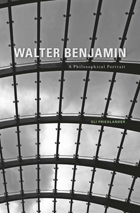 Walter Benjamin: A Philosophical Portrait
Eli Friedlander
Harvard University Press, 2012 Walter Benjamin is often viewed as a cultural critic who produced a vast array of brilliant and idiosyncratic pieces of writing with little more to unify them than the feeling that they all bear the stamp of his "unclassifiable" genius. Eli Friedlander argues that Walter Benjamin's corpus of writings must be recognized as a unique configuration of philosophy with an overarching coherence and a deep-seated commitment to engage the philosophical tradition.
Friedlander finds in Benjamin's early works initial formulations of the different dimensions of his philosophical thinking. He leads through them to Benjamin's views on the dialectical image, the nature of language, the relation of beauty and truth, embodiment, dream and historical awakening, myth and history, as well as the afterlife and realization of meaning. Those notions are articulated both in themselves and in relation to central figures of the philosophical tradition. They are further viewed as leading to and coming together in The Arcades Project. Friedlander takes that incomplete work to be the central theater where these earlier philosophical preoccupations were to be played out. Benjamin envisaged in it the possibility of the highest order of thought taking the form of writing whose contents are the concrete time-bound particularities of human experience. Addressing the question of the possibility of such a presentation of philosophical truth provides the guiding thread for constellating the disparate moments of Benjamin's writings.
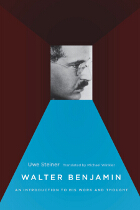 Walter Benjamin: An Introduction to His Work and Thought
Uwe Steiner
University of Chicago Press, 2010 Seven decades after his death, German Jewish writer, philosopher, and literary critic Walter Benjamin (1892–1940) continues to fascinate and influence. Here Uwe Steiner offers a comprehensive and sophisticated introduction to the oeuvre of this intriguing theorist.
Acknowledged only by a small circle of intellectuals during his lifetime, Benjamin is now a major figure whose work is essential to an understanding of modernity. Steiner traces the development of Benjamin’s thought chronologically through his writings on philosophy, literature, history, politics, the media, art, photography, cinema, technology, and theology. Walter Benjamin reveals the essential coherence of its subject’s thinking while also analyzing the controversial or puzzling facets of Benjamin’s work. That coherence, Steiner contends, can best be appreciated by placing Benjamin in his proper context as a member of the German philosophical tradition and a participant in contemporary intellectual debates.
As Benjamin’s writing attracts more and more readers in the English-speaking world, Walter Benjamin will be a valuable guide to this fascinating body of work.
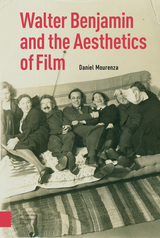 Walter Benjamin and the Aesthetics of Film
Daniel Mourenza
Amsterdam University Press, 2020 Walter Benjamin is today regarded as one of the leading thinkers of the twentieth century. Often captured in pensive pose, his image is now that of a serious intellectual. But Benjamin was also a fan of the comedies of Adolphe Menjou, Mickey Mouse, and Charlie Chaplin. As an antidote to repressive civilization, he developed, through these figures, a theory of laughter. Walter Benjamin and the Aesthetics of Film is the first monograph to thoroughly analyse Benjamin’s film writings, contextualizing them within his oeuvre whilst also paying attention to the various films, actors, and directors that sparked his interest. The book situates all these writings within Benjamin’s ‘anthropological materialism’, a concept that analyses the transformations of the human sensorium through technology. Through the term ‘innervation’, Benjamin thought of film spectatorship as an empowering reception that, through a rush of energy, would form a collective body within the audience, interpenetrating a liberated technology into the distracted spectators. Benjamin’s writings on Soviet film and German cinema, Charlie Chaplin, and Mickey Mouse are analysed in relation to this posthuman constellation that Benjamin had started to dream of in the early twenties, long before he began to theorize about films.
 Walter Benjamin for Children: An Essay on his Radio Years
Jeffrey Mehlman
University of Chicago Press, 1993 In light of the legendary difficulty of Walter Benjamin's works, it is a strange and intriguing fact that from 1929 to 1933 the great critic and cultural theorist wrote—and broadcast—numerous scripts, on the order of fireside chats, for children. Invited to speak on whatever subject he considered appropriate, Benjamin talked to the children of Frankfurt and Berlin about the destruction of Pompeii, an earthquake in Lisbon, and a railroad disaster at the Firth of Tay. He spoke about bootlegging and swindling, cataclysm and suicide, Faust and Cagliostro. In this first sustained analysis of the thirty surviving scripts, Jeffrey Mehlman demonstrates how Benjamin used the unlikely forum of children's radio to pursue some of his central philosophical and theological concerns. In Walter Benjamin for Children , readers will encounter a host of intertextual surprises: an evocation of the flooding of the Mississippi informed by the argument of "The Task of the Translator;" a discussion of scams in stamp-collecting that turns into "The Work of Art in the Age of Mechanical Reproduction;" a tale of bootlegging in the American South that converges with the best of Benjamin's essays on fiction. Mehlman superimposes a dual series of texts dealing with catastrophe, on the one hand, and fraud, on the other, that resonate with the false-messianic theology of Sabbatianism as it came to focus the attention and enthusiasm of Benjamin's friend Gershom Scholem during the same years. The radio scripts for children, that is, offer an unexpected byway, on the eve of the apocalypse, into Benjamin's messianic preoccupations. A child's garden of deconstruction, these twenty-minute talks—from the perspective of childhood, before an invisible audience, on whatever happened to cross the critic's mind—are also by their very nature the closest we may ever come to a transcript of a psychoanalysis of Walter Benjamin. Particularly alive to that circumstance, Mehlman explores the themes of the radio broadcasts and brilliantly illuminates their hidden connections to Benjamin's life and work. This lucid analysis brings to light some of the least researched and understood aspects of Walter Benjamin's thought. It will interest and provoke literary theorists and philosophers of culture, as well as anyone who hopes to understand one of this century's most suggestive and perplexing critics.
 Walter Benjamin: Selected Writings
Translated by Edmund Jephcott, Howard Eiland, and OthersEdited by Howard Eiland and Michael W. Jennings
Harvard University Press, 1996 Radical critic of a European civilization plunging into darkness, yet commemorator of the humane traditions of the old bourgeoisie--such was Walter Benjamin in the later 1930s. This volume, the third in a four-volume set, offers twenty-seven brilliant pieces, nineteen of which have never before been translated.
The centerpiece, A Berlin Childhood around 1900, marks the first appearance in English of one of the greatest German works of the twentieth century: a profound and beautiful account of the vanished world of Benjamin's privileged boyhood, recollected in exile. No less remarkable are the previously untranslated second version of Benjamin's most famous essay, "The Work of Art in the Age of Its Technological Reproducibility," with its striking insights into the relations between technology and aesthetics, and German Men and Women, a book in which Benjamin collects twenty-six letters by distinguished Germans from 1783 to 1883 in an effort to preserve what he called the true humanity of German tradition from the debasement of fascism.
Volume 3 also offers extensively annotated translations of essays that are key to Benjamin's rewriting of the story of modernism and modernity--such as "The Storyteller" and "Paris, the Capital of the Nineteenth Century"--as well as a fascinating diary from 1938 and penetrating studies of Bertolt Brecht, Franz Kafka, and Eduard Fuchs. A narrative chronology details Benjamin's life during these four harrowing years of his exile in France and Denmark. This is an essential collection for anyone interested in his work.
 Walter Benjamin: Selected Writings
Walter Benjamin
Harvard University Press, 1996 "Every line we succeed in publishing today...is a victory wrested from the powers of darkness." So wrote Walter Benjamin in January 1940. Not long afterward, he himself would fall prey to those powers, a victim of suicide following a failed attempt to flee the Nazis. However insistently the idea of catastrophe hangs over Benjamin's writings in the final years of his life, the "victories wrested" in this period nonetheless constitute some of the most remarkable twentieth-century analyses of the emergence of modern society. The essays on Charles Baudelaire are the distillation of a lifetime of thinking about the nature of modernity. They record the crisis of meaning experienced by a civilization sliding into the abyss, even as they testify to Benjamin's own faith in the written word.
This volume ranges from studies of Baudelaire, Brecht, and the historian Carl Jochmann to appraisals of photography, film, and poetry. At their core is the question of how art can survive and thrive in a tumultuous time. Here we see Benjamin laying out an ethic for the critic and artist--a subdued but resilient heroism. At the same time, he was setting forth a sociohistorical account of how art adapts in an age of violence and repression.
Working at the height of his powers to the very end, Benjamin refined his theory of the mass media that culminated in the final version of his essay "The Work of Art in the Age of Its Technological Reproducibility." Also included in this volume is his influential piece "On the Concept of History," completed just before his death. The book is remarkable for its inquiry into the nature of "the modern" (especially as revealed in Baudelaire), for its ideas about the transmogrification of art and the radical discontinuities of history, and for its examples of humane life and thought in the midst of barbarism. The entire collection is eloquent testimony to the indomitable spirit of humanity under siege.
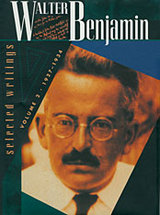 Walter Benjamin: Selected Writings
Translated by Rodney Livingstone and OthersEdited by Michael W. Jennings, Howard Eiland, and Gary Smith
Harvard University Press, 1996 In the frenzied final years of the Weimar Republic, amid economic collapse and mourning political catastrophe, Walter Benjamin emerged as the most original practicing literary critic and public intellectual in the German-speaking world. Volume 2 of Selected Writings, covering the years 1927 to 1934, displays the full spectrum of Benjamin's achievements at this pivotal stage in his career.
Previously concerned chiefly with literary theory, Benjamin during these Years does pioneering work in new areas, from the stud of popular Culture (a discipline he virtually created) to theories of the media and the visual arts. His writings on the theory of modernity-most of them new to readers of English--develop ideas as important to an understanding of the twentieth century as an contained in his widely anthologiied essay "The Work of Art in the Age of Technological Reproducibility.
This volume brings together previously untranslated writings on major figures such as Brecht, Valéry and Gide, and on subjects ranging from film, radio, and the novel to memory, kitsch, and the theory of language. We find the manifoldly inquisitive Benjamin musing on the new modes of perception opened tip by techniques of photographic enlargement and cinematic montage, on the life and work of & Goethe at Weimar, on the fascination of old toys and the mysteries of food, and on the allegorical significance of Mickey Mouse.
 Walter Benjamin: Selected Writings
Walter Benjamin
Harvard University Press, 1996 Walter Benjamin was one of the most original and important critical voices of the twentieth century, but until now only a few of his writings have been available in English. Harvard University Press has now undertaken to publish a significant portion of his work in definitive translation, under the general editorship of Michael W. Jennings. This volume, the first of three, will at last give readers of English a true sense of the man and the many facets of his thought. (The magnum opus of Benjamin’s Paris years, The Arcades Project, has been published in a separate volume.)Walter Benjamin emerged from the head-on collision of an idealistic youth movement and the First World War, which Benjamin and his close friends thought immoral. He walked away from the wreck scarred yet determined “to be considered as the principal critic of German literature.” But the scene, as he found it, was dominated by “talented fakes,” so—to use his words—“only a terrorist campaign would I suffice” to effect radical change. This book offers the record of the first phase of that campaign, culminating with “One Way Street,” one of the most significant products of the German avant-garde of the Twenties. Against conformism, homogeneity, and gentrification of all life into a new world order, Benjamin made the word his sword.Volume I of the Selected Writings brings together essays long and short, academic treatises, reviews, fragments, and privately circulated pronouncements. Fully five-sixths of this material has never before been translated into English. The contents begin in 1913, when Benjamin, as an undergraduate in imperial Germany, was president of a radical youth group, and take us through 1926, when he had already begun, with his explorations of the world of mass culture, to emerge as a critical voice in Weimar Germany’s most influential journals.The volume includes a number of his most important works, including “Two Poems by Friedrich Hölderlin,” “Goethe’s Elective Affinities,” “The Concept of Criticism in German Romanticism,” “The Task of the Translator,” and “One Way Street.” He is as compelling and insightful when musing on riddles or children’s books as he is when dealing with weightier issues such as the philosophy of language, symbolic logic, or epistemology. We meet Benjamin the youthful idealist, the sober moralist, the political theorist, the experimentalist, the translator, and, above all, the virtual king of criticism, with his magisterial exposition of the basic problems of aesthetics.Benjamin’s sentences provoke us to return to them again and again, luring us as though with the promise of some final revelation that is always being postponed. He is by turns fierce and tender, melancholy and ebullient; he is at once classically rooted, even archaic, in his explorations of the human psyche and the world of things, and strikingly progressive in his attitude toward society and what he likes to call the organs of the collective (its architectures, fashions, signboards). Throughout, he displays a far-sighted urgency, judging the present on the basis of possible futures. And he is gifted with a keen sense of humor. Mysterious though he may sometimes be (his Latvian love, Asia Lacis, once described him as a visitor from another planet), Benjamin remains perhaps the most consistently surprising and challenging of critical writers.
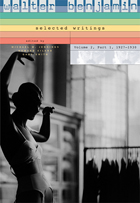 Walter Benjamin: Selected Writings
Translated by Rodney Livingstone and OthersEdited byMichael W. Jennings, Howard Eiland, and Gary Smith
Harvard University Press, 1999 In the frenzied final years of the Weimar Republic, amid economic collapse and mounting political catastrophe, Walter Benjamin emerged as the most original practicing literary critic and public intellectual in the German-speaking world. Volume 2 of the Selected Writings is now available in paperback in two parts.
In Part 1, Benjamin is represented by two of his greatest literary essays, "Surrealism" and "On the Image of Proust," as well as by a long article on Goethe and a generous selection of his wide-ranging commentary for Weimar Germany's newspapers.
Part 2 contains, in addition to the important longer essays, "Franz Kafka," "Karl Kraus," and "The Author as Producer," the extended autobiographical meditation "A Berlin Chronicle," and extended discussions of the history of photography and the social situation of the French writer, previously untranslated shorter pieces on such subjects as language and memory, theological criticism and literary history, astrology and the newspaper, and on such influential figures as Paul Valery, Stefan George, Hitler, and Mickey Mouse.
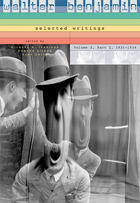 Walter Benjamin: Selected Writings
Translated by Rodney Livingstone and othersEdited by Michael W. Jennings, Howard Eiland, and Gary Smith
Harvard University Press, 2000 In the frenzied final years of the Weimar Republic, amid economic collapse and mounting political catastrophe, Walter Benjamin emerged as the most original practicing literary critic and public intellectual in the German-speaking world. Volume 2 of the Selected Writings is now available in paperback in two parts.
In Part 1, Benjamin is represented by two of his greatest literary essays, "Surrealism" and "On the Image of Proust," as well as by a long article on Goethe and a generous selection of his wide-ranging commentary for Weimar Germany's newspapers.
Part 2 contains, in addition to the important longer essays, "Franz Kafka," "Karl Kraus," and "The Author as Producer," the extended autobiographical meditation "A Berlin Chronicle," and extended discussions of the history of photography and the social situation of the French writer, previously untranslated shorter pieces on such subjects as language and memory, theological criticism and literary history, astrology and the newspaper, and on such influential figures as Paul Valery, Stefan George, Hitler, and Mickey Mouse.
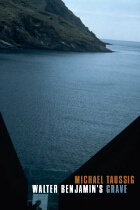 Walter Benjamin's Grave
Michael Taussig
University of Chicago Press, 2006 In September 1940, Walter Benjamin committed suicide in Port Bou on the Spanish-French border when it appeared that he and his travelling partners would be denied passage into Spain in their attempt to escape the Nazis. In 2002, one of anthropology’s—and indeed today’s—most distinctive writers, Michael Taussig, visited Benjamin’s grave in Port Bou. The result is “Walter Benjamin’s Grave,” a moving essay about the cemetery, eyewitness accounts of Benjamin’s border travails, and the circumstances of his demise. It is the most recent of eight revelatory essays collected in this volume of the same name.
“Looking over these essays written over the past decade,” writes Taussig, “I think what they share is a love of muted and defective storytelling as a form of analysis. Strange love indeed; love of the wound, love of the last gasp.” Although thematically these essays run the gamut—covering the monument and graveyard at Port Bou, discussions of peasant poetry in Colombia, a pact with the devil, the peculiarities of a shaman’s body, transgression, the disappearance of the sea, New York City cops, and the relationship between flowers and violence—each shares Taussig’s highly individual brand of storytelling, one that depends on a deep appreciation of objects and things as a way to retrieve even deeper philosophical and anthropological meanings. Whether he finds himself in Australia, Colombia, Manhattan, or Spain, in the midst of a book or a beach, whether talking to friends or staring at a monument, Taussig makes clear through these marvelous essays that materialist knowledge offers a crucial alternative to the increasingly abstract, globalized, homogenized, and digitized world we inhabit.
Pursuing an adventure that is part ethnography, part autobiography, and part cultural criticism refracted through the object that is Walter Benjamin’s grave, Taussig, with this collection, provides his own literary memorial to the twentieth century’s greatest cultural critic.
 Walter Byers and the NCAA: Power, Amateurism, and Growing Controversy in Big-Time College Sport
Ronald A. Smith
University of Tennessee Press, 2025 Walter Byers, the first executive director of the NCAA, oversaw the organization’s transformation from a small rule-making body into a billion-dollar enterprise that wielded immense power over collegiate athletics. In Walter Byers and the NCAA, historian Ronald A. Smith delves into the complexities of Byers’s leadership during a period of great cultural and institutional change. Under Byers’s guidance, the NCAA navigated significant milestones, such as the racial integration of college sports and the passage of Title IX, which mandated gender equality in athletics. At the same time, the commercialization of college football and basketball during his tenure led to skyrocketing coaching salaries and television contracts, pushing the NCAA into a new, profit-driven era.
Smith provides a nuanced portrait of Byers, showing him as a man who remained committed to the ideal of the nonprofessional athlete, even as college athletics evolved around him. Yet Byers’s perspective shifted later in his career, as he began to question the fairness of this system. In his book, Unsportsmanlike Conduct, Byers publicly criticized the exploitation of student athletes, a stance that foreshadowed today’s debates about athletes’ rights and NIL compensation.
Smith's work not only offers an in-depth look at Byers’s role in the NCAA's expansion but also critiques the institution’s long-standing emphasis on amateurism. The book underscores how the tension between amateur ideals and the increasing commercialization and professionalization of college sports has persisted, both during and after Byers’s tenure. Ultimately, Smith provides a compelling study of one of the most influential and controversial figures in the history of American sports governance.
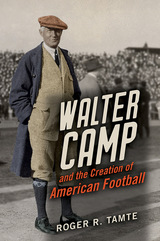 Walter Camp and the Creation of American Football
Roger R Tamte
University of Illinois Press, 2018 Walter Camp made the development of football—indeed, its very creation—his lifelong mission. From his days as a college athlete, Camp's love of the game and dedication to its future put it on the course that would allow it to seize the passions of the nation. Roger R. Tamte tells the engrossing but forgotten life story of Walter Camp, the man contemporaries called "the father of American football." He charts Camp's leadership as American players moved away from rugby and for the first time tells the story behind the remarkably inventive rule change that, in Camp's own words, was "more important than all the rest of the legislation combined." Trials also emerged, as when disputes over forward passing, the ten-yard first down, and other rules became so public that President Theodore Roosevelt took sides. The resulting political process produced losses for Camp as well as successes, but soon a consensus grew that football needed no new major changes. American football was on its way, but as time passed, Camp's name and defining influence became lost to history. Entertaining and exhaustively researched, Walter Camp and the Creation of American Football weaves the life story of an important sports pioneer with a long-overdue history of the dramatic events that produced the nation's most popular game.
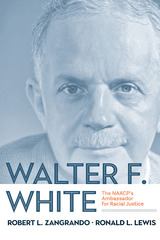 Walter F. White: The NAACP's Ambassador for Racial Justice
RONALD L. Zangrando, Robert L.
West Virginia University Press, 2018 Walter F. White of Atlanta, Georgia, joined the National Association for the Advancement of Colored People (NAACP) in 1918 as an assistant to Executive Secretary James Weldon Johnson. When Johnson retired in 1929, White replaced him as head of the NAACP, a position he maintained until his death in 1955. During his long tenure, White was in the vanguard of the struggle for interracial justice. His reputation went into decline, however, in the era of grassroots activism that followed his death. White’s disagreements with the US Left, and his ambiguous racial background—he was of mixed heritage, could “pass” as white, and divorced a black woman to marry a white woman—fueled ambivalence about his legacy. In this comprehensive biography, Zangrando and Lewis seek to provide a reassessment of White within the context of his own time, revising critical interpretations of his career. White was a promoter of and a participant in the Harlem Renaissance, a daily fixture in the halls of Congress lobbying for civil rights legislation, and a powerful figure with access to the administrations of Roosevelt (via Eleanor) and Truman. As executive secretary of the NAACP, White fought incessantly to desegregate the American military and pushed to ensure equal employment opportunities. On the international stage, White advocated for people of color in a decolonized world, and for economic development aid to nations like India and Haiti, bridging the civil rights struggles at home and abroad.
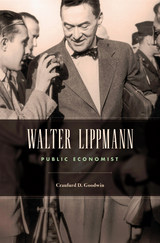 Walter Lippmann: Public Economist
Craufurd D. Goodwin
Harvard University Press, 2014 Walter Lippmann was the most distinguished American journalist and public philosopher of the twentieth century. But he was also something more: a public economist who helped millions of ordinary citizens make sense of the most devastating economic depression in history. Craufurd Goodwin offers a new perspective from which to view this celebrated but only partly understood icon of American letters.
From 1931 to 1946 Lippmann pursued a far-ranging correspondence with leading economic thinkers: John Maynard Keynes, Lionel Robbins, Friedrich Hayek, Henry Simons, Adolf Berle, Frank Taussig, and others. Sifting through their divergent views, Lippmann formed his own ideas about economic policy during the Great Depression and shared them with a vast readership in his syndicated column, Today and Tomorrow. Unemployment, monetary and fiscal policy, and the merits and drawbacks of free markets were just a few of the issues he helped explain to the public, at a time when professional economists who were also skilled at translating abstract concepts for a lay audience had yet to come on the scene.
After World War II Lippmann focused on foreign affairs but revisited economic policy when he saw threats to liberal democracy. In addition to pointing out the significance of the Marshall Plan and the World Bank, he addressed the emerging challenge of inflation and what he called “the riddle of the Sphinx”: whether price stability and full employment could be achieved in an economy with strong unions.
Walter Netsch: A Critical Appreciation and Sourcebook
Russell T. Northwestern University Library
Northwestern University Press, 2008 Northwestern University Library presents the first monograph devoted to the architect Walter Netsch, an early partner in Skidmore, Owings & Merrill and chief designer of prestigious commissions, including the U.S. Air Force Academy and Cadet Chapel. This illustrated book includes a detailed chronology, biography, essays about his work and field theory design aesthetics, statements by Netsch from 1954 to 2006, and a comprehensive, annotated bibliography of more than four hundred primary and secondary sources.
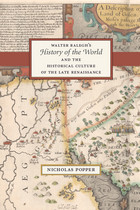 Walter Ralegh's "History of the World" and the Historical Culture of the Late Renaissance
Nicholas Popper
University of Chicago Press, 2012 Imprisoned in the Tower of London after the death of Queen Elizabeth in 1603, Sir Walter Ralegh spent seven years producing his massive History of the World. Created with the aid of a library of more than five hundred books that he was allowed to keep in his quarters, this incredible work of English vernacular would become a best seller, with nearly twenty editions, abridgments, and continuations issued in the years that followed.
Nicholas Popper uses Ralegh’s History as a touchstone in this lively exploration of the culture of history writing and historical thinking in the late Renaissance. From Popper we learn why early modern Europeans ascribed heightened value to the study of the past and how scholars and statesmen began to see historical expertise as not just a foundation for political practice and theory, but as a means of advancing their power in the courts and councils of contemporary Europe. The rise of historical scholarship during this period encouraged the circulation of its methods to other disciplines, transforming Europe’s intellectual—and political—regimes. More than a mere study of Ralegh’s History of the World, Popper’s book reveals how the methods that historians devised to illuminate the past structured the dynamics of early modernity in Europe and England.
Walter Reuther: THE MOST DANGEROUS MAN IN DETROIT
Nelson Lichtenstein
University of Illinois Press, 1995 Supported by The Walter and May Reuther Memorial Fund
Previously published by Basic Books as The Most Dangerous Man in Detroit: Walter Reuther and the Fate of American Labor
|
|



